- Terms of Use

War News | Military History | Military News
Top 10 wwii sites to visit in germany.
- World War 2
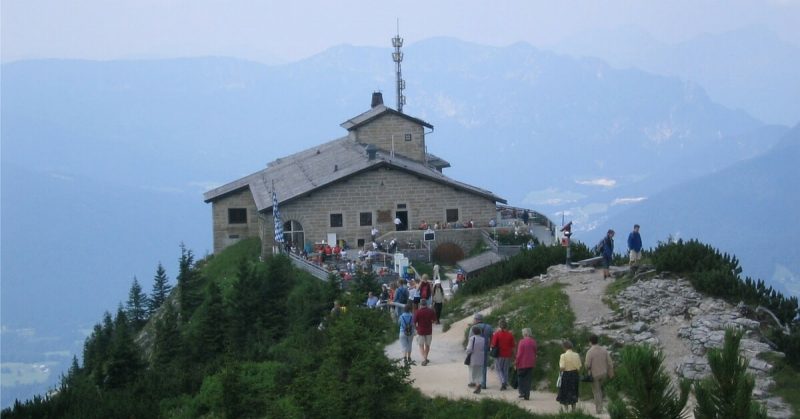
When planning to visit Germany, there are countless WWII locations from which to choose. To make planning easier for you, we have made a list of the 10 locations that we feel should be on your list.
We’ve tried to give you the full package that encompasses the entire history; from the birth of the Nazi ideology in Nuremberg and Munchen to its death in Berlin. We’ve covered everything from the development of the V-2 rockets to the Dachau concentration camp.
Party rally grounds, Nuremberg
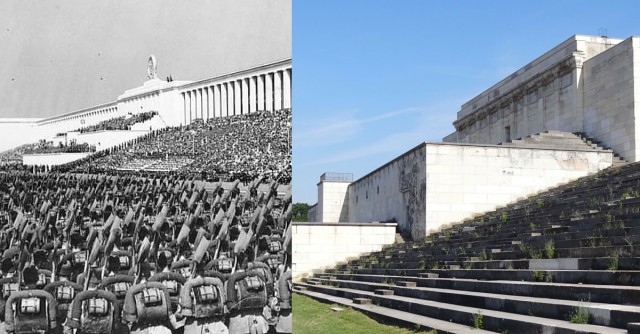
Hitler described Nuremberg as the ‘Heart of the Third Reich,’ so it makes sense that he would build the Nazis’ main rally ground around 11kms outside the city. Nuremberg is in Germany’s southwest, where Nazism grew from its modest beginnings to the party that took over the government.
The rally grounds are situated on six square miles. They include 24 towers and the balcony, known as the Zeppelin Tribune, where Hitler would stand to make speeches and address his party. In the arena, around 150,000 people could gather to salute their leader. The ground’s design was based on, but bigger than, the Colosseum in Rome.
Between 1933 and 1938 six Nazi rallies were held at the grounds. The sheer size and scale of the rallies were immense. The events were carefully planned and arranged so that they would portray an inspiring performance.
Since the end of the Second World War the German government, the Bavarian state, and the Nuremberg city authorities have all grappled with the challenge of what to do about these remaining infrastructures from the Nazi past
Visit information:
Address: Bayernstraße 110, 90478 Nürnberg, Germany Hours: 9AM–6PM Phone: +49 911 2317538
Wewelsburg Castle, Büren
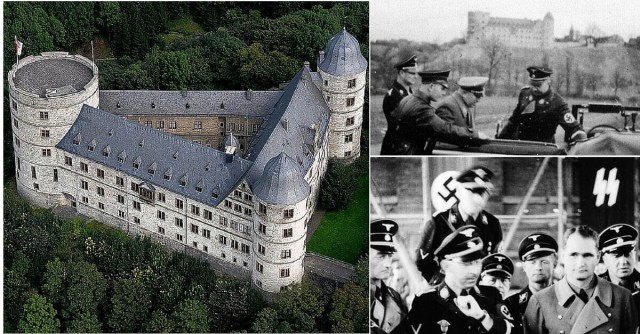
Wewelsburg Castle had served as Heinrich Himmler’s home and the SS’s headquarters throughout the Nazis’ reign in Germany. Heinrich Himmler, an ardent occult practitioner, and believer, he filled the castle with symbols that showed his fascination with the supernatural realm.
Significantly, its location is near what was then believed to be the site of the Battle of the Teutoburg Forest. Legend suggests that the castle held thousands of accused witches during the 17th century, who were tortured and executed within its walls.
Of course, no proof exists that Himmler wanted a Holy Grail castle, but the redesign of the castle by the SS referred to certain characters in the legends of the Grail: for example, one of the arranged study rooms was named Grail, and others, King Arthur, King Henry, Henry the Lion.
Address: Burgwall 19, 33142 Büren, Germany Hours: 10AM–5PM Phone: +49 2955 76220 Website: http://www.wewelsburg.de/en/
Fuhrerbunker, Berlin
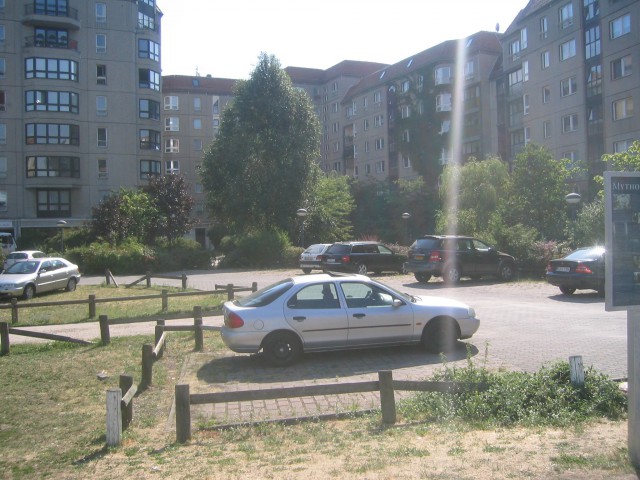
A parking lot now sits where Adolf Hitler’s Reich Chancellery once stood, in the center of Berlin. It is long gone thanks to Soviet troops liberating Berlin marking the end of World War II in Europe. But another infamous structure stood at this spot as well. There are no signs or commemorative placards of the building as many people have chosen to put the past behind them.
The present location of the infamous Fuhrerbunker, the location in which Hitler and his companion Eva Braun committed suicide is located beneath this parking lot with a sign stating the significance of the bunker under a patch of grass, of where Hitler spent his last month.
The Fuhrerbunker was originally intended as an air raid shelter, but as the war turned in favor of the allies, the shelter was extended into a much larger complex.
In 1947 the bunker’s ventilation towers were destroyed but other than that the complex was simply sealed off. Additional demolition occurred in 1959 but as the site was located close to the Berlin Wall, within the East Germany side of the Wall and was included in an area that was left mostly undeveloped and untouched.
It was not until the late 1980s that the East German administration began building on the site in an attempt to wipe out all trace of the past. Today, it is thought that there are still a few corridors to have survived but are sealed off from the public.
Address: In den Ministergärten, 10117 Berlin, Germany The Holocaust memorial is located nearby and should also be visited.
Berghof, Berchtesgaden
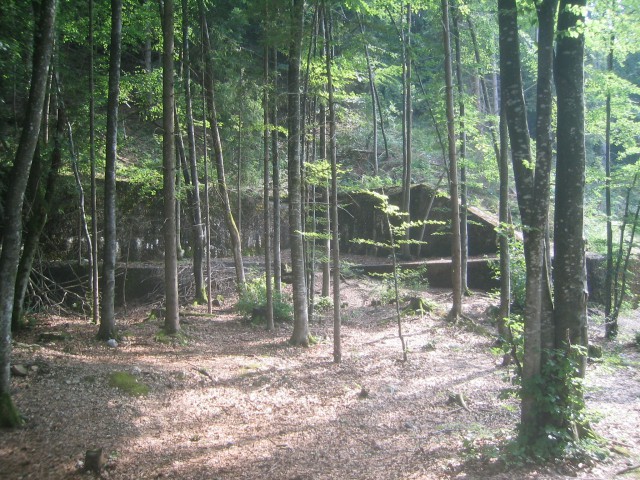
Hitler had always been attracted to the Obersaltzberg, the mountain overlooking Berchtesgaden. In the 1920s, he had rented a house there and in the 1930s he bought Haus Wachenfeld. This was rebuild into the Berghof in which he spent a large part of the war. Being close to Hitler was very important for the Nazi Party chiefs, and they moved into this area too, turning a lovely mountain into a Nazi powerhouse.
The Obersalzberg was bombed by hundreds of British Lancaster bombers on 25 April 1945, 12 days before the surrender of German forces on 7 May. At least two bombs struck the Berghof. On 4 May, four days after Hitler’s suicide in Berlin, departing SS troops set fire to the villa. Only hours later, the U.S. 3rd Infantry Division arrived at Berchtesgaden along with the French 2nd Armoured Division.
The ruined Berghof would remain in this state for seven years until it was finally blown up in 1952 the location was then used as to dump the remains of the other buildings . The garage remained standing until 1995. The ruins were further obliterated during the 1990s and early 2000s. By 2007, trees had overgrown the site and only scattered rubble, and the top of a retaining wall are still visible.
Address: Hintereck 2, 83471 Berchtesgaden, Germany
Eagles nest / Kehlsteinhaus, Berchtesgaden
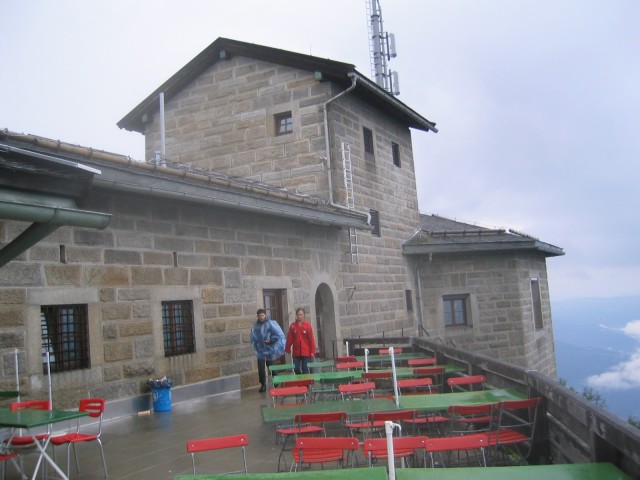
The Kehlsteinhaus or Eagles Nest as the allies called it, is situated on a ridge atop the Kehlstein mountain which towers above the town of Berchtesgaden. It was commissioned by Martin Bormann in the summer of 1937 as a 50th birthday gift for Adolf Hitler and was paid for by the Nazi Party. It was completed in just 13 months and an approach road had to be built which climbs 2,600 ft over 4.0 miles towards a car park near the top.
From a large car park, an entry tunnel leads to an ornate and previously gold-plated elevator which ascends the final 407 feet to the building. A massive red Italian marble fireplace, a gift from Benito Mussolini, dominates the building’s main reception room. It has been damaged by Allied soldiers who chipped off pieces of the marble to take home as souvenirs.
The building is now a restaurant which offers indoor dining and an outdoor beer garden. It is now a big tourist attraction with thousands of visitors ascending to the top every day admiring the same view that Hitler once enjoyed. Inside the Kehlsteinhouse are a number of information signs telling the story of how it was built and the use for the Nazi party.
Buses transport the tourists up to the parking lot, the road has been closed to private vehicles since 1952. There is also a footpath leading up, in about 3 hours you can walk up to the Eagles Nest and then enjoy a well deserved drink.
Address: Kehlsteinhaus, 83471 Berchtesgaden, Germany Open daily from May to September Website: http://www.kehlsteinhaus.de/en/
Dachau Concentration camp
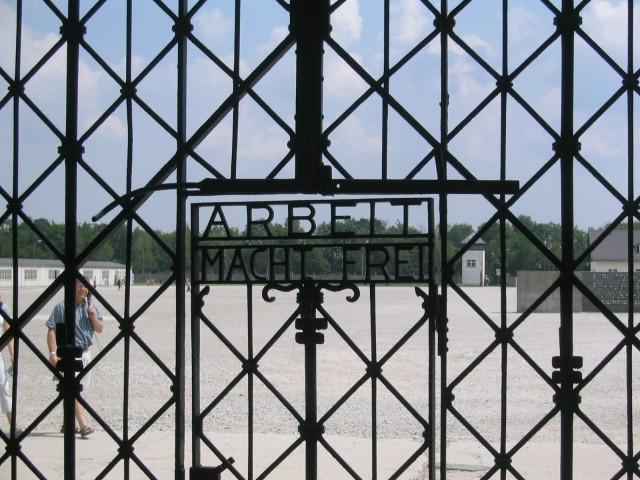
The infamous Nazi concentration camp in Dachau is found in the northeastern part of the town, and it has become an important tourist destination.
Immediately after successfully taking control of the reigns of the county in 1933, Adolf Hitler ordered to open the camp in Dachau. Dachau camp was the very first concentration camp in Europe and became a standard model for many others to follow including the infamous ‘Auschwitz.’
Over 200,000 prisoners have been locked up in Dachau from the foundation until its liberation in April 1945. 41,500 of this number died due to starvation, disease, and results of brutality.
In 1965 the Memorial Site on the grounds of the former concentration camp was established on the initiative of and in accordance with the plans of the surviving prisoners who had joined to form the Comité International de Dachau. The Bavarian state government provided financial support.
Address: Alte Römerstraße 75, 85221 Dachau, Germany Phone:+49 8131 669970 Hours: 9AM–5PM Website: https://www.kz-gedenkstaette-dachau.de/index-e.html
Peenemunde research facility
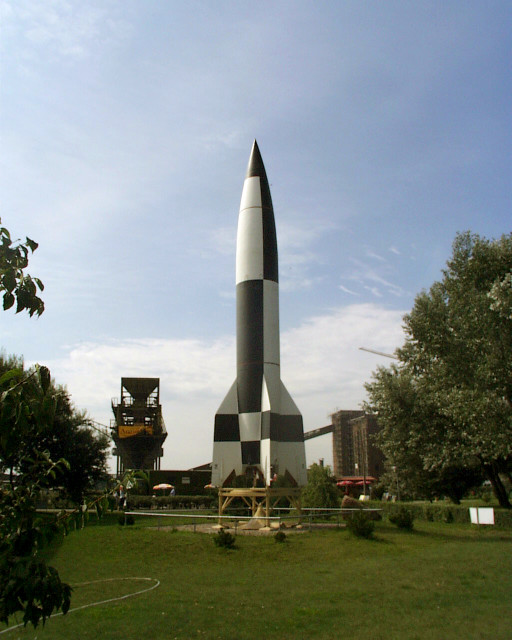
The Peenemünde Military Test Site established in 138 and it became one of the most modern technological facilities in the world. Several German guided missiles and rockets of World War II were developed and the first launch of a V-2 missile into space took place here in October 1942.
Engineers tested numerous flight objects equipped with revolutionary technology in the nearby air force testing area. The goal of the Peenemünde Military Test Site was simple and clear cut; achieve military superiority through advanced technology.
The construction of the test sites and the later serial production of the rockets was done by concentration camp inmates, prisoners of war and slave laborers. This vast pool of humans enabled the Nazis to get the V-2 into operational status is a very short period of time.
This came at a massive cost, inhumane living and labor conditions coupled with the frequent bombing of the test site by the Allies took a heavy toll, causing the death of countless humans.
The Peenemünde Historical Technical Museum is housed in the power station of the former Army Testing Site – the largest technical monument in the German state of Mecklenburg-Vorpommern. The Museum serves as an international meeting place and cultural venue. In 2002, the museum was awarded the Coventry Cross of Nails for its efforts toward reconciliation and world peace.
Historisch-Technisches Museum Peenemünde GmbH Address: Im Kraftwerk, 17449 Peenemünde, GERMANY Telephone: +49 38371 505 0 Website: http://www.peenemuende.de/en/
Hurtgenwald
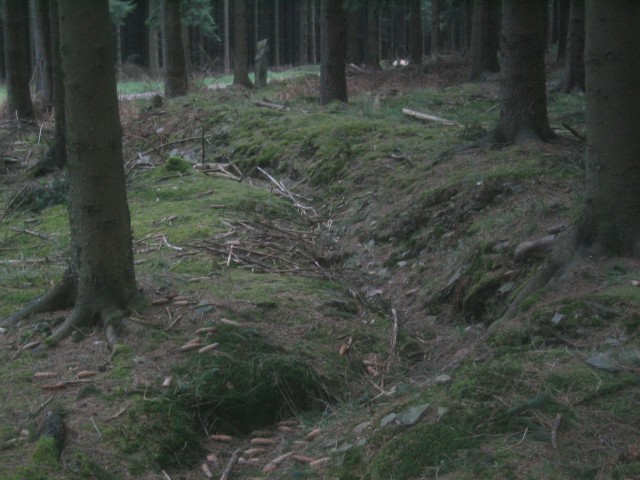
The Battle of Hürtgen Forest was the longest battle on German ground that was fought during the second world war, it lasted from 19 September 1944 to 10 February 1945. The U.S. First army tried to push through the forest and secure two Rur dams which, if opened, could sweep away an Allied bridgehead further downstream.
In 5 months of bitter fighting in the worst imaginable conditions, the U.S. First Army lost at least 33,000 killed and wounded, the German casualties were around 28,000.
Because there was no glory in the Hürtgen Forest, only death and destruction fighting an elusive and well-entrenched enemy in a damp, dark and muddy forest, the battle is largely forgotten. The Battle of the Bulge received far more media attention and ended in a glorious victory, thus it has overshadowed the Hurtgenwald ever since.
To remember the battle, the Museum of Hürtgen Forest 1944 and in Peacetime tells the story of this battle and its consequences for the local population. The museum is run by volunteers and almost all objects in the exhibition were collected in the Hürtgen Forest area after the war.
Nearby in the forest monuments, trenches, and demolished bunker can be visited.
Visit Information:
Address: Pfarrer-Dickmann-Str. 21-23, 52393 Hürtgenwald-Vossenack, Germany Hours: Sundays 11.00-17.00 (March-November) Phone: +492429 90 26 13 Website: http://www.museum-huertgenwald.de/
Königplatz, Munich
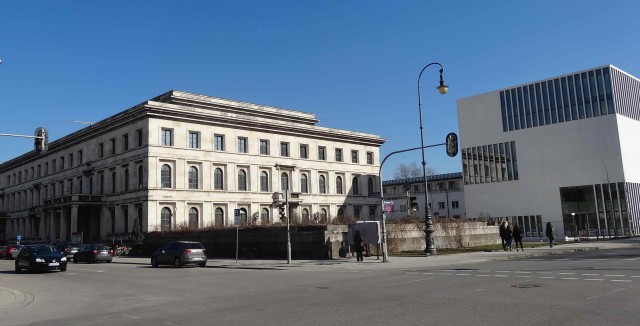
In the heart of Munchen lies a large square called the Königplatz, during the Third Reich it formed the administrative heart of the Nazi Party and mass rallies were held here. Located just off the Königplatz was the Brown House, where the National headquarters of the Nazi Party was located.
On the east side of the Königplatz the Nazis erected two Honor Temples in which they “enshrined” the remains of the sixteen Nazis that were killed in the 1923 Beer Hall Putsch. In 1947, the U.S Army demolished both temples and removed those buried there, but their platforms remain to this day.
Next to the temples, two buildings of the Nazi party constructed by Paul Troost still exist. In the Führerbau, visible on the photo above, the Munich Agreement was signed in 1938 and is now a school for music and theater.
On 1 May 2015, on the former location of the Braun Hause, the new Munich Documentation Centre for the History of National Socialism opened. It is as a place of education and remembrance documenting and addressing the crimes of the Nazi dictatorship and their origins, manifestations, and consequences right up to the present day.
Address: Königplatz, Munich, Germany Hours: Tuesday to Sunday 10 am – 7 pm Website: http://www.ns-dokuzentrum-muenchen.de/1/home/
Feldhernhalle, Munich
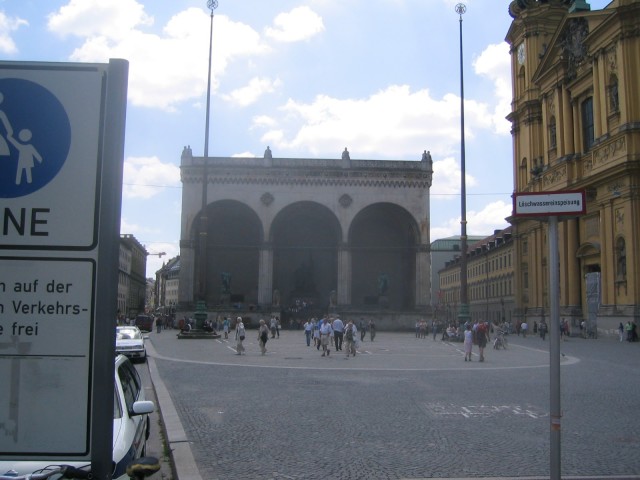
Close to the Königplatz, on the Odeonsplatz in Munich, the Feldherrnhalle is located. In 1841 it was commissioned by King Ludwig I of Bavaria to honor the tradition of his army.
It was at the Feldherrnhalle, or Field Marshals Halls, that on the morning of November 9th, 1923, Adolf Hitler’s “Beer Hall Putsch” came to a bloody end.
The Bavarian State Police halted the illegally organized march by the followers of Adolf Hitler here, which was the last desperate attempt to take over the Bavarian State.
The Nazi’s participation in the march were order to stop but continued so the State Police felt threatened and opened fire. Sixteen marchers and four policemen were killed in the ensuing gun battle.
Those that were killed were later moved to the honor temples on the Königplatz.
This meant the end of the Putsch and Hitler after which he was arrested and sentenced to a prison term in Landsberg prison.
When Hilter took over power in 1933 the Feldherrnhalle was turned into a memorial to the martyrs of the putsch. A monument, called the Mahnmal der Bewegung, was designed by Paul Ludwig Troost and placed opposite the location of the shootings. It listed all the names of the fallen SA men, which had been turned into Martyrs.
The SS had a ceremonial guard at the monument at all time and started using the Odeonsplatz for SS parades and commemorative rallies. During some of these rallies, the sixteen dead SA men were each commemorated by a temporary pillar placed in the Feldherrnhalle topped by a flame. New SS recruits took their oath of loyalty to Hitler in front of the memorial.
On 3 June 1945, local people spontaneously destroyed the Mahnmal der Bewegung, and the Feldherrnhalle was later restored to its pre-Nazi appearance.
Address: Odeonsplatz, Munchen, Germany
- Skip to primary navigation
- Skip to main content
- Skip to primary sidebar
- Skip to footer
TravelAwaits
Our mission is to serve the 50+ traveler who's ready to cross a few items off their bucket list.
11 Must-Visit Berlin WW2 Sites | Amazing Time-Travel Journey for the History Buffs

gary718 / Shutterstock
- Activities and Interests
- Destinations
- History and Culture
Note: The Travel Awaits team regularly updates content to provide the latest, and most accurate information to our readers. The updated content in this article may not reflect the views or opinions of the original author.
Tracing World War II history in Berlin can be a challenge. During the conflict, the city was extensively bombed, and by the time it was over, much of Berlin lay in rubble, including the Reichstag, the seat of the German government. Some places in Berlin that survived were later demolished, as the Soviets who occupied the city worked to erase or destroy anything connected with Germany and the Second World War. However, several World War II sites survived and are now open to visitors.
These World War II sites in Berlin carry the ghosts of World War II. They include memorials to those who suffered, restorations of Berlin treasures, and even bullet marks in a sculpture, but they all give a sense of the immense struggle that centered here in the dark days of the war.
Most of these highlights lie in central Berlin. You can see many of them in a day or two, either by walking or by hopping on a bus. Others are located just a short distance outside the city.

Sharon Odegaard
11 Must-Visit Berlin WW2 Sites | Journey Through Time for the History Buffs
For a quick summary of these top places to visit check out this slideshow or continue on and read to learn about each in more detail:
1. The Reichstag

The Reichstag in Berlin was once a symbol of power. Completed in 1894, it housed the government for several decades. In 1933, a famous fire destroyed part of the building shortly after Hitler became chancellor. He blamed others for the fire and closed the building, using the situation to take more power for himself. Perhaps he actually engineered the fire? No one knows.
Russian troops rushed into the Reichstag in April of 1945, determined to topple this last bastion of Nazi rule. A fierce battle ensued before the Russians captured the Reichstag. Severely damaged, the building lay abandoned until 1989, when the Berlin Wall fell. When the Communists left the city, the new, unified German government moved into the Reichstag. The interior of the building is modern, with the notable addition of the iconic glass dome over the original building.
On your tour, note the wall written on by Russian soldiers at the end of World War II. The Germans decided to leave this wall exposed during the repairs as a reminder of the building’s history.
Free tours of the building are given daily. An audio guide is included. Register online for your tour before you arrive in Berlin. Bring your original ID (not a copy). This is the seat of the German government, and security is taken seriously.
Explore hotels and Airbnbs near The Reichstag
2. Memorial To The Murdered Jews Of Europe

Berlin’s Holocaust Memorial is made of plain cement blocks, or stelae, laid out in neat rows on undulating ground. You’ll find no writing, no names, and no explanations. The stelae are of different heights and lengths. It’s surprising, but even the site’s official name, the Memorial to the Murdered Jews of Europe , is somewhat vague. Certainly, the Holocaust of World War II is memorialized here, but earlier pogroms are as well.
To help connect the memorial with its purpose, be sure to take a tour of the almost-hidden underground Information Center . It’s at the far end of the memorial, away from the street side where you enter. This small museum tells the stories of individual people affected by the genocide. At the entrance, six large portraits of lost Jews hang, larger than life. These represent the six million Jews murdered in the World War II era. This theme of individuals affected by the war continues throughout the museum.
One room is dedicated to families, with photos and words that speak for themselves. You’ll see notes hastily scribbled and thrown from trains. In the Room of Names, individual names line the walls, and you’ll hear a voice reading about each person and telling their story.
The Information Center is open every day except Monday. The Memorial is open to busy streets and always accessible. Allow about a half hour to see the Memorial and an hour to tour the Information Center. There’s a similar museum dedicated to the Holocaust in Washington, D.C .
Explore hotels and Airbnbs near Memorial To The Murdered Jews Of Europe
3. Topography Of Terror Museum

The Topography of Terror is a Berlin documentation center that opened in 2010 to inform all who visit about the Nazi reign of terror. A visit to the Topography of Terror takes you to the very place where the war originated and where countless people suffered.
It’s an outdoor and indoor exhibit built along the exposed walls of what was once the headquarters of the Secret State Police, the SS, and the Reich Main Security Office. Work your way along the chronological displays outside. This excellent overview of the rise and fall of the German empire in the Nazi era is built along the original cellar walls.

Inside the documentation center, you’ll see displays memorializing the victims of terror, commemorating those who worked to end the terror, and explaining the events that transpired in Berlin from 1933 to 1945 and afterward. The center shows how Berlin went from one oppressive Nazi regime to another; the Berlin Wall cut through this same place just a few years later, bringing a different kind of suffering to Berliners.
The documentation center is open daily and is free of charge. Tours lasting one hour are also free and cover different topics.
Explore hotels and Airbnbs near Topography Of Terror Museum
4. Site Of Hitler’s Bunker
When visiting Berlin, the site of Hitler’s bunker is a must-see.In the final days of the war in Europe, Adolf Hitler, his mistress Eva Braun, and members of the Nazi inner circle retreated to an underground bunker in Berlin. The former air raid shelter served as their final headquarters. On April 29, 1945, Hitler married Braun, and a day later, they committed suicide.
When the Russians took over this sector of Berlin after the war, they attempted to blow up the bunker but failed. After the Berlin Wall went up nearby, no further demolition attempts were made. Later construction excavated some of the bunker. A parking lot covers the area today.
It’s amazing that this historical site featured no plaque until 2006. The bunker remains closed to the public, but you can visit and see how close to the Reichstag and other Berlin landmarks it is. A lawn borders the parking lot, so you can safely stay as long as you’d like.
Before I went to Berlin , I figured I would skip standing in this parking lot, since nothing of the bunker is visible. But when I went, I found that just standing on the site and reading the plaque was an interesting experience. It’ll only take 10 minutes or so to take in this piece of Berlin history.
Explore hotels and Airbnbs near Site Of Hitler’s Bunker
5. Berlin Cathedral

The impressive Berlin Cathedral , with its magnificent dome, sits among the stately museums on Museum Island, with the Spree River flowing nearby. The baroque-style cathedral is the largest Protestant church in the area and dates to 1905. Kaiser Wilhelm II wanted to build a cathedral to rival Saint Peter’s Basilica in Rome and Saint Paul’s Cathedral in London.
After suffering bomb damage in World War II, the Berlin Cathedral sat in disrepair for decades. The restoration was finally completed in 1993. Be sure to climb the 267 steps up to the dome for a magnificent panoramic view of Berlin.
Explore hotels and Airbnbs near Berlin Cathedral
6. German Historical Museum

Elena Fahro / Shutterstock
Berlin has no major museum dedicated to World War II, but a section of the large German Historical Museum used to cover the subject. On the ground floor, you were able to find an exhibit titled The Nazi Regime and Second World War . Videos as well as objects and documents covered what transpired in Germany from 1933 to 1945. While not large, the exhibit was fascinating for anyone interested in World War II.
An hour was more than enough time to tour the exhibit. The museum is adjacent to the Berlin Cathedral, so you can plan to visit both of these in about 3 hours.
Due to the renovations, the German Historical Museum’s permanent exhibition is now closed. It is expected to open again at the end of 2025. The adjacent Pei Building’s daily opening hours in December 2023 are 10 am to 6 pm, (Thursday 10 am to 8 pm). It will be closed on 24 December
Explore hotels and Airbnbs near German Historical Museum
7. Tiergarten

The Tiergarten in central Berlin, an oasis of greenery and ponds amid glass and chrome, provides 500 acres of park. During World War II, bombs damaged the Tiergarten. Then, with so much of Berlin suffering after the war, people cut down the trees in their desperation for firewood. Most of the green growth in the Tiergarten today dates only from the 1950s.
World War II shows up in the Tiergarten in the form of a massive Soviet war memorial. This commemorates the Russian soldiers who died liberating Berlin from the Nazis. The marble used to build it came from Hitler’s Chancellery. Two T-34 tanks are on display, and a statue of a Soviet soldier rises into the air, standing guard over the memorial.

Also look for the impressive sculpture honoring composers Beethoven, Haydn, and Mozart. When you get close, you can observe the bullet holes from the battles of World War II still in the marble. The memorial was taken down in 2000, restored, and reinstalled in its place of honor among the tall trees.
With its World War II sites and Berlin Wall markers, Berlin is an intense city. After a day of touring, amble through the Tiergarten, clear your mind and relax for a while by the peaceful pond.
Explore hotels and Airbnbs near Tiergarten
8. House Of The Wannsee Conference

ESB Professional / Shutterstock
History buffs may want to include a day trip to the town of Wannsee, just a 30-minute train ride from central Berlin. The mansion where the Wannsee Conference took place in 1942 is open to visitors. This is where German leaders, called together by Reinhard Heydrich, met to decide how to implement the Final Solution.
The House of the Wannsee Conference became an official museum and education center on the 50th anniversary of the conference in 1992. Exhibits inside the house reveal what happened at the fateful conference. Documents, propaganda posters, and leaflets are on display. You can also peruse archival materials from Eastern Europe that became available in the 1990s after the fall of the Berlin Wall.
Explore hotels and Airbnbs near House Of The Wannsee Conference
9. Sachsenhausen Memorial And Museum

Sergio Foto / Shutterstock
About 20 miles by train outside Berlin, the Sachsenhausen Memorial and Museum was once the site of a large concentration camp. Opened before the beginning of the war, the camp held a total of more than 200,000 prisoners by the time it was liberated and closed in 1945. Knowing that the Soviets were on their way in the spring of 1945, the German SS special units tried to evacuate the camp, forcing inmates to participate in death marches. Only the sick were left behind to greet their liberators.
Today, the camp is a memorial to those who suffered and lost their lives here. The barracks have been reconstructed so that visitors can get an idea of what life was like during the war. The tour includes the voices of 20 prisoners talking about work, violence, and living with their memories. It’s a sober place, but those who run the museum and memorial make it a place of remembrance to honor those lost.
I highly recommend the organized tour of Sachsenhausen. Make the most of your visit by learning the background of the camp and hearing the stories of the prisoners as you go. The official on-site tour is about 3 hours long.
Berlin is a complex city with layers of history on display. Modern architecture and quirky culture are easy to find. Signs of World War II are all around in Europe , ready to be discovered and explored.
Explore hotels and Airbnbs near Sachsenhausen Memorial And Museum
10. Bebelplatz
The site of the famous Nazi book-burning campaign of 1933 is an interesting World War II sight to see in Berlin. When you stroll across Bebelplatz you’ll see a glass plate set in the paving stones and below it an underground room with empty bookshelves.
Heinrich Heine’s foreboding words: “Those who burn books will in the end burn people,” is one of the most frequently quoted phrases in recent history. These sobering words grace the bronze plaque you will find at your feet in the center of Bebelplatz Square.
The 20.000 burnt books were chosen according to blacklists made by the librarian Wolfgang Herrmann, which were then used to plunder private bookshelves, public libraries and academic collections.
Explore hotels and Airbnbs near Bebelplatz
11. Olympic Stadium
Built by renowned architect Werner March, this geometric masterpiece has a dark history.
At the dawn of the war, the German company Blaupunkt produced primers for anti-aircraft weapons here, but among the general public, the Reichssportfeld was known for hosting propaganda events.
Today, the stadium is an open-air venue used for concerts and other large events. On event-free days, visitors can take a tour of the stadium and learn about its role during WW2.
For more to see and do in Berlin, visit this page .
Explore hotels and Airbnbs near Olympic Stadium
What Month Is Best to Visit Berlin WWII Sites?
The best time to explore Berlin is from May through September. You will enjoy good weather, sunshine, and moderate temperatures. Long days and calm and warm evenings are ideal conditions for exploring Berlin.
How Many Days in Berlin Is Enough To See WWII Sites?
4 days in Berlin should be enough for first-time visitors. But Berlin is the biggest city in the European Union and there is plenty to see and do here, so plan your trip carefully to make sure you get the most out of your time.
Can I See Bullet Holes in Berlin?
Yes, you can see bullet holes on the Victory Column, beneath the arches near the Friedrichstraße S-Bahn station and Alexanderplatz. They can also be observed on the columns of the presently closed Pergamon Museum and the Bode Museum, as well as along the embankments of Museum Island.
How Much of Berlin Was Damaged in WWII?
80% of Berlin’s city center was destroyed over five years of bombing. The German capital was hit by 67,607 tonnes of TNT over five years of bombing which, coupled with intense street fighting, destroyed most of the constructed area in Berlin.
Can I Go on a Tour of the WWII Sites in Berlin?
Yes. Experiencing any of the WWII sites tours in Berlin is something quite different than watching films and documentaries. Putting yourself in the middle of a landscape that hosted some of the worst acts of humanity is much more overpowering.

As the owner of the travel blog, Exploring Our World , Sharon enjoys taking her readers on a journey with her. Articles often delve into the history of a place, and by adding in a generous number of photos, she inspires others to explore for themselves. In her early travels, she was most frustrated by coming back home and learning that she had missed a fascinating sight or a hidden gem. Now she helps travelers prepare for a trip by passing along travel tips, pointing out lesser known things to see, and alerting them to enjoyable day trips from major cities.
Her travel articles have been published by Stripes Europe Newsletter and the World War 2 Writing and Research Center. Whether she's discovering more about her hometown of San Diego, California or flying to faraway places, she enjoys sharing with travel lovers around the world.

Guide To The Nazi And World War II Sites In Nuremberg Germany
Planning a visit to Nuremberg Germany? Here’s my guide to visiting the historic World War II and Nazi sites in Nuremberg, for history buffs and WWII aficionados.
Despite Nuremberg’s storybook looks, the city has a dark past.No other city in Germany is more intertwined with the Nazi legacy than Nuremberg.
The Nazis went to great lengths to leave their stamp on the city, renovating the architecture and designing their massive and bombastic party rally grounds.
In Nuremberg, you can stand in the exact spot where Hitler whipped the masses into a frenzy with his faux populism and propaganda. You can step back to a horrid time in history and almost hear the crowds screaming.
It can be an intense and sobering experience. But the Nazi rally grounds are a must visit destination in Nuremberg.
This is where the Nazis succeeded in winning people over, where they staked a claim to absolute power and enshrined a cult of the Führer. This is where you’ll find the Nazi’s eerie architectural ruins and the ghosts of the Nazi monsters.
>>> Click here to book a WWII tour of Nuremberg
A Short History of Nuremberg
Nuremberg began life circa 1040. Heinrich III built a fortress on the rocky outcrop on the edge of the current city. The settlement below took its name from the fortress, Nuoin-berg (rocky outcrop) and became known as Nuremberg.
The first districts of the town were St. Sebaldus and St. Lorenz, now each boasting a towering church. The Jewish Quarter was then around Hauptplatz. The city walls were built in the 14th century.
In 1356, Emperor Charles IV decreed Nuremberg a free imperial city. Nuremberg thrived as a trade route until the 17th century.
But when it entered the Bavarian empire in 1806, the city was destitute and bankrupt. It was saved by industrialization. Henceforth, Nuremberg became “the most German of German cities.”
READ : Must See Sites and Attractions in Nuremberg
In the 20th century, Nuremberg’s dark past began. Starting in 1933, during the Third Reich, Nuremberg became the site of Nazi party rallies and parades.
Herman Goring promulgated the Nuremberg Laws, which declared that Jews were second class citizens. Only 72 of Nuremberg’s Jewish citizens escaped deportation.
During their years in power, the Nazi party worked hard to prettify and renovate Nuremberg. It became a popular tourist attraction.
On January 2, 1945, an Allied bombing attack destroyed most of Nuremberg’s old town. After the war, the city was rebuilt in its pre-war architectural style. Even though you know the charming buildings aren’t all old, they charm nonetheless.
Nuremberg quickly came to grips with its ugly Nazi past. It was in Nuremberg that the trials of Nazi war criminals were held in Courtroom 600.
Nuremberg didn’t officially become part of Bavaria until 1802. It’s actually a Franconian city and has a different vibe and dialect than southern Bavaria.
Franconians consider themselves more sophisticated than their southern counterparts in Munich , the lederhosen-clad “Barbarians of Bavaria.”
Historic Nazi And WWII Sites In Nuremberg
Let’s explore the Nazi party rally grounds and other WWII sites in Nuremberg. If you are in Munich, you get visit on a guided day tour from Munich .
1. Overview of the Nazi Party Rally Grounds
If you’re a WWII nerd or history buff in general, book a half day tour to see Nuremberg’s Third Reich sites, constructed by Hitler’s favorite architect Albert Speer.
Or, go solo and take the tram, bus, or train from Nuremberg’s central station out to the sites. Click here for information on how to get to the rally grounds. Like it or not, these sobering sites are a huge part of Nuremberg’s history.
The Nazi party rallies were carefully choreographed propaganda events used to forge and reinforce party enthusiasm. Using stagecraft, the rallies promoted the personality cult of Hitler as the “Fuhrer.” He was portrayed as a heroic and infallible god-like messiah deserving of blind obedience.
>>> Click here to book a walking tour with the rally grounds
Hitler used the party rallies to demonize his enemies, Jews and Communism. At the 1935 party rally, Hitler ordered the Reichstag to adopt the Nuremberg Laws. They revoked citizenship for all Jews and forbid Germans to marry or cavort with non-Arians.
The frenzied insanity of these Nazi rallies was captured in Leni Riefenstahl’s disturbing propaganda film, Triumph of Will . The film records the September 1934 rally in Nuremberg. In it, hundreds of thousands of Nazi party members and troops appear in zombie-like obedience to be “reviewed” by Adolf Hitler.
The rally grounds are enormous, 12 football fields in length, so be prepared to walk. The three main structures are Congress Hall, the Zeppelin Tribune, and the Great Road — all built with slave labor and meant to evoke ancient Roman architecture.
Many buildings were left incomplete when construction was suspended in 1939 by war. Others were demolished during WWII.
Though photographs from the rallies put a positive spin on these ritualistic mass gatherings, the reality was quite different. No one had thought out the logistics.
The rally grounds were an actual construction site. The rallies themselves featured trash-strewn accommodations and squalor, drunken party members, and unabashed public urination.
Since 1973, all buildings on the former Nazi party rally grounds are listed as historic monuments. In 2019, Nuremberg announced plans for conserving — not restoring — the sites on the rally grounds for educational purposes.
The plans will expand the educational Documentation Center and install information stations on the grounds. The target date for completion is 2025. Nuremberg will compete be for European Capital of Culture that year.
2. Congress Hall
Congress Hall was where the Nazis held party meetings and rallies. It was designed to seat 50,000 people.
Congress Hall is a disturbingly overbearing and banal semi-circular building, twice as large as the Colosseum in Rome Italy . At the center of the hall was a speaker’s podium for Hitler.
The structure was never completed when war intervened. So it’s an unfinished shell with no roof.
Like the Third Reich, Congress Hall was supposed to “last a thousand years.” But it’s crumbling. Nuremberg debated what to do with the historic stone pile.
Let it disintegrate or renovate it as a cautionary tale of the Nazi regime? As I mentioned above, Nuremburg chose the latter course of action and is working on preserving the site. Though it won’t recreate things that were demolished after WWII.
>>> Click here to book a private tour of the rally grounds
Address : Bayernstraße 100, 90471 Nürnberg, Germany
3. Documentation Center
Opened in 2001, the Documentation Center is in the north wing of Congress Hall. It’s a modern museum that shines a harrowing light on the insane megalomania of the Nazi party. This is the first place you should visit to get the historic background on the Nazis.
The museum is intentionally built like a spike through the colossal cement hall. The goal was to create a space that would work well as a museum, but also confront the geometrical Nazi architecture and the megalomaniacal mindset that produced it.
With unflinching eye-opening detail, the permanent exhibit Fascination and Terror describes the rise of the Nazi party and its atrocities and genocide. The audioguide is well produced and comes in multiple languages. Storyboards and photos complete the history lesson.
You’ll explore an eerie and disturbing collection of photographs, videos, audios, and models. They cover the period from WWI through the Nuremberg Trials.
It’s a gripping and emotional experience where, in the abandoned building, you can almost feel the evil.
At the end of your visit, there’s a viewing point, suspended in mid air. You can step out and, chillingly, stand where the Führer addressed the rabid masses, a little insight into the collective madness of that era.
The documentation center is open daily from 9:00 am to 6:00 pm (5:00 pm on weekends). Click here for an online ticket, which costs 6 euros. An expansion of the center just began in 2021.
Address : Bayernstraße 110, 90478 Nürnberg, Germany
4. Great Road
The Great Road is behind Congress Hall. It was intended to be the central axis of the rally grounds and a parade road for the German army.
The Great Road is 1.2 miles long and 130 feet wide, lined with white and gray granite pavers. It stretches from Congress Hall and points to Nuremberg Castle.
The road was intended to connect the Nazi ideology (Third Reich) with the medieval grandeur of imperial Nuremberg (1st Reich or Holy Roman Empire). But it was never used as intended, when war intervened. The Allies even used it as an air strip for a time.
5. Zeppelin Tribune
The Zeppelin grandstand was an open air altar for Hitler. In this fortified arena, the evil demagogue gave anti-Semitic stump speeches from his own personal rostrum. Here, pomp and circumstance hypnotized crowds and fueled a deadly ideology.
The Zeppelin is a 300 foot long tribune. There was seating for 60,000 in the rampart-like grandstands. The Zeppelin Field had a capacity of 200,000.
The Zeppelin was Albert Speer’s first completed (and only surviving) work for the Nazi party. The design was was based upon the monumental Pergamon Altar from Turkey, which is now in the Pergamon Museum in Berlin.
The name “Zeppelinfeld” or “Zeppelinwiese” refers to the fact that, in August 1909, Ferdinand Graf von Zeppelin landed one of his airplanes in this location.
At the 1934 party rally, Speer famously had the site surrounded with 150 anti-aircraft searchlights beamed straight up into the sky. This created a “Cathedral of Light,” intended to evoke a sense of mystery and grandeur.
Under the Zeppelin tribune lies Speer’s Golden Hall, the only completed Speer’s interior. The Golden Hall derives its name from its ceiling, which is adorned with glittering golden mosaics. In 1984, the hall got a restoration.
The hall was intended as a mechanism for Hitler to make a grand appearance and ascend to his spot on the rostrum. But Hitler preferred to arrive by car, walking amongst his admirers as a “man of the people.” So the hall was largely useless.
On April 22, 1945, the U.S. Army held a victory parade on the Zeppelin Field. The army blew up the gilt swastika above the center of Hitler’s rostrum.
In 1967, Nuremberg blew up the colonnades on the Zeppelin grandstand, which sparked vehement debate. The official reason for blasting the colonnades was that they had fallen into ruinous disrepair and were unstable. But the public felt the gesture was intended to sweep a terrible piece of history under the carpet.
6. Hall of Honor | Memorial Hall
The Hall of Honor was built during the Weimar Republic. It was built as a memorial honoring the soldiers killed in World War I. The hall has a rectangular arcaded hall. On each side was a row of pillars carrying fire bowls.
No matter, Hitler coopted it and incorporated it into his rally grounds. He built grandstands around it, converting the park space into the Luitpold Arena.
In the 1929 party rally, the hall was used to promote a “cult of the dead.” Hitler dedicated it to “martyrs” of his National Socialist party. He intended to attract soldiers willing to pay fealty to the Fuhrer and the Nazi party.
After 1945, Nuremberg removed the grandstands and restored the parkland. Today, Memorial Hall commemorates victims of WWI and WWII.
7. Kunstbunker
When it was obvious that Germany was losing the war and city bombings were a daily occurrence, there was a mass effort to move precious art and artifacts to safer places throughout Germany.
Art, statues, and jewels were pulled from churches, museums, and castles and stored in underground vaults, bunkers, and caves. There, they could shelter from the impact and fire associated with the large scale bombings.
Nuremberg was no exception. The Historiches Kuntsbunker , or art bunker, was one of Germany’s bomb proof shelters. The bunker was a tunnel complex under Nuremberg Castle.
In this art depot, precious objects were stored, including works by Albrecht Dürer. The shelter was almost 25 meters underground.
At the Kuntsbunker, visitors can travel down to examine the (very cold) tunnels and vaults that held the masterpieces. You can see pictures of what the bunker looked like during WWII and even see debris left behind.
Much of the bunker’s original infrastructure is still in place. It gives visitors a brief glimpse into this particular moment in history.
>>> Click here to book a ticket to the art bunker
Address : Obere Schmiedgasse 52, 90403 Nürnberg, Germany
8. Courtroom 600 in the Palace of Justice
Nuremberg wasn’t just the site of evil. It also helped bring justice to the evil doers during the Nuremberg Trials.
From November 1946 to October 1946, Courtroom 600 was where the Allies put Nazi henchmen on trial for war crimes and crimes against humanity. It was a symbolic end to Nuremberg’s Nazi ties. The courtroom is housed in the Nuremberg Palace of Justice, which survived WWII carpet bombing.
On November 24, 1945, 21 members of the Nazi leadership filed into the Palace of Justice to be tried for war crimes over four years. The most alpha defendant, Hermann Goring, claimed utter ignorance of the charges.
Hitler (along with Goebbels and Himmler) committed suicide before they could be brought to trial. Goring, the head of the Luftwaffe, took a cyanide pill the night before his scheduled execution.
The trials were publicly published so citizens could learn about the horror of the crimes and pain of the victims. After the trials, international laws prohibiting such crimes were promulgated.
On the top floor of the courthouse is a documentation center/museum, the Nuremberg Trials Memorial . It provides information about the defendants and their crimes, the subsequent Nuremberg Trials of 1946-49, and the impact of the Nuremberg Trials.
The museum traces a direct arc to the present tribunals of international justice in The Hague.
You have to purchase tickets to the Memorium Nuremberg Trials to see the infamous courtroom. But it’s worth it. There’s a lot of film footage.
You can only see the courtroom when court is not in session, generally 4 days from Friday to Monday. So plan your visit accordingly.
>>> Click here to book a Third reich tour that includes Courtroom 600
Address : Fürther Str. 110, 90429 Nürnberg
9. Dachau Concentration Camp
If you’re in Nuremberg for more than a day, you can day trip to Dachau Concentration Camp . It’s a 1:40 drive from Nuremberg. Be sure to pick up an audio guide to orient yourself. It’s a vast space.
Dachau played a significant role in having Hilter’s history in Germany. It was one of the first camps set up to hold political prisoners, subversives, Jews, and other “undesirables” during WWII.
On a visit to Dachau, you’ll be presented with the camp’s history in great detail. You’ll learn how the camp morphed from prison to murder factory. All told, over 40,000 people were murdered at Dachau and more than 200,000 people imprisoned.
There are chilling and disturbing memorials — prisoners cells, death chambers with chemical induction pipes, barbed wire fencing, and a crematorium. You can see bullet marks on the walls. The onsite museums details atrocities the prisoners suffered in this satanic world.
Dachau was liberated in 1945 by the US Army. After liberation, the camp was used by the US Army as an internment camp. It was also the site of the Dachau Trials for German war criminals, a site chosen for its symbolism.
You can book a small group tour of the memorial site or a private guided tour . You can get to Dachau on a guided day trip from Nuremberg or on a guided day trip from Munich .
Address : Alte Römerstraße 75, 85221 Dachau, Germany
That wraps up my guide to the historic Nazi, WWI, and Third Reich sites and attractions in Nuremberg. You may enjoy these other travel guides and resources for Germany:
- 1 Day Itinerary for Munich
- 4 Day Itinerary for Munich
- 10 Day Itinerary for Bavaria
- Most Beautiful Towns in Germany
- Guide To Castles in Bavaria
- Guide to Rothenburg ob der Tauber
- Guide To Regensburg
- Things to do in Bamburg
If you’d like to visit the historic WWII and Nazi sites in Nuremberg, pin it for later.
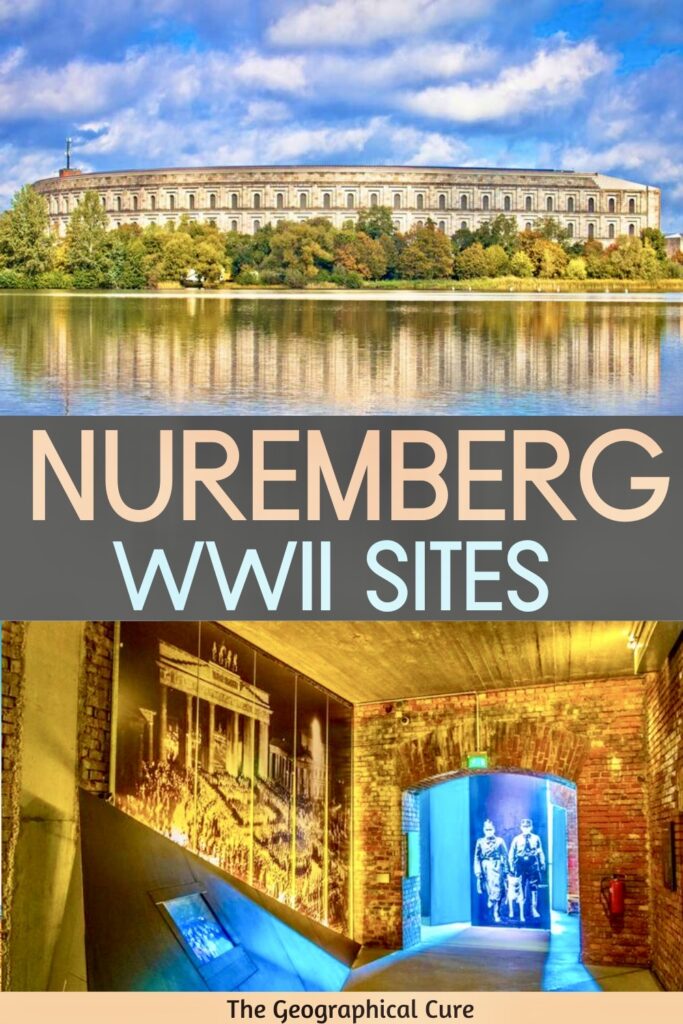
2 thoughts on “Guide To The Nazi And World War II Sites In Nuremberg Germany”
Wow, this is great Leslie. It’s exactly what I was looking for, being indeed a history buff. I’m going to Munich in the summer of this year and I wanted to visit Nuremberg from there. This guide is exactly what I need to go there for a day (or perhaps two days). I already found your travel blog this year when I went to Rome. That was an interesting guide too. I’m going back there in June, and probably will go back there for short holidays many more years (culture, good food and sunshine: nothing else to wish for). I live in Amsterdam and I’ve seen a lot of the world (I used to travel alone for many months, specially through Asia. No problems there for a women). Now I’m more interested in places in Europe. So, thank you for this site. I’m sure I will go to a lot of the places you described.
You’re welcome Lieke! Enjoy Munich. I do have a 1 day in Munich itinerary and a 4 days in Munich itinerary. Lucky you being based in Amsterdam. Makes it so easy to see Europe.
Leave a Comment Cancel reply
Save my name, email, and website in this browser for the next time I comment.
Last Updated on July 6, 2023 by Leslie Livingston
27 Meaningful Places to See World War II Sites in Berlin
This post contains links which earn me a small commission at no cost to you.
Ali Garland, Berlin expert & long term resident What to Do
World War II shaped Berlin’s and Germany’s history, and the horrible things that occurred are never forgotten. If you’re interested in World War II history, this extensive list of places to see World War II sites in Berlin is for you.
Berlin has many World War II sites and attractions that are worth visiting to learn about this history and to remember the many victims.
Since many of the atrocities that took place actually happened before the war started, I’ve included memorials and museums that cover the time period leading up to the war.
In this list of Berlin World War 2 attractions , you’ll find museums, memorials, and other sights that have ties to the war, the Holocaust, and the events in the years before war broke out.
Please visit these places with respect. Many of these sites honor tragic events and deceased victims.
What you'll find here
Tours that focus on World War II in Berlin
Taking a tour can be a great way to see several World War II sights in Berlin while also learning the history from an expert guide. Here are a few we recommend.
- Berlin Small Group Third Reich and Cold War Walking Tour
- Berlin World War II & Third Reich Tour
- Sachsenhausen Concentration Camp Half-Day Tour From Berlin
- Third Reich Berlin Walking Tour – Hitler and WWII
- Berlin Jewish History Walking Tour
Where to stay in Berlin
Berlin has lots of great neighborhoods for you to stay in and explore. If you’re visiting Berlin for the first time, it might be best for you stay somewhere central.
Many of the attractions are in Mitte or easily connected to Mitte by Berlin’s public transport , so you should stay somewhere in that region. Here are a few hotels we recommend.
BUDGET: Circus Hostel Popular hostel with a bar/brewery downstairs
MIDRANGE: Circus Hotel Centrally located near restaurants & transport
UPSCALE: Westin Grand Centrally located, can chisel off your own piece of the Berlin Wall
UPSCALE: Westin Grand Luxury hotel where you can chisel off your own piece of the Berlin Wall
APARTMENT: Adina Apartment Hotel Kitchenette; near grocery stores, shopping, Museum Island
For a more detailed look at the different neighborhoods and our hotel recommendations, check out our guide to where to stay in Berlin .
Or read my full review of the 25Hours Hotel in Charlottenburg with fantastic views of the Zoo and Tiergarten.
Where to find World War II sites in Berlin
From the well known memorials and museums to the ones you may not have heard about, this list of places to see World War II sites in Berlin is a great way to explore the city’s dark history.
Also, check out our list of the best World War II and Cold War sites in Berlin .
Memorial to the Murdered Jews of Europe

The Memorial to the Murdered Jews of Europe, often referred to as the Berlin Holocaust Memorial , honors the large number of Jewish people who died at the hands of the Nazis. This is one of the most important World War II sights in Berlin, and it’s probably already on your Berlin bucket list .
The memorial consists of 2,711 concrete blocks of varying heights, and the ground they sit on is an uneven slope similar to a wave. It’s supposed to make you feel uneasy.
The information center is inside and showcases letters, diaries, photographs, and biographies of the victims to help personalize the experience.
Entrance is free. The outside section is open 24/7, but check opening times for the information center. Photography is allowed (no flash inside) but please be respectful.
Do not sit on or climb on the cement slabs or take selfies. This is a place to reflect and remember those who were murdered.
Location: Cora-Berliner-Straße 1, 10117 Berlin

A small but powerful memorial sits in the middle of Bebelplatz along Unter den Linden , an important sightseeing area that’s probably already on your Berlin itinerary . If you don’t look down, you might miss it.
It’s a square glass panel, and when you look down, you’ll see empty shelves. This is a sight that remembers what was lost on May 10, 1933 when the Nazis burned approximately 20,000 books whose stories they didn’t want told.
Location: Bebelpl. 1, 10117 Berlin

Join our Facebook group!
Have questions about planning your trip to Berlin?
Join the Facebook group here to chat with Ali (she runs this site) and other people who have been to Berlin for tips.
Topography of Terror

The Topography of Terror Museum is one of the more interesting things to do in Berlin because it sits on the location that was the headquarters of the Gestapo and the SS between 1933 and 1945. This is where persecution and killings of Nazi opponents were organized, and where the genocide of Jews, Roma, and Sinti was coordinated.
This powerful museum now serves as a place to remember history and warn us from repeating the terrors of the past. The exhibits here use photographs and documentation to tell visitors about the crimes that were organized here, plus there are excavation sites you can view through glass windows.
Topography of Terror is definitely one to add to your list of places to see World War II sites in Berlin. Read my full guide to visiting Topography of Terror for more information and tips.
Location: Niederkirchnerstraße 8, 10963 Berlin
Stolpersteine

Every so often when you’re walking around Berlin, glance down at the sidewalk below you. You might see Stolpersteine, which are small brass squares that honor victims of the Nazis.
These “stumbling stones” sit in front of the victims’ last known address before they were taken away. Their name, date of birth, date of death if known, and where they were taken are among the details listed on these humble but meaningful memorials.
Though you’ll find more of them in Berlin and the rest of Germany, they do exist in other countries in Europe as well.
>>Read: Fun Facts About Berlin

Nazi Forced Labor Documentation Center
Managed by the Topography of Terror Foundation, the Nazi Forced Labor Documentation Center in the Schöneweide neighborhood is the location of a former forced labor camp. This is just one of over 3,000 that once existed in the Berlin area.
In the exhibition spaces and in the air raid shelter, you can view inscriptions, letters, and biographies of the people who were imprisoned at this labor camp. You can also tour some of the barracks, view the living conditions, and learn about the every day lives of the prisoners. This is one of many free museums in Berlin .
Location: Britzer Str. 5, 12439 Berlin
Reichstag Building

The Reichstag Building is the current seat of the German Parliament and one of the most historic landmarks in Germany . It also has quite a history with both World War II and the Cold War.
It was used by the German government until 1933 when a fire greatly damaged the building. Marking the end of the Weimar Republic and the strengthening of the Nazi dictatorship, the building was neglected and suffered more damage during WWII.
After the war, when Berlin was divided into East and West, the Reichstag Building sat in the West just steps from the Berlin Wall. The seat of the German government has moved to Bonn, and though the building was somewhat repaired, it was seldom used.
After reunification, the building was redesigned and restored. It opened in 1999, and the German Parliament returned here once again.
Today you can take a free tour of the Reichstag Building , but you must register well ahead of time. It’s one of the most popular free things to do in Berlin .
Location: Platz der Republik 1, 11011 Berlin
Jewish Museum
The Berlin Jewish Museum tells the stories of Jewish people in Germany from the Middle Ages to present day. The whole museum, inside and out, is designed to be part of the experience of learning about the diverse Jewish culture and the gaps made by the Holocaust.
You can explore three different sections of the museum that teach about different aspects of Jewish life, culture, and history in Germany. The museum uses a lot of symbolism, which makes this creative space more impactful. For example, in one area, uneven ground conveys a feeling of uncertainty.
This is a fantastic museum to visit if you’re interested in the history of the Jewish people in Germany.
Location: Lindenstraße 9-14, 10969 Berlin
Platform 17 Memorial
At the Grunewald S-Bahn station in the southwest corner of Berlin, you can see the Platform 17 Memorial. This station was used by the Nazis in the early 1940s to transport Jews to concentration camps.
Since it’s not centrally located, it was easier for the Nazis to make sure their prisoners weren’t seen while lining up to board the train. Today this memorial honors those who left from this station and were taken to horrible places where they were most likely killed.
The memorial was sponsored by Deutsche Bahn, Germany’s railway company, and track 17 is no longer used by any trains. The Platform 17 Memorial doesn’t take long to visit and is a 25 minute Sbahn ride from the Alexanderplatz station.
Location: Am Bahnhof Grunewald, 14193 Berlin
>>Check out these unique things to do in Berlin .
Anhalter Bahnhof

A little south of Potsdamer Platz is Anhalter Bahnhof, the remains of a train station. It was once one of the most important train stations in Berlin, and part of Berlin’s World War II history.
Unfortunately during the Nazi era, it was one of three stations in Berlin used to deport Jews to concentration camps. The station was damaged during WWII, but was still operational for several more years.
Anhalter Bahnhof is located in the former East. When the Soviets started using Ostbahnhof as the main train station in the East, Anhalter Bahnhof was no longer needed, and operations ceased in 1952.
Location: Askanischer Pl. 6, 10963 Berlin
>>Read: 13 Places to See the Berlin Wall + 9 Other Wall Attractions
Olympic Stadium

The Olympic Stadium in Berlin is another World War II site to visit. Built by renowned architect Werner March, this geometric masterpiece can hold up to 100,000 people.
But it has a dark history. During the Nazi regime, the Olympic Stadium was used to host propaganda events.
Today it’s an open-air venue used for concerts and other large events. If you visit the stadium on an event-free day, you can take a tour of the stadium and learn about its role during the Second World War.
Location: Olympischer Platz 3, 14053 Berlin
>>Read: 17 Top Sights in Berlin From a Local Who Knows
Kaiser Wilhelm Memorial Church

This famous Berlin landmark is one of the most important churches in Berlin. The original church was built here in the 1890s, but was damaged in WWII air raids in 1943.
Interestingly, the church was not rebuilt and instead has been left much as it was after World War II. Its been nicknamed by Berliners as Der Hohle Zahn—literally “The Hollow Tooth”.
This church is a stark reminder of the destruction of war and an interesting World War II site in Berlin.
Location: Breitscheidplatz, 10789 Berlin
Soviet War Memorial in Treptow Park
Located in Berlin’s Treptow Park in the southern part of the city, the Soviet War Memorial commemorates 7,000 of the 80,000 soldiers of the Red Army who lost their lives in the Battle of Berlin in 1945.
Part memorial, part cemetery, this is one of several Soviet War Memorials in Berlin, and was inaugurated in 1949, four years after the war. It’s an impressive example of a soaring Soviet monument.
Location: Puschkinallee, 12435 Berlin
Soviet War Memorial in Tiergarten

The Soviet War Memorial in Tiergarten Park is the other well known one in Berlin. It’s large and even includes a tank.
The memorial’s location was strategic – it’s within the park along Strasse des 17 Juni, not far from the Victory Column, the Reichstag Building, and Brandenburg Gate . Of all the Soviet War Memorials in and near Berlin, this is the only one that was built in the former West.
There are several other Soviet War Memorials in and near Berlin, but these are the two that are most central.
Location: Str. des 17. Juni 4, 10557 Berlin
Sachsenhausen Concentration Camp
One of the more popular day trips from Berlin , the Sachsenhausen Concentration Camp is located just outside the city limits, reachable on public transport with a ticket that includes zone C.

Not only did tens of thousands of people die here, but this concentration camp was the headquarters of the whole concentration camp system. Even after the Nazis were defeated and World War II ended, the Soviets used Sachsenhausen as a camp for their own political enemies, and thousands more died over the next five years.
Though this is a somber site, it’s important to learn about those who suffered and died here. Read more about how to get to Sachsenhausen from Berlin .
Entrance is free, but consider taking a guided tour like this one to enrich your experience: Sachsenhausen Memorial Half-Day Tour From Berlin .
Location: Str. d. Nationen 22, 16515 Oranienburg
Silent Heroes Memorial Center
This memorial center remembers the Jewish people who resisted persecution before and during World War II and those who helped them. The exhibit shows the plight of those who faced deportation and worse, and how they decided to go underground in order to resist.
Learn about their living conditions and how people tried to help them, including both successful and failed attempts.
The Silent Heroes Memorial is actually part of a bigger memorial center called the German Resistance Memorial Center, which honors many who resisted the Nazi rule.
The center’s location is also significant as it is the historic site of the attempted coup of July 20, 1944.
Location: Stauffenbergstraße 13-14, 10785 Berlin
Flak Tower in Humboldthain Park

From 1940-41, the Nazis built bunkers and set up an anti-aircraft gun tower in Humboldthain Park. After the war, the bunkers were mostly filled in, and nature began to reclaim the area.
Today not much is visible of its past, but it’s an interesting World War II site to see. And from the viewing platform at the top of the hill, you’ll be rewarded with some excellent views of Berlin .
The bunkers are now home to bats during the winter, but in the summer, Berliner Unterwelten offers tours of some of the underground sections of the demolished flak tower.
Location: Hochstraße 5, 13357 Berlin
Berlin Story Bunker
Near Anhalter Bahnhof is the Berlin Story Bunker museum, which is a bunker from World War I, not II. It tells the history of Berlin over 800 years.
One of the most interesting exhibits is about Hitler, how he came to power, why so many voted for him, and other questions and answers about the Nazi regime and the events leading to and during World War II.
If you’ve ever wondered how it all happened, this is an excellent museum to visit.
Location: Schöneberger Str. 23A, 10963 Berlin
Memorial SA Prison Papestrasse
This former SA prison is the only place remaining with traces of the terrors of the Nazis from as early as 1933. For much of 1933, it was a concentration camp run by the SA Field Police.
Here the SA (Sturmabteilung, or Storm Troopers) imprisoned, interrogated, and tortured political opponents, Jews and other groups persecuted by the Nazi regime. The names of almost 500 prisoners are known, but it is believed that the number is much higher.
At this museum, you can see exhibits documenting the history of this former prison. It also serves as a memorial to those who suffered here.
Location: Werner-Voß-Damm 54A, 12101 Berlin
Museum Berlin-Karlshorst
This museum documents World War II on the eastern front, but its location is also quite significant. The building is where Germany signed their unconditional surrender in front of representatives of Russia, the US, the UK, and France on the night of May 8-9, 1945.
This was the ceremonial recognition of complete defeat and victory over Hilter’s regime. The Museum Berlin-Karlshorst (formerly called the German Russian Museum) isn’t so centrally located, but it’s a significant place to visit for World War II history in Berlin.
Location: Zwieseler Str. 4, 10318 Berlin
Anne Frank Center
The story of Anne Frank and her diary is well known around the world, and if you’re ever in Amsterdam, the Anne Frank House is excellent. But Berlin also honors her memory and legacy with the Anne Frank Center.
At this museum, you can learn about Anne Frank and the history of National Socialism. It’s also an interactive museum that’s great for all ages.
Though there is a small entrance fee, this is one of many excellent cheap activities in Berlin .
Location: Rosenthaler Str. 39, 10178 Berlin
Museum Blindenwekstatt Otto Weidt
During World War II, Otto Weidt ran a workshop making brooms and brushes, and many of his employees were blind and deaf Jews. When they were in danger, he used his shop to help keep them hidden from persecution and deportation.
This museum tells the story of Otto Weidt and his workshop, and it’s another interesting and free World War 2 attraction in Berlin.
Memorial to Homosexuals Persecuted Under Nazism

Though Jews were the biggest group that suffered under the Nazi regime, they weren’t the only victims. In the southeast corner of Tiergarten, you’ll find the Memorial to Homosexuals Persecuted Under Nazism.
This memorial uses a video to tell the history of how gays were arrested, tortured, castrated, and killed under Nazi rule. The intention is to encourage tolerance and acceptance while remembering the past.
Location: Ebertstraße, 10785 Berlin, across the street from the Holocaust Memorial
Memorial to the Victims of the Nazi Euthanasia Murders
Under Nazi rule, tens of thousands of patients from sanatoriums and nursing homes as well as people who were deemed to be racially and socially undesirable were murdered. This horrific crime is considered a precursor to the mass murder of European Jews.
Today the memorial is at the location where the euthanasia murder program was planned, developed, and carried out.
Location: Tiergartenstraße 4, 10785 Berlin
Memorial to European Sinti and Roma Murdered Under Nazism

On the eastern edge of Tiergarten, you can see the Memorial to European Sinti and Roma Murdered Under Nazism. This memorial honors the memory of the many Sinti and Roma people, formerly called “gypsies”, who were killed under the Nazi regime.
You can learn about the history of this group and what happened to them, and there’s a fountain where a flower is placed every day.
Location: Simsonweg, 10117 Berlin
Memorial to the Murdered Members of the Reichstag

Political leaders in Germany were also victims of the Nazis. The Memorial to the Murdered Members of the Reichstag honors the 96 known members of Parliament who died at the hands of the Nazis before and during World War II.
You can see this memorial in Platz der Republik, in front of the Reichstag Building. It’s near the trailer type buildings where you enter for a booked free tour.
Honestly, it’s a little cramped here, almost like the memorial was inconveniencing the people who set up the trailer looking buildings. I feel like they could’ve set those trailers back a little farther to give a little space to the memorial.
Location: Scheidemannstraße 5, 10557 Berlin
House of the Wannsee Conference
This luxury villa was the location of the infamous Wannsee Conference in 1942. Nazi government officials met to discuss the so-called “Final Solution to the Jewish Question” here.
Today this location serves as a museum documenting this awful meeting and how their plan was put into action. It’s also a Holocaust memorial where you can learn about the genocide of the Jewish population.
This World War II site isn’t centrally located, but it’s a historically important attraction to visit.
Location: Am Großen Wannsee 56-58, 14109 Berlin
Cecilienhof Palace

Cecilienhof Palace was built from 1914 to 1917 in the style of an English Tudor manor house, and it was the last palace built by the Hohenzollern family. They ruled the Kingdom of Prussia and German Empire until the end of World War I.
This palace is also famous for being the location of the Potsdam conference from July 17 to August 2, 1945, when the Allies met to discuss and decide how to handle post war Europe and Asia. This meeting is seen as the end of World War II and the beginning of the Cold War.
This Cold War site is a great place to include on a day trip to Potsdam .
>>Read: How to Get to Potsdam From Berlin by Train
Location: Im Neuen Garten, 14469 Potsdam
Berlin World War II Tours
Consider taking a tour to see several World War II sights in Berlin while also learning the history from an expert guide. Here are a few we recommend.
Berlin Travel Resources
I want you to have the best trip to Berlin, and hopefully this list of World War II sites in Berlin is helpful. But there are lots more tips on the site!
- 101 Best Things to do in Berlin
- 23 Impressive Castles in Berlin (And Nearby)
- 27 Best World War II & Cold War Sights in Berlin
- 29 Fun Day Trips From Berlin
- 75 Things to Know Before Visiting Berlin: Essential Berlin Travel Tips
- What to Wear & What to Pack for Berlin, Germany: Your Ultimate Berlin Packing List
- How to Get Around in Berlin: An Easy Guide to Berlin Public Transportation
Check out my favorite travel planning sites and resources
These are the sites I like for travel planning, plus items I like to travel with.
Planning Booking.com : Find a Berlin hotel here.
Rick Steves and Lonely Planet : My favorite guidebook resources.
Tours, Activities, Tickets Viator : Great site for finding tours and other activities.
GetYourGuide : Another good option for tours and activities.
Transport Welcome Pickups : No stress option for airport pickups.
Discover Cars : Find a rental car for Germany road trips.
Deutsche Bahn and FlixBus : Best options for getting around Germany.
Packing Orange SIM & eSIM : Great option for SIM & eSIM cards for German & EU.
Collapsible water bottle , plug adapter , and stuff bag : Small things that will make your trip a little easier.
Packing Orange SIM & eSIM : Great option for SIM & eSIM cards for Germany & EU.
Book a local photographer Flytographer : Hire an amazing local photographer anywhere in the world. Use code BERLINTRAVEL to get $25 off your first photo shoot.

Related Posts

What to do in Berlin on Monday: 25+ Museums & More

What to do in Berlin on Sunday: 15+ Ideas

Best Berlin Hop On Hop Off Bus Tours
You could also add the Georg Elser memorial at Wilhelmstrasse, Berlin.
Good one, thanks!
Leave a Reply Cancel reply
Your email address will not be published. Required fields are marked *
Save my name, email, and website in this browser for the next time I comment.
This site uses Akismet to reduce spam. Learn how your comment data is processed .

- Berlin In a Day
- Essential Berlin Tour:
- Berlin Wall & Cold War
- Berlin World War Tour
- Sachsenhausen Memorial
- Potsdam Tour
- Berlin Custom Group Tour
- Berlin History and Highlights Tour
- Berlin Wall Tour
- Sachsenhausen Memorial Tour
- Third Reich Tour Berlin
- Berlin Blog
- Discover Berlin History & Highlights
- Berlin Wall Bike Tour
- Third Reich World War Sites & History
- Berlin Highlights Brandenburg Gate & Tiergarten
- About / Contact
Best World War II Tours in Germany and Berlin
World war 2.

Berlin World War II Tour: History and Downfall of the Third Reich

Private Berlin Third Reich Bike Tour World War Sites & History

Sachsenhausen Tour with a Licensed Guide
Best world war tours other parts of germany.

Munich – Berchtesgaden and Eagle’s Nest Day Tour from Munich

Nuremberg Medieval Old Town and Nazi Rally Grounds Walking Tour

Munich WWII Combo: Dachau Concentration Camp Memorial Site and Third Reich Walking Tour

The Colossus of Prora – Rugen
Privacy overview.
- All Destinations
- United States
- European Theater
- Pacific Theater
- The Home Front
- The Holocaust
- Pearl Harbor
- WWII Events
- Wings, Wheels, & Weapons
- General WWII Travel Topics
- Work With Me
- Skip to main content
- Skip to primary sidebar
DESTINATION: WWII
A World War II Travel Blog
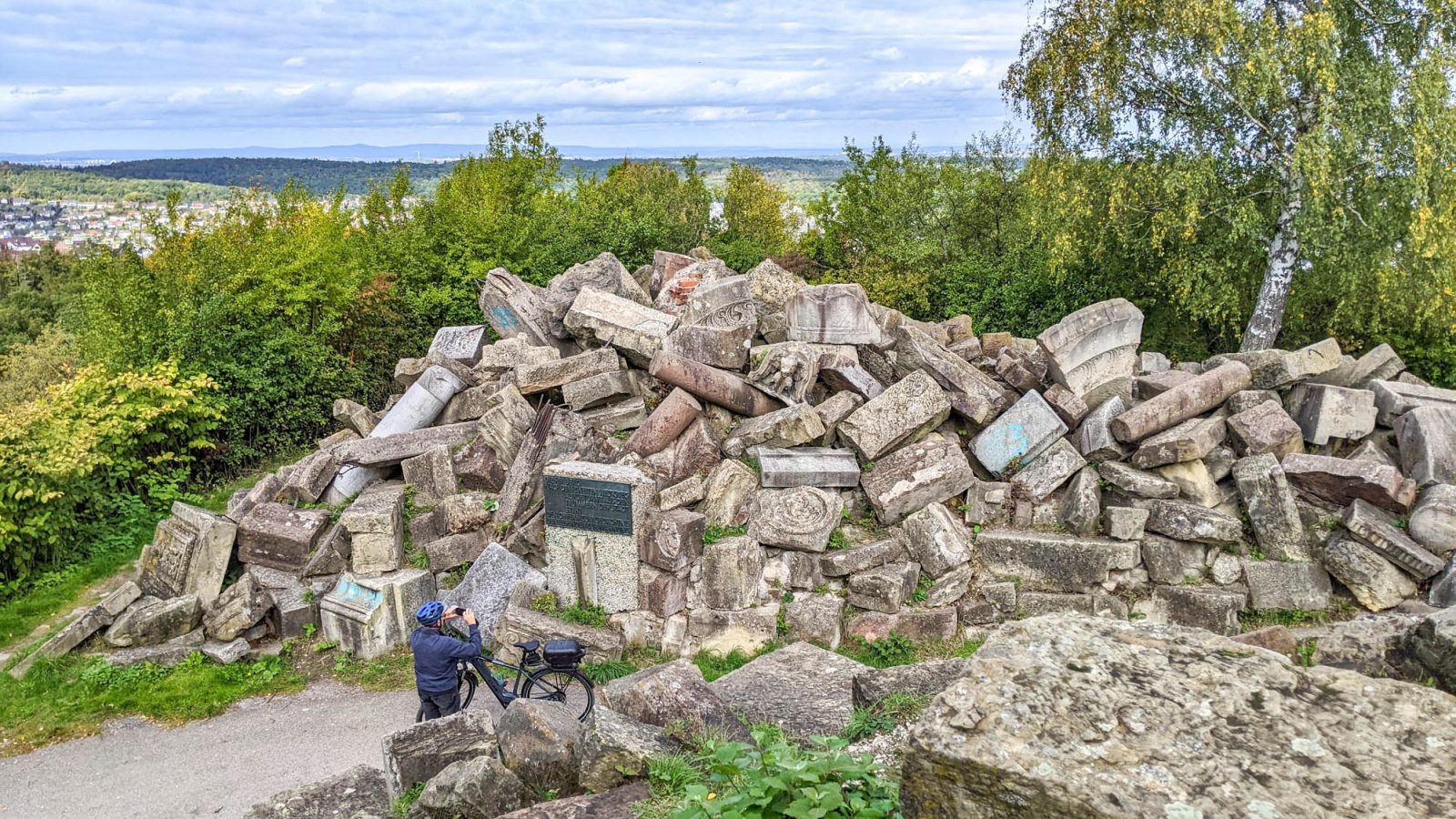
How to Visit Birkenkopf Stuttgart (Monte Scherbelino): The Unique Perspective at WWII’s Rubble Hill
Last Updated: February 26, 2024 // by Ashley Smith Leave a Comment
As you can imagine, there are interesting World War II sites all over Germany , but Birkenkopf Stuttgart is definitely one of the more unusual ones. Stuttgart’s Birkenkopf, known more locally as Monte Scherbelino, is one of Germany’s many leftover ruins sites. So, let’s explore it.
Table of Contents

What is Birkenkopf Stuttgart?
Birkenkopf Stuttgart is one of Germany’s many “rubble hills”—piles of rubble and debris from the Allied bombings of Germany during World War II. These hills go by a few different terms actually:
- Schuttberg – A general German term for a mound of piled up rubble
- Trümmerberg – This term specifically refers to mounds of piled up rubble leftover from World War II, of which there are many in Germany.
- Monte Scherbelino – Just another nickname for the same thing that sounds Italian but is indeed German. It translates to “Shard Mountain” and is how Stuttgart’s Birkenkopf is known locally.
- Birkenkopf is the name of the hill in Stuttgart where you can find this hill of rubble.
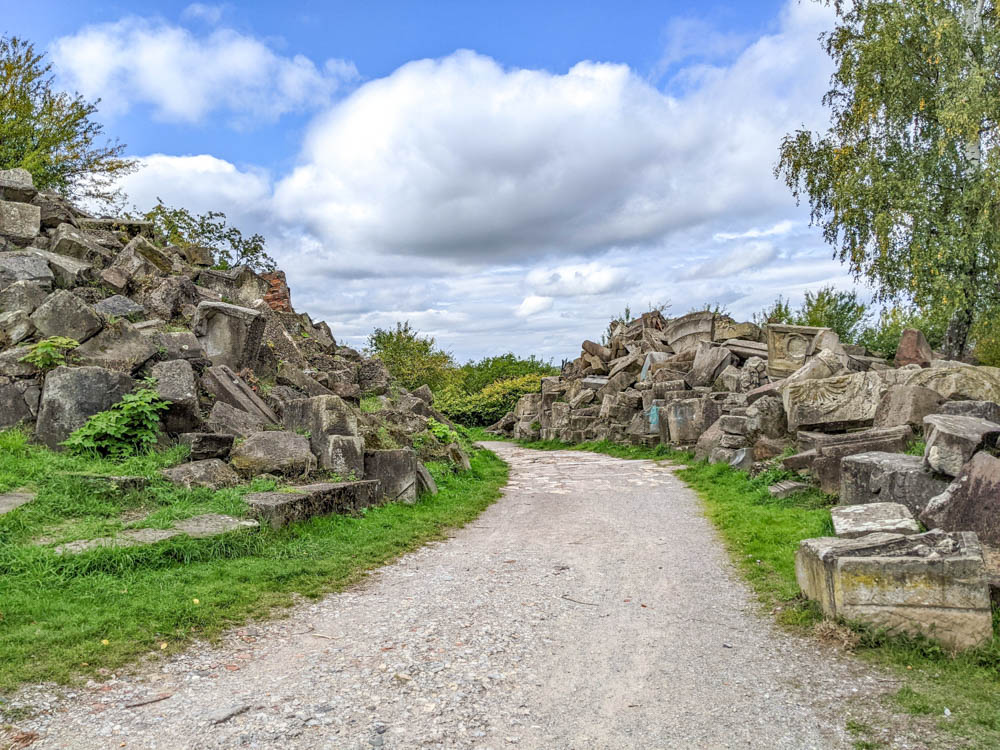
Also check out : 11 Reasons You Should Hike to the Eagle’s Nest in Berchtesgaden
Stuttgart, Germany during World War II
During World War II, Stuttgart, Germany was home to some serious industrial capacity in the form of the Bosch, Porsche, and Daimler automotive factories, the SKF ball bearings factories, several military bases, an important central rail station, and more. Because of Stuttgart’s war-making capabilities, the Allies targeted it in a series of 53 bombing raids that lasted 4.5 years—from August 25, 1940 to April 19, 1945.
Both the Royal Air Force and the U.S. 8 th Air Force took part in these raids which ultimately destroyed almost 50% of Stuttgart city and killed 4,562 German citizens and 770 foreign forced laborers.
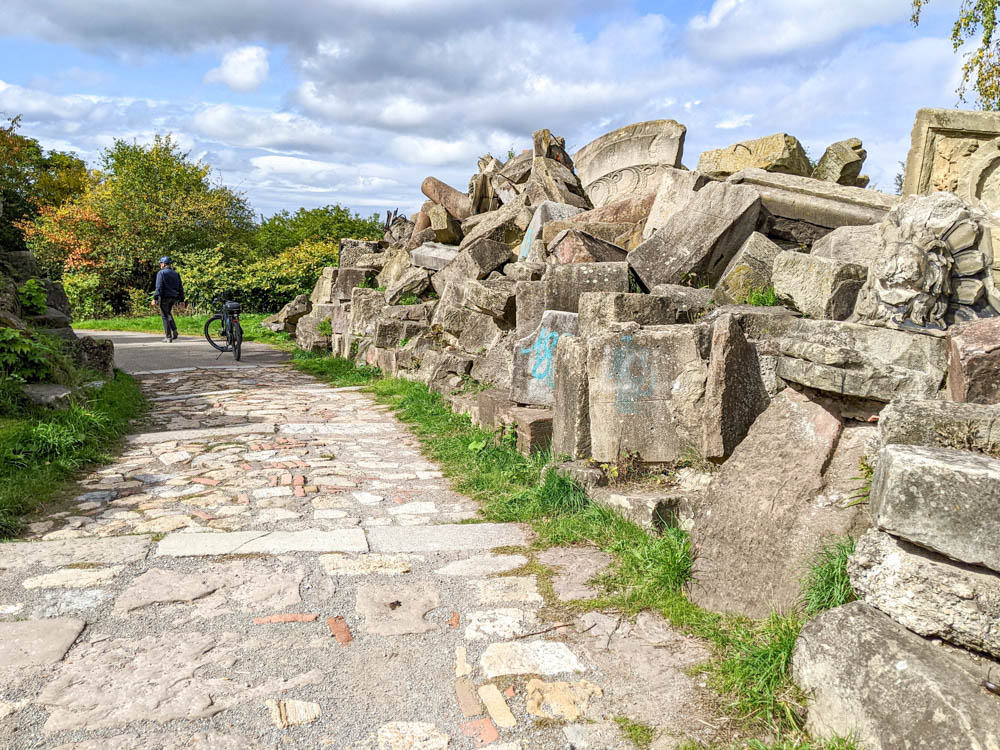
In total, the Allies dropped 27,000 tons of bombs on Stuttgart. After the war, authorities piled up much of the leftover 5.3 million cubic feet of rubble onto Stuttgart’s Birkenkopf, forming the city’s most prominent trümmerberg . (Yes, almost all major German cities have at least one trümmerberg .)
Also check out: Complete Guide to Visiting Dachau Concentration Camp Outside Munich
Subscribe to DWWII
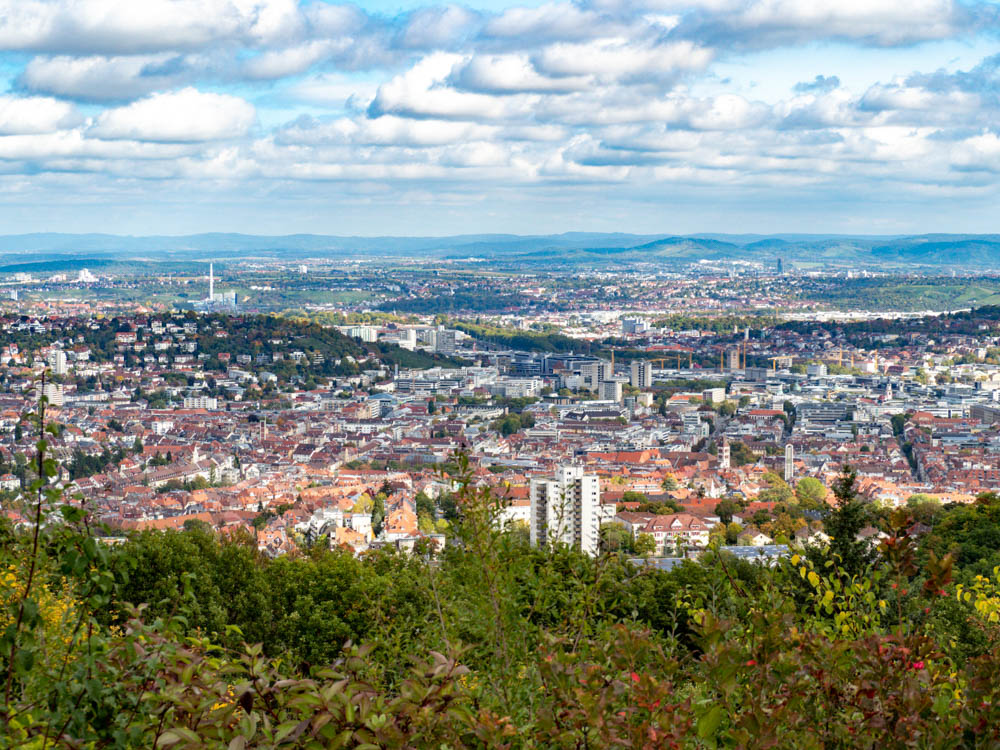
Monte Scherbelino Stuttgart
Birkenkopf Stuttgart, already a prominent hill in the city, became the location of Stuttgart’s post-war trümmerberg known as Monte Scherbelino. Before the war, this hill was about 1,500 tall. After the war, the rubble raised the hill’s elevation to 1,676 feet.
Birkenkopf Stuttgart is the highest point of elevation in town. From the top, you can see all of Stuttgart and far beyond.
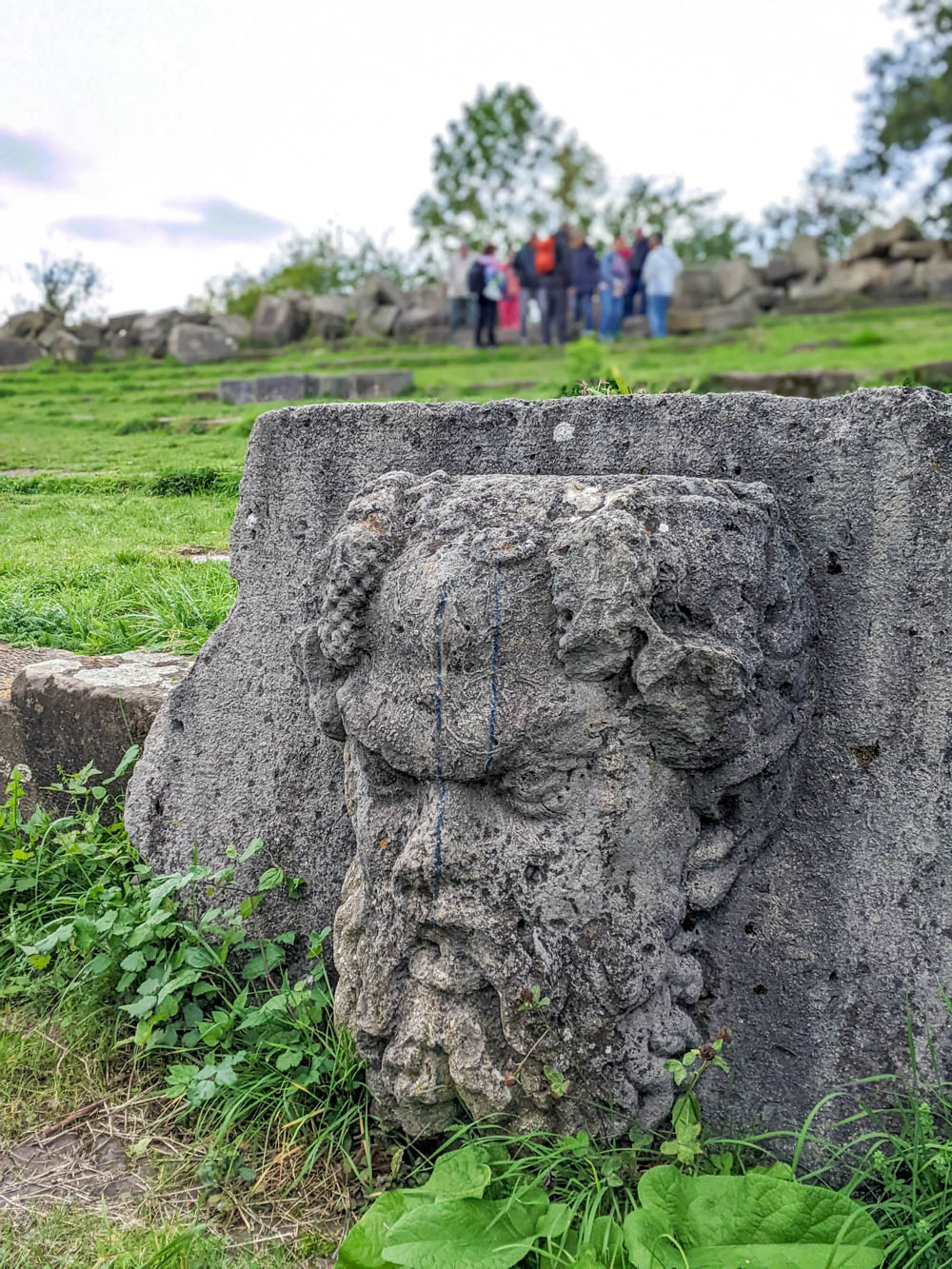
Where is Monte Scherbelino?
Stuttgart’s rubble hill is located on the southwestern outskirts of the city atop the hill known as Birkenkopf. It’s about a 12-minute drive from Stuttgart’s main train station (on a good, traffic-free day).
What to see at Birkenkopf Stuttgart
When you visit Birkenkopf Stuttgart today, you can very clearly still see the piles of rubble from the bombings. You can make out columns, entryways, artwork, sculptures, and more. All piled together in heaps with bits of nature (and lots of lizards) poking through the cracks.
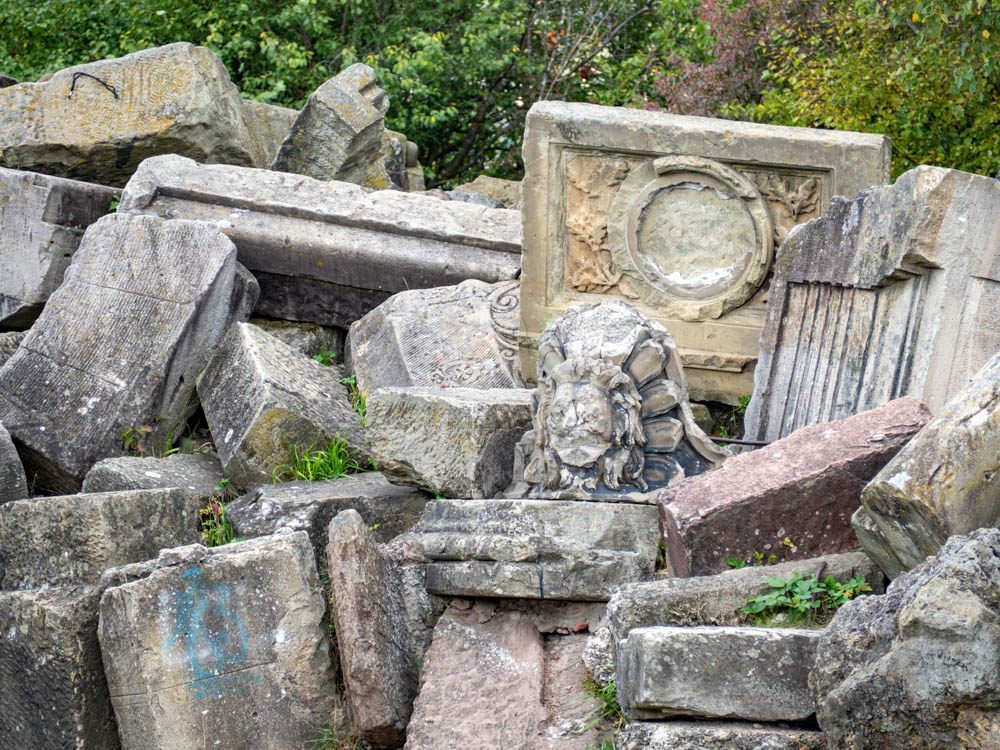
A (very) large cross memorial stands at the top—dedicated on November 19, 2003 by “the entire Evangelical parish in Stuttgart.” Behind the cross is what I would call a large amphitheater-like area where church services are conducted on Sundays.
You can see incredible aerial views of Stuttgart, the Black Forest, the Swabian Forest, and far beyond. At the top and along the way you’ll see a number of small memorials commemorating the lives lost in the bombing raids.

Also check out: 8 Crucial Tips for Visiting the Anne Frank House : A Need-to-Read Guide
How to get to Birkenkopf Stuttgart
Being that Stuttgart’s Monte Scherbelino is on the outskirts of the city, it isn’t exactly the easiest location to get to. But, it’s not impossible either.
How to get to Birkenkopf Stuttgart by bus
You can absolutely take the bus to Birkenkopf Stuttgart, but it’s not the most efficient. Taking the bus to Rubble Hill from Stuttgart Hauptbahnhof will take about 45 minutes, not including wait times (whereas driving will take about 12 minutes). If you’re not at a central location like the Hbf though, you’ll have to change buses a few times which will greatly increase your travel times. From my hotel it was going to be about an hour and a half.
Taking the bus to Birkenkopf Stuttgart is not what I would recommend so I’m not going to go into detail about it. But, if that’s what you want to do, you’ll want to take bus line 92 to the “Birkenkopf” stop .
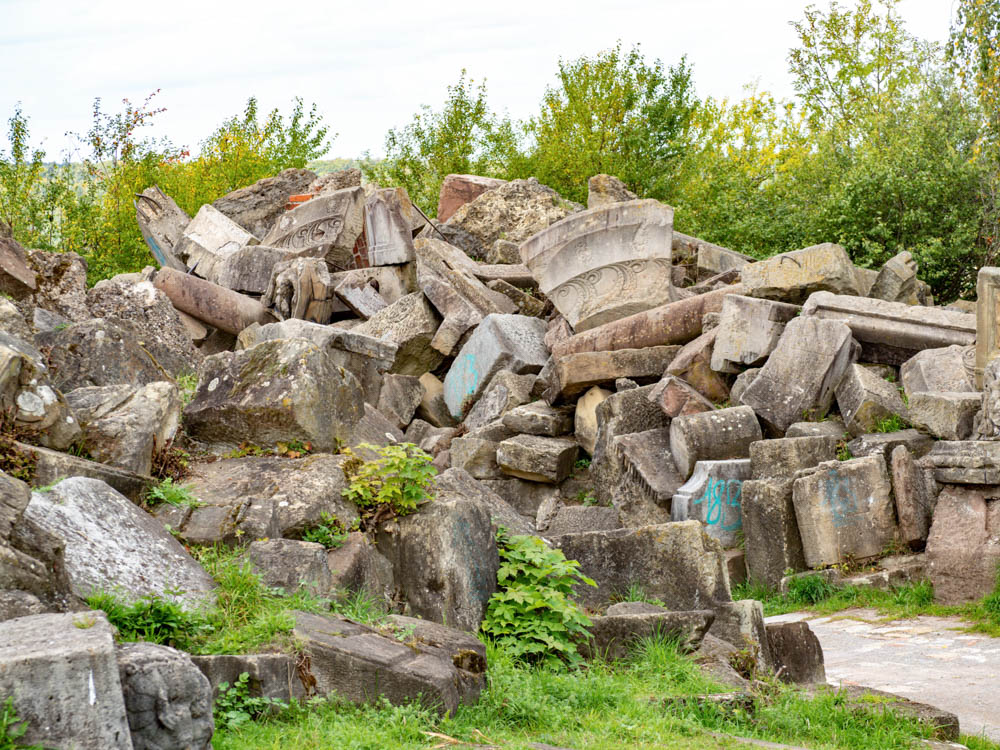
The best way to get to Birkenkopf Stuttgart
Taking a car to Birkenkopf Stuttgart is the absolute fastest and easiest way to get there. However, it’s not the cheapest, unfortunately.
If you have your own car, perfect! Put “Parkplatz am Birkenkopf” into your GPS and head on over. Still need a rental? Check out the best rental cars in Stuttgart here .
From Stuttgart Hauptbahnhof, it’ll take about 12 minutes. From Stuttgart airport, about 15 minutes. From Stuttgart Center ( Stuttgart-Mitte ), about 15 minutes. From the Wasen, Porsche Arena, and Mercedes-Benz Arena, about 20 minutes.

Where to park for Birkenkopf Stuttgart
Luckily, Stuttgart’s Birkenkopf is a popular park that welcomes visitors of all kinds (not just WWII travelers, I mean). Ergo, there is a dedicated parking lot at the bottom of the hill. On your map or GPS, look for Parkplatz am Birkenkopf .
This good-sized lot is right across the entrance from the Birkenkopf; you can’t miss it. (They have parking for bicycles as well.) From what I’ve found, parking at the Birkenkopf Stuttgart Parkplatz is free.

Also check out : 7 Solid Reasons to Visit the Munich NS-Documenation Center at the former Nazi Headquarters
Taking a rideshare to Birkenkopf Stuttgart
If you don’t have your own car, you can also take a taxi or rideshare to Birkenkopf Stuttgart. This will save you a ton of time, but is definitely the more costly route. For my particular trip in October 2022, I took an Uber from my hotel over near the Porsche Arena (on the other side of town). It took 25 minutes each way and cost €32 each way.
(Pricey, yes, but this is a site I had been wanting to visit for a few years now that I missed on my last two trips to Stuttgart. My hotel is also a lot farther away from Monte Scherbelino than yours will probably be.)
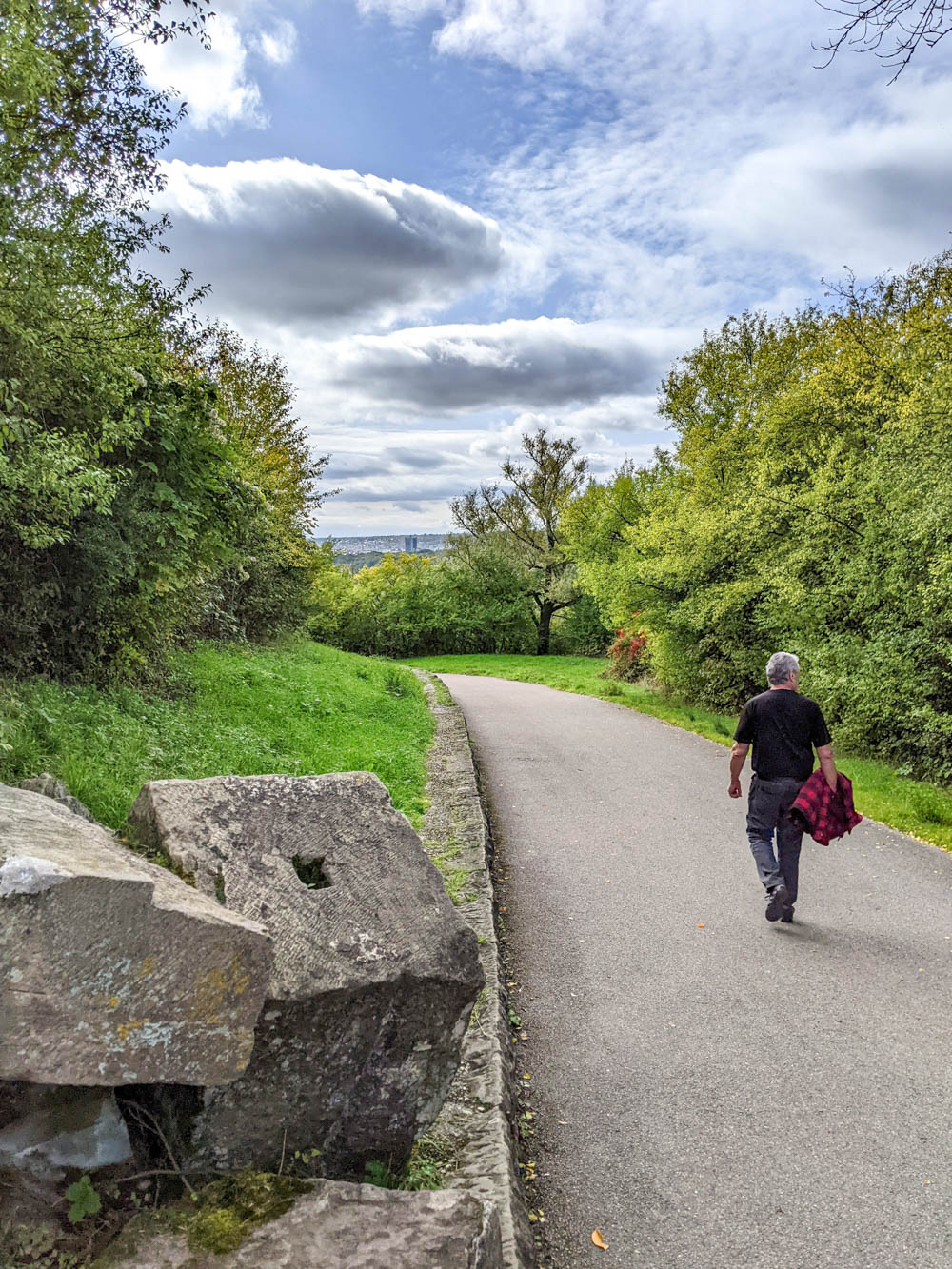
What to know about Uber in Stuttgart
Uber and Germany don’t exactly get along. So, using Uber in Stuttgart isn’t going to be as widespread and easily available as you’re probably used to. You can use the app, but you’ll probably find that available cars are few and far between. We actually had the same driver there and back because I believe he was the only available driver in the city.
You’ll also notice that, though you’re using the Uber app and your own Uber account, you’ll get a message letting you know that your transaction is actually being routed through a local taxi company instead. So while you’re still using the Uber app, you aren’t being driven by “Uber drivers.”
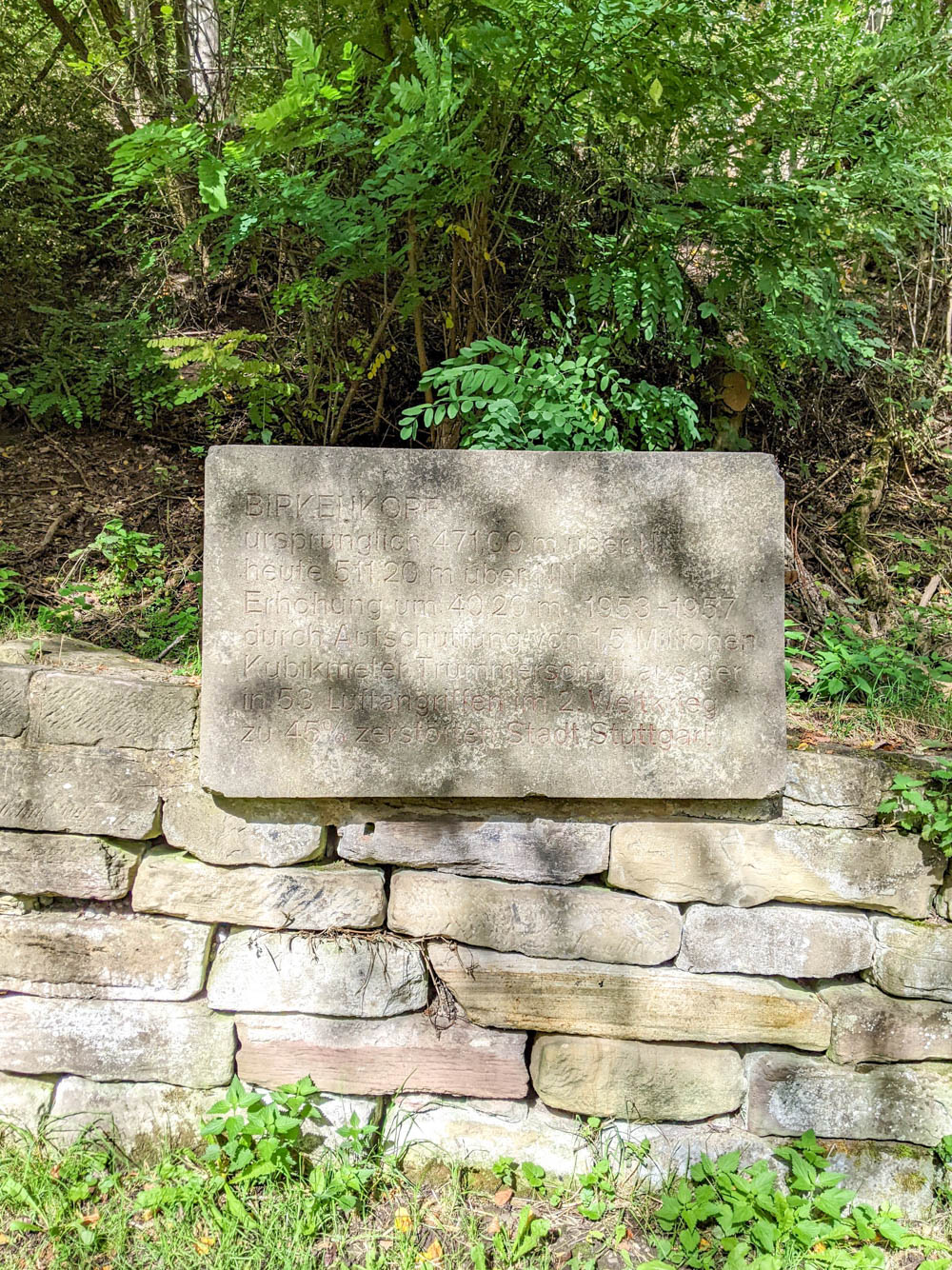
Regardless, the app still works the same. Payment works the same. Trip tracking is the same. Just don’t be alarmed when you see that message.
You can also have your hotel call a taxi for you. I didn’t do this because I was afraid of having trouble getting another taxi to go back. But, we only spent about 30 minutes at Birkenkopf Stuttgart so, had I thought of it, I would have just paid extra for the driver to wait for us. Always an option.
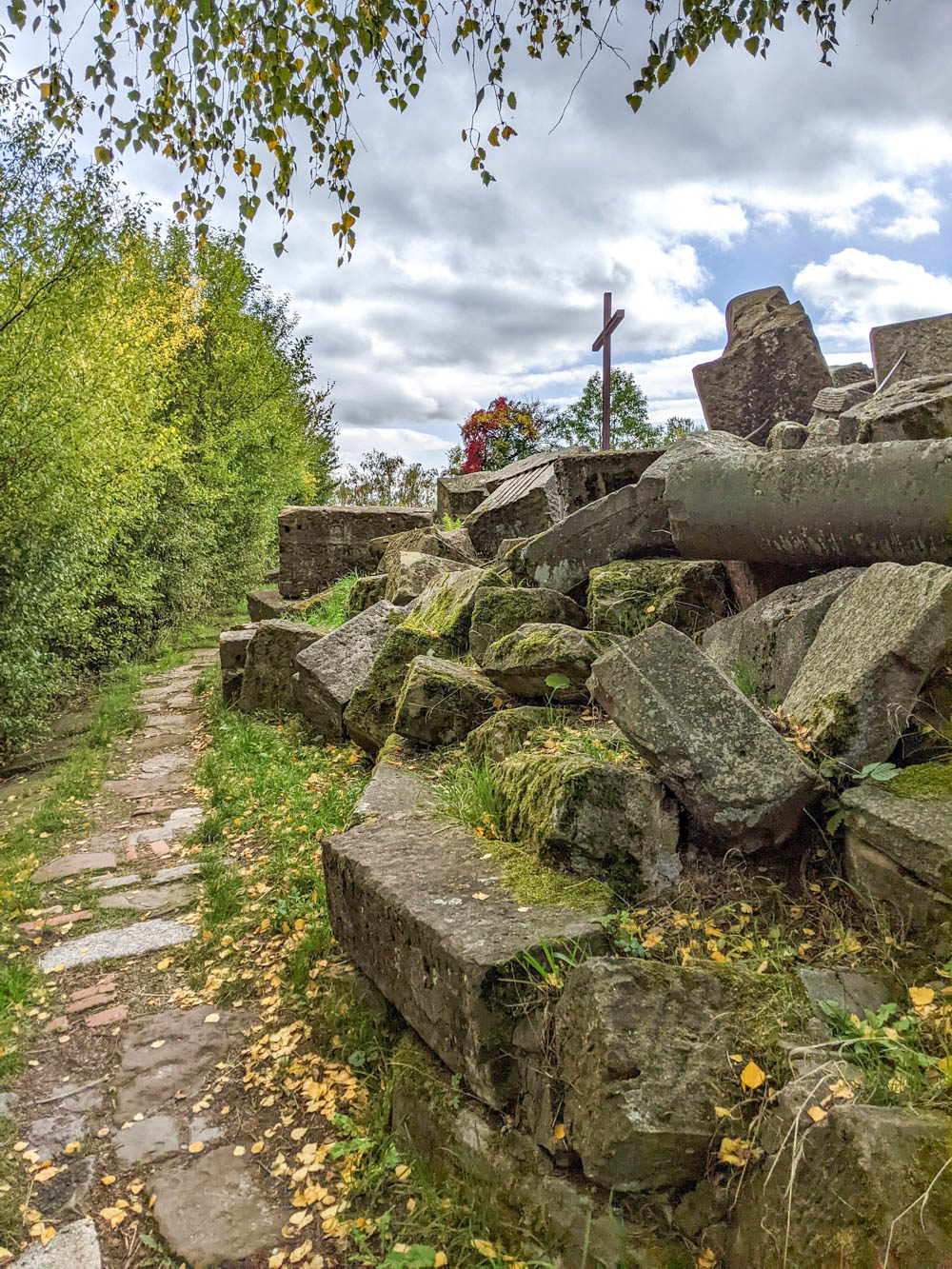
Birkenkopf Stuttgart: Need to know
Once you arrive at Birkenkopf Stuttgart Parkplatz, cross the main intersection and enter the park by going up the unmarked staircase. (see above) From there, it will be an easy 15-minute walk to the top of Monte Scherbelino via the Birkenkopf wanderweg (trail).
There will be a couple of signs to guide you, but really it’s a simple, straightforward and paved little walk. There’s only one walkway – you won’t get lost. But do be aware of the bikers; they come flying down the hill super fast so just be on the lookout.
On Sundays Birkenkopf Stuttgart hosts church services in the space behind the cross memorial. (The page that used to contain information on this is no longer active, so I’m not 100% this info is 100% reliable, but it’s worth checking if you’re in the area.)
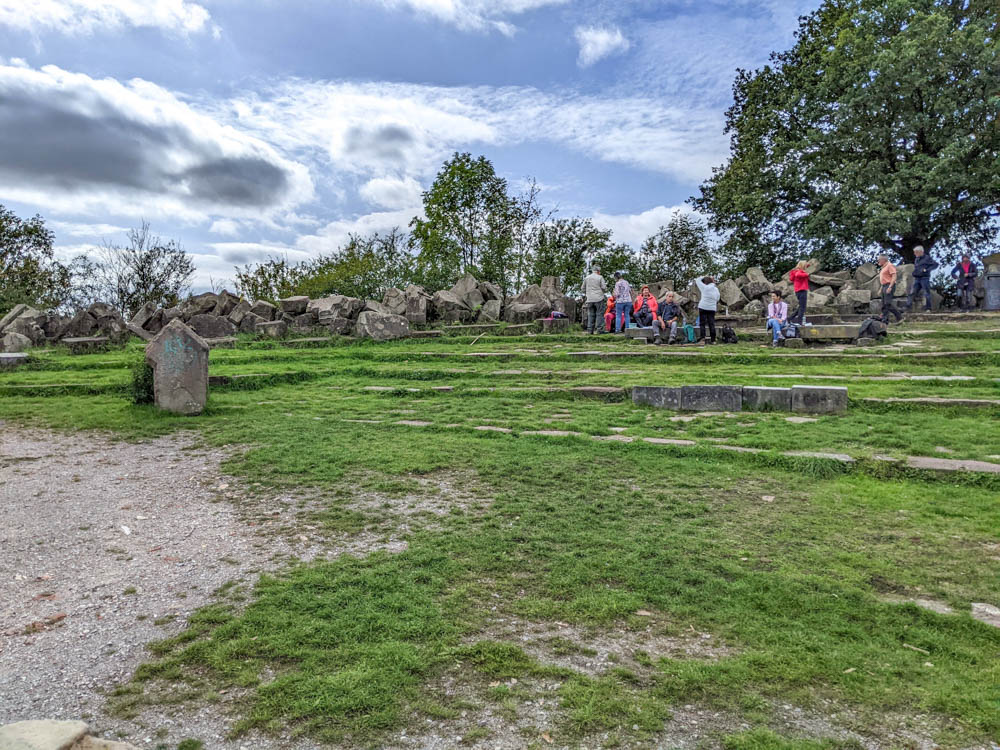
Where to stay in Stuttgart
If your travels through Germany have you staying overnight in Stuttgart, check out these great options:
- Hilton Garden Inn at NeckarPark – If you’ll be visiting during Canstatter Volksfest or have soccer/futbol in your plans, I highly recommend this hotel. It’s in a quiet location and the service is top-notch. (Fantastic breakfast too!)
- Zur Weinsteige – Cozy hotel that reviewers love for the friendly staff, great location in the city center, and cool design features.
- Kronenhotel – Highly-rated 4-star hotel in the heart of Stuttgart with sauna (don’t mind if I do), gourmet breakfast included!, and a friendly and attentive staff.
- Or check out all Stuttgart hotels here to find the perfect one for you.

What to pack for your trip to Stuttgart
Here are just a few things you’ll need specifically for your trip to Germany:
- Germany guidebook – for all your other sightseeing needs
- Germany customs and culture guide – for all the necessary tidbits other guidebooks leave out
- European plug adapter – so you can use your American electronics in Germany
Like this post? Have questions about visiting the Rubble Hill in Stuttgart? Let me know in the comments below! Have a great time in Germany.

Save this info, pin this image:

About Ashley Smith
Ashley is a World War II historian and travel expert who has visited 32 countries. She specializes in quick trips throughout Europe and the Americas with a focus on World War II museums, memorials, battlefields, and other sites of interest. Originally from Memphis, TN, she currently lives in Boston with her husband and two feline commanders.

Reader Interactions
Leave a reply cancel reply.
Your email address will not be published. Required fields are marked *

Paris WWII Sites Map

Berlin WW2 Tourist Attractions
by Original Berlin Tours | Mar 7, 2024 | World War Tour Berlin
When visiting Berlin, one cannot underestimate the historical significance of World War II. The city has a rich history that can be explored through various tourist attractions. In this blog post, we will highlight some of the top WW2 sites in Berlin.
1. Brandenburg Gate
The Brandenburg Gate is one of the most iconic landmarks in Berlin and serves as a symbol of the city’s unity. During World War II, the gate suffered heavy damage, but it was later restored and now stands as a reminder of the city’s tumultuous past. Visitors can learn about the gate’s historical significance and enjoy a panoramic view of the city from the top.
2. Reichstag Building
The Reichstag Building, home to the German Parliament, played a significant role during World War II. It was severely damaged during the war but was reconstructed and now represents the reunification of Germany. Visitors can take guided tours of the building and even access its iconic glass dome, offering stunning views of Berlin.
3. Holocaust Memorial
The Holocaust Memorial, officially known as the Memorial to the Murdered Jews of Europe, is a striking tribute to the millions of Jews who lost their lives during the Holocaust. The memorial consists of over 2,700 concrete slabs, arranged in a grid pattern. Walking through the memorial offers a somber and reflective experience, allowing visitors to pay their respects and learn about this tragic chapter in history.
4. Topography of Terror
Located on the site of the former Gestapo and SS headquarters, the Topography of Terror is an informative outdoor museum documenting the atrocities committed by the Nazi regime. Visitors can explore the remains of the buildings, view exhibitions, and delve into the history of the Nazi regime and its crimes against humanity.
5. Checkpoint Charlie
Checkpoint Charlie was the most famous crossing point between East and West Berlin during the Cold War. It became a symbol of the divided city, and the checkpoint witnessed several historical events during World War II. Today, visitors can learn about the history of the checkpoint at the nearby museum and even take a picture with actors dressed as border guards.
6. Museum Island
While not exclusively focused on World War II, Museum Island houses several museums that touch upon Berlin’s history. The Neues Museum, in particular, showcases archaeological artifacts, including the iconic bust of Queen Nefertiti, which was spared destruction during the war. It’s worth visiting to gain a broader understanding of Berlin’s past.
Berlin offers a plethora of WW2 attractions that provide insight into the city’s troubled history. From iconic landmarks like the Brandenburg Gate and Reichstag Building to somber memorials like the Holocaust Memorial and Topography of Terror, each site offers a unique and educational experience. Exploring these attractions not only pays homage to the past but also helps shape a more inclusive and understanding future.
Check out our other cities
Berlin tours.
- Original Berlin Tours
- Berlin Pub Crawl
- Pub Crawl Berlin
- Free Berlin Tours
- More Berlin Tours
- Cold War Tour Berlin
- World War Tour Berlin
- Sachsenhausen Tour
Barcelona Tours
- Free Barcelona Tours
- Barcelona Pub Crawl
- Pub Crawl Barcelona
Budapest Tours
- Free Budapest Tours
- Budapest Bar Crawl
- Pub Crawl Budapest
Madrid Tours
- Madrid Pub Crawl
- Pub Crawl Madrid
- Nice Pub Crawl
- Nice Bar Crawl
- Pub Crawl Nice
Amsterdam Tours
- Amsterdam Pub Crawl
- Bar Crawl Amsterdam
Paris Tours
- Pub Crawl Paris

Dublin Tours
- Pub Crawl Dublin
Warsaw Tours
- Pub Crawl Warsaw
Stockholm Tours
- Pub Crawl Stockholm
Other Links
- Original Pub Crawls
- Be Original Tours
- Original Free Tours
- E-Ticket Trail
WhatsApp us

Berlin WW2 Sites: A Comprehensive Guide for Beginners
by Original Berlin Tours | Mar 7, 2024 | Cold War Tour Berlin
Introduction
World War II had a profound impact on Berlin, leaving behind a multitude of historical sites that serve as a constant reminder of the city’s past. Visiting these sites provides a unique opportunity to learn about the events that unfolded during the war and pay tribute to those who lost their lives. Whether you’re a history enthusiast or simply curious about the period, this guide will help you navigate through some of the most significant WW2 sites in Berlin.
1. Brandenburg Gate
The Brandenburg Gate is not only a symbol of Berlin but also played a crucial role during WW2. It was once located in the “no man’s land” between East and West Berlin, serving as a poignant reminder of the city’s division. Today, it stands as a symbol of German unity and a popular tourist attraction. Take a moment to appreciate the historical significance of this iconic landmark.
2. Reichstag Building
The Reichstag Building, with its striking glass dome, is another must-visit location. During the war, it was severely damaged and fell into disrepair. Following the reunification of Germany, it underwent extensive renovations. Today, visitors can ascend to the dome’s rooftop terrace, providing panoramic views of the city. It serves as a powerful symbol of Berlin’s resilience and transformation.
3. Holocaust Memorial
The Holocaust Memorial, officially known as the Memorial to the Murdered Jews of Europe, is a somber and poignant site that should not be missed. The memorial consists of 2,711 concrete slabs of varying heights, creating a maze-like atmosphere. It serves as a solemn tribute to the millions of lives lost during the Holocaust and encourages reflection on the atrocities of the past.
4. Topography of Terror
The Topography of Terror is an outdoor museum located on the site that housed the Gestapo and SS headquarters during WW2. It provides a detailed exhibition on the rise of the Nazi regime, their brutal tactics, and the consequences of their actions. The museum offers an in-depth understanding of the war’s impact on Berlin and serves as a reminder of the importance of safeguarding democracy.
5. Sachsenhausen Concentration Camp
About an hour’s drive from Berlin, Sachsenhausen Concentration Camp is a powerful testament to the horrors endured by prisoners during WW2. Take a guided tour to gain insight into the camp’s history, view the remaining buildings, and reflect upon the experiences of those who were imprisoned there. It is an emotionally challenging visit but an important one to understand the depths of human suffering.
6. Berlin Wall Memorial
Although the Berlin Wall is primarily associated with the Cold War era, its existence was a direct consequence of WW2. The Berlin Wall Memorial provides a comprehensive insight into the wall’s construction, its impact on the city, and the stories of those affected by it. Visit the memorial to gain a deeper understanding of the events that unfolded during the post-war period.
7. Checkpoint Charlie
Checkpoint Charlie was one of the most famous crossing points between East and West Berlin during the Cold War. While its significance lies more in the post-WW2 era, a visit to this site offers insights into the tense atmosphere that once permeated the city. Explore the nearby museum to learn more about escape attempts, espionage, and life behind the Iron Curtain.
8. German Historical Museum
For a comprehensive overview of German history, including World War II, visit the German Historical Museum. Explore the range of exhibits that cover the war’s causes, consequences, and the divisions that followed. The museum provides an excellent starting point for those seeking a deeper understanding of Berlin’s past.
Visiting Berlin’s WW2 sites offers a unique opportunity to witness history firsthand. From iconic landmarks to solemn memorials, each site plays a crucial role in understanding the impact of the war on Berlin and the world. Take the time to reflect, learn, and honor those who lived through this turbulent period. By doing so, we can ensure that future generations remember the lessons of the past.
Check out our other cities
Berlin tours.
- Original Berlin Tours
- Berlin Pub Crawl
- Pub Crawl Berlin
- Free Berlin Tours
- More Berlin Tours
- Cold War Tour Berlin
- World War Tour Berlin
- Sachsenhausen Tour
Barcelona Tours
- Free Barcelona Tours
- Barcelona Pub Crawl
- Pub Crawl Barcelona
Budapest Tours
- Free Budapest Tours
- Budapest Bar Crawl
- Pub Crawl Budapest
Madrid Tours
- Madrid Pub Crawl
- Pub Crawl Madrid
- Nice Pub Crawl
- Nice Bar Crawl
- Pub Crawl Nice
Amsterdam Tours
- Amsterdam Pub Crawl
- Bar Crawl Amsterdam
Paris Tours
- Pub Crawl Paris
Dublin Tours
- Pub Crawl Dublin
Warsaw Tours
- Pub Crawl Warsaw
Stockholm Tours
- Pub Crawl Stockholm
Other Links
- Original Pub Crawls
- Be Original Tours
- Original Free Tours
- E-Ticket Trail
WhatsApp us
Advertisement
15 Must See World War II Sites in Europe
- Share Content on Facebook
- Share Content via Email
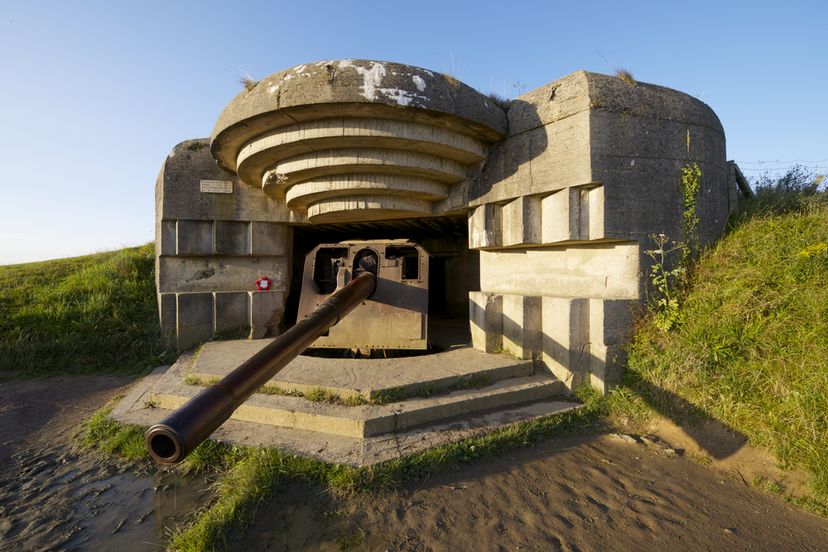
For those who are constantly glued to the World War II documentaries on the History Channel and have read countless books and articles about Allied tactics and strategic movements on the European fronts, a visit to Europe is the next step in your historical education. Personally seeing and physically standing on the many sites that were significant to that time will provide an unparalleled perspective and insight into the facts you already know about the war, as well as offer new information that is sometimes hard to come by from secondary sources. So for all the history buffs out there, here are 15 sites significant to the Second World War that, ranging from inspirational to overwhelming, are worth visiting in Europe:
15. Sachsenhausen Concentration Camp, Germany
This work camp just outside of Berlin is found about three km from the location of the first ever Nazi concentration camp known as Oranienburg (now destroyed). The camp became the center of Nazi operations and is now a museum detailing the life of the inhabitants, both officers and detainees in a number of exhibits. Visitors can also see the special exhibition dedicated to the Oranienburg camp found in the museum’s permanent exhibit, and walk the ground of the camp for an incomparable lesson in the severity of the Nazi aggression.
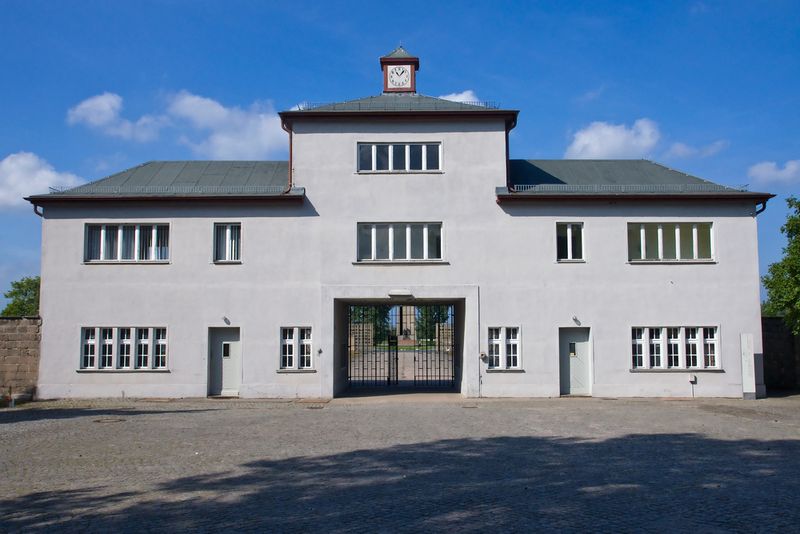
14. Arnhem Bridge, Netherlands
This bridge became well known after the strategic operation known as Operation Market Garden, whereby the Arnhem Bridge was the last in a string of strategic points targeted for takeover by the Allied forces. Successful up until that point, the Allies were unable to capture the bridge in the September 1944 Battle of Arnhem, an event that later became the subject of several books and the Hollywood film “A Bridge Too Far.” Surviving the September battle, the bridge was destroyed by Allied troops in October of the same year to help curb the transport of German supplies. In 1949 the bridge was rebuilt in the same style, and in 1977, renamed “The John Frostburg” in honor of the British commander that defended it in the September battle.
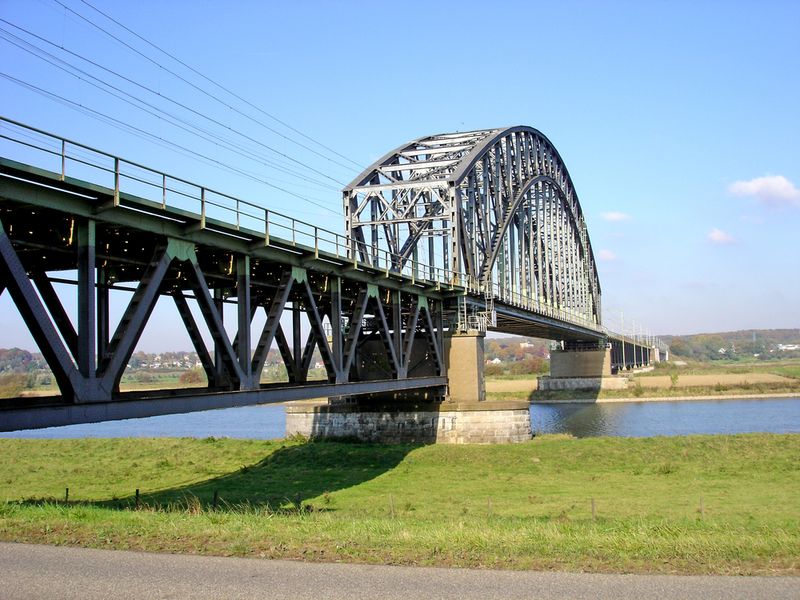
13. Oskar Schindler’s Enamel Factory, Krakow, Poland
As many who have read the Thomas Keneally’s novel “Schindler’s List” or seen the Spielberg movie of the same name know, Oskar Schindler was a Nazi Party member who saved hundreds of Jewish lives through political bribery and Jewish employment at his enamel and munitions factories. The administrative building of the enamel factory still stands today, and houses the Krakow Museum of Contemporary Art, as well as the Historical Museum of the City of Krakow, which is mainly devoted to the Party member and the lives of “his Jews.” This museum is must-see for anyone who wants to learn more about the life of a man now largely regarded as a hero.

12. Humboldthain Flak Tower, Germany
Originally constructed as a solution to air-strike vulnerability, German Flak Towers were domineering concrete complexes that sheltered anti-aircraft guns and protected ammunition from falling bombs. The towers operated in pairs, one a gun tower (Gefechsturm or G tower) and the other a command tower (Leitturn or L tower). Their heavily reinforced structure also served as bomb shelters for civilians as well as an extremely effective defensive center, with a radar dish that could detect bombers from over 50 miles away, eight 128-mm cannons with a firing capacity of 48 shells per minute and a number of other smaller cannons scattered around the tower. Many of the towers have since been destroyed or converted, but the one remaining in Berlin is open to visitors.
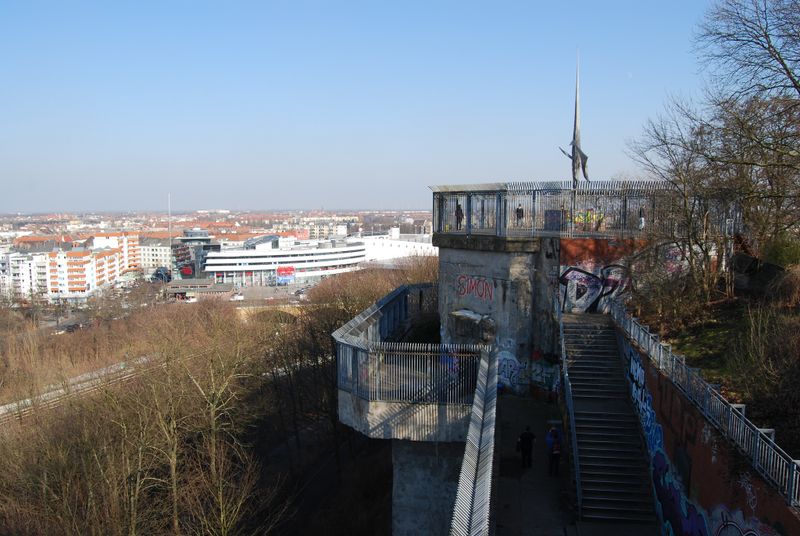
11. Vel D’Hiv Monument, France
Though the actual building of the Velodrome d’Hiver (indoor cycling track) was destroyed and replaced by government buildings, visitors can still stand on the spot, commemorated by a plaque, where in July of 1942, Jewish families in France were rounded up by the French police and forcibly herded into the Velodrome. It is there that over 13,000 citizens waited in deplorable conditions (without food, water or washroom facilities) for days before being dispersed among various concentration camps. A memorial to the victims was erected in the city in 1993, with the French Government issuing a public apology at a memorial service at the site in 1995.

10. Oradour-Sur-Glane, France
This small village in western France is memorialized as the site of one of the largest Nazi massacres on French soil. On June 10, 1944 SS officers stormed the village and killed the vast majority of residents, some 642 men, women and children, before largely destroying the area. Though officially rebuilt a few km north, the French government ordered the original site to be untouched and to stand testament to the horrors committed there. Visitors can walk through the ruins of the ghost town and pay their respects at the onsite memorial.
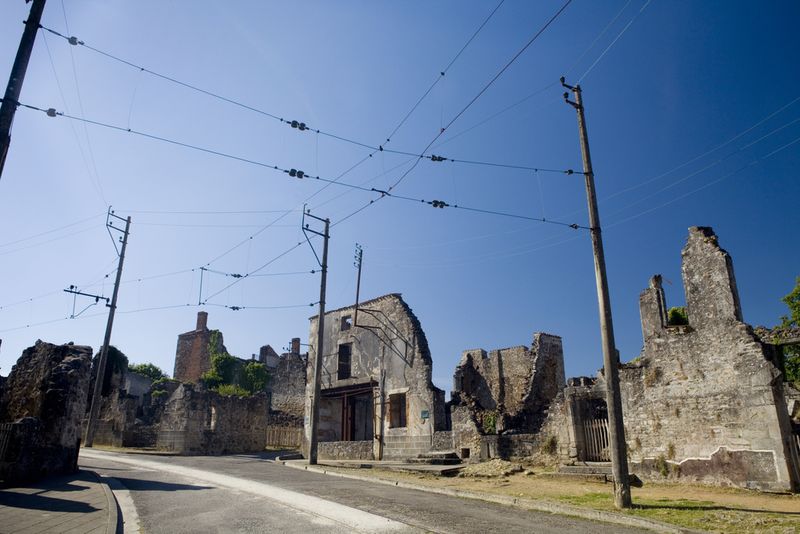
9. Umschlagplatz, Warsaw, Poland
During German occupation, the German-named Umschlagplatz (“reloading point”) was the Square in Warsaw used to round up Polish Jews and organize their deportation from the Ghetto to the Treblinka concentration camp. People waited in hordes for hours until enough detainees were rounded up to fill the train cars, with any signs of resistance resulting in instant death. Today, the site of the former Square is home to a memorial constructed in the image of train cars, erected to pay tribute to the countless lives doomed (and lost) on these very premises.

8. Warsaw Ghetto, Poland
In the beautiful Polish city of Warsaw, there still stands a testament to the largest and deadliest Nazi-created Ghetto in Europe. By the deadline of October 15, 1940, the city’s large Jewish population was forcibly required to move into an 18 km area which enclosed 73 of the city’s 1800 streets, and was divided into the “small” and “large” ghettos linked by a wooden bridge. At highest capacity, the Ghetto housed about 380,000 people, translating to about eight residents per room. Today, the site is commemorated by “The Footbridge of Memory” which denotes the location of the original bridge between the two Ghettos, several monument and memorials. The area also still contains chunks of the original separating wall as well as decrepit residential buildings which have stood untouched for the past seven decades.

7. The Wolf’s Lair, Poland
This major complex hidden among a dense Masurian forest was Hitler’s first headquarters on the Eastern Front, and became his most frequently inhabited hideout (he spent about half the war here). Originally built for the impending invasion of the Soviet Union, the property became a sort of small town consisting of shelters, barracks, two airfields as well as a power and rail station. Despite being heavily reinforced and highly secure, this was also the site of the infamous July 1944 assassination attempt of Hitler by Claus Von Stauffenberg. The premises were vacated and destroyed by German officials in January of 1945 and remained untouched by the Polish Government until the fall of Communism. Today, the site is in ruins but has become a popular tourist attraction with a handful of hotels and restaurants now available in the remote area.

6. Bletchley Park, England
Featured in the film “The Imitation Game,” Bletchley Park in Buckinghamshire was Britain’s central site for code breaking during the Second World War. As the location of the Government Code and Cypher School (GC&CS), it became the largest and most successful institution in penetrating secret Axis communications, most famously of the German Enigma and Lorenz ciphers. Analysis now suggests that the efforts conducted on these premises shortened the war by about 2 years, and the school is now an educational and historic attraction commemorating the accomplishments of the institution.

5. Fuhrerbunker, Berlin
Now largely destroyed, this bunker was located under the former Reich Chancellery building in the heart of the city, and is the site where Hitler spent the last few weeks of the war, married Eva Braun and committed suicide in April of 1945. Located 11.5 feet below ground level, the bunker was a system of 30 small rooms protected by 13 foot thick concrete walls with an exit point in the Reich Chancellery gardens. Today, the site looks inconspicuous enough as a quiet residential neighborhood, and is largely unmarked save the small plaque and information board that denotes the location and provides a schematic diagram of the bunker.
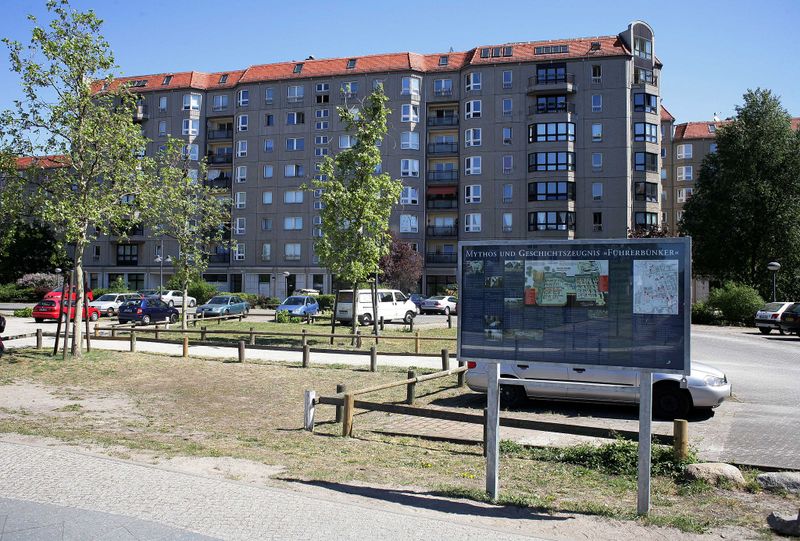
4. Cabinet War Rooms, England
Partially restored and opened as a museum to the public in 1985, the Cabinet War Rooms were originally a secret complex under the basement of the Treasury. The bomb blitz of December 1940 forced the complex to be reinforced as a bomb bunker, becoming the main strategic headquarters for the War Cabinet (consisting of Prime Minister Churchill and several Conservative and Labor Party ministers). Today visitors can descend below the streets of Westminster and check out the various rooms of the complex as they would have existed during the war, and of especial significance, the Map Room, which remains exactly as it was when the premises were closed and vacated in August of 1945.
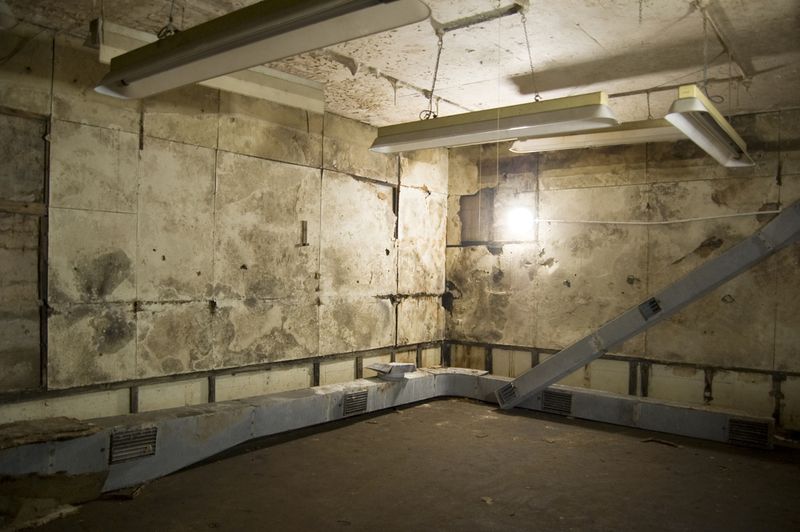
3. Auschwitz- Birkenau, Poland
Originally built in 1940 as a detention center for political prisoners, Auschwitz-Birkenau became the Nazi’s most gruesome legacy—the largest death camp and the primary site for the “Final Solution.” Located on the site of a former military base just outside of Krakow, Poland, the complex was regarded as the ideal location to carry out Nazi atrocities because of its proximity to the rail lines used to transport prisoners. Liberated on January 27, 1945 by the Soviet Army, estimates suggest that upwards of 1.1 million deaths were carried out on the property. Today, Auschwitz is a harrowing museum complex not for the faint of heart. While undeniably an important site to see, visitors are urged to check out the museum website ( http://visit.auschwitz.org/ ) to familiarize themselves with the rules, entry pass guidelines and capacity restrictions before their visit.
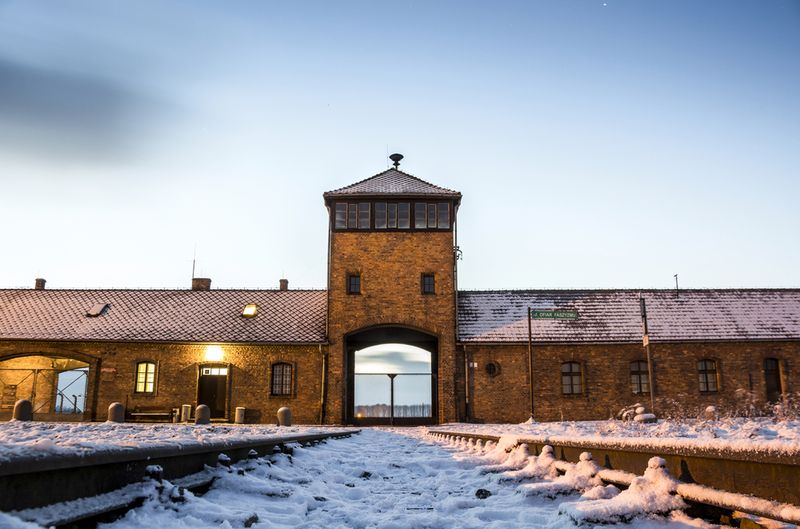
2. Musee de la Reddition, France
This red brick schoolhouse just northwest of the Reims train station is the historic site where, in the early morning of May 7, 1945 high officers from the German army met with officers of the Allied forces and signed the declaration of unconditional surrender, ending the second world war in Europe. Now known as the Lycee Roosevelt, the property was being used as the headquarters of Supreme Allied Commander in Europe, General Dwight D. Eisenhower, and the room where the signature took place, the map room, remains perfectly preserved behind a glass panel and comprises the museum now called the Musee de la Reddition.

1. Normandy, France
It is on this stretch of beaches on the Normandy coast where the infamous D-Day Landings of June 6, 1944 took place, changing the course of the war to favor the Allies. The five beaches—Sword, Juno, Gold, Omaha and Utah—were where the forces of the French, British, Canadian and American armies successfully landed and commenced an operation that changed the tide of WWII in Europe. Today, visitors can pay their respects to the sacrifices made by these troops at the various memorials found on the beaches, at the military cemeteries of each army and learn more about the operation and strategy at the various museums and information centers.

Like this? Check out 10 Significant World War II Sites to Visit in Germany
Please copy/paste the following text to properly cite this HowStuffWorks.com article:
- Outdoor Activities
- Destinations
- Book Hotels, Flights & Cars
- Advertise With Us
- Cookie Settings
Copyright © 2024 MapQuest Holdings LLC, a System1 Company

- Escorted Tours
- Travel Requirements & Prep
- Privacy Policy
- Obtaining a Passport Book
- Travel Protection Plan
- Tour Contract
- Tourist Offices
- Currency and CC Information
- Physical Condition Guide
Included Features
Dates & prices.
- The Image Tours Team
- Superior Value
- Membership & Alliances
- Travel Agents
- Find a Travel Agent

16-day World War II Memorial Tour of Europe

NORMANDY, FRANCE
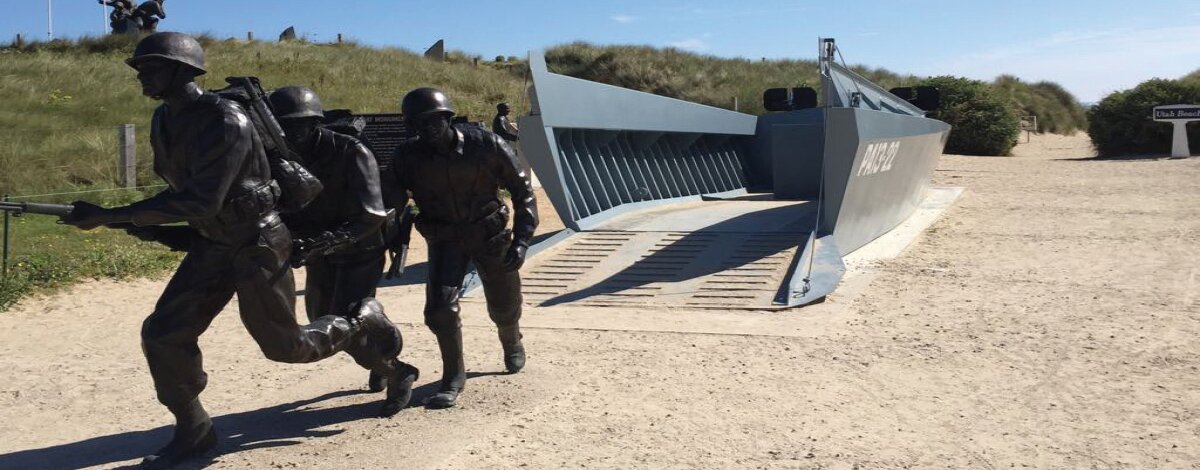
The Higgins boat monument at Utah Beach
Colleville-sur-mer, france.
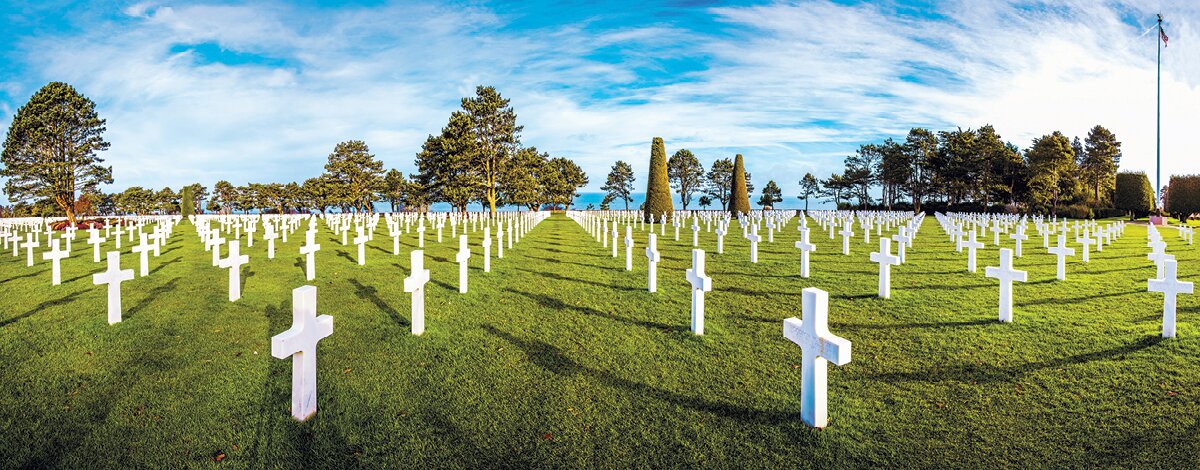
The American Cemetery near Omaha Beach honors over 9000 fallen soldiers
Paris, france.
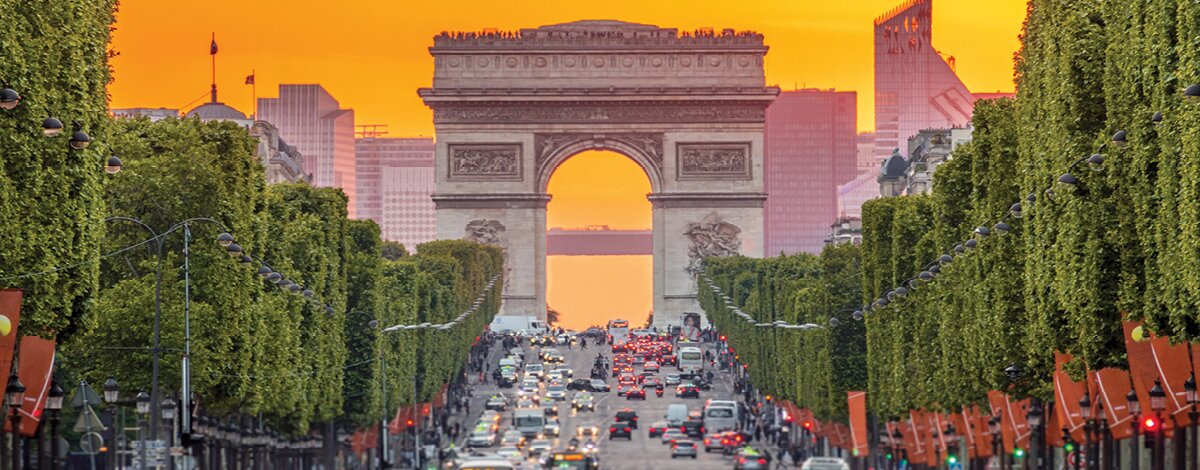
The Arc de Triomphe stands at the end of the famous Champs-Élysées Avenue
Amsterdam, the netherlands.
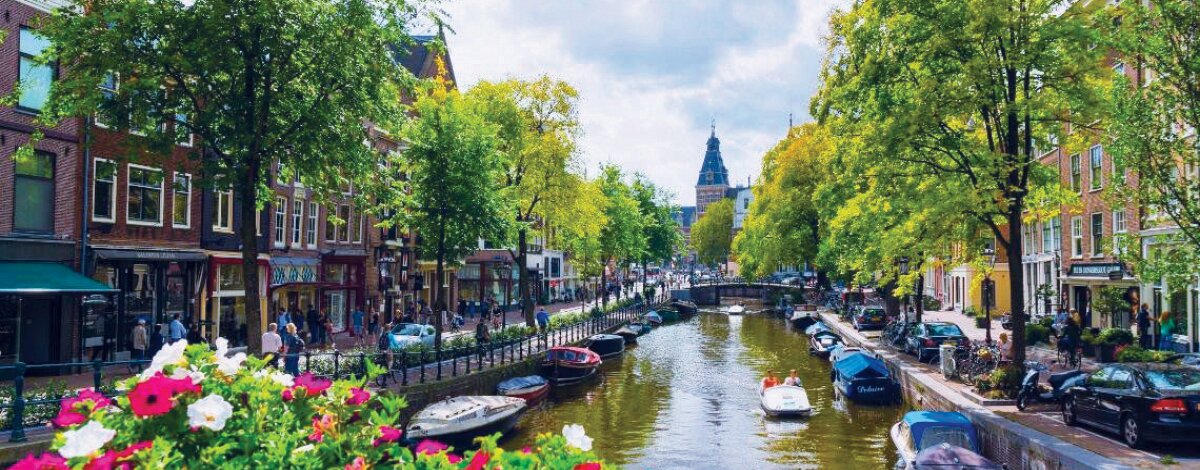
Quaint row houses line the canals of this influential city
Antwerp, belgium.
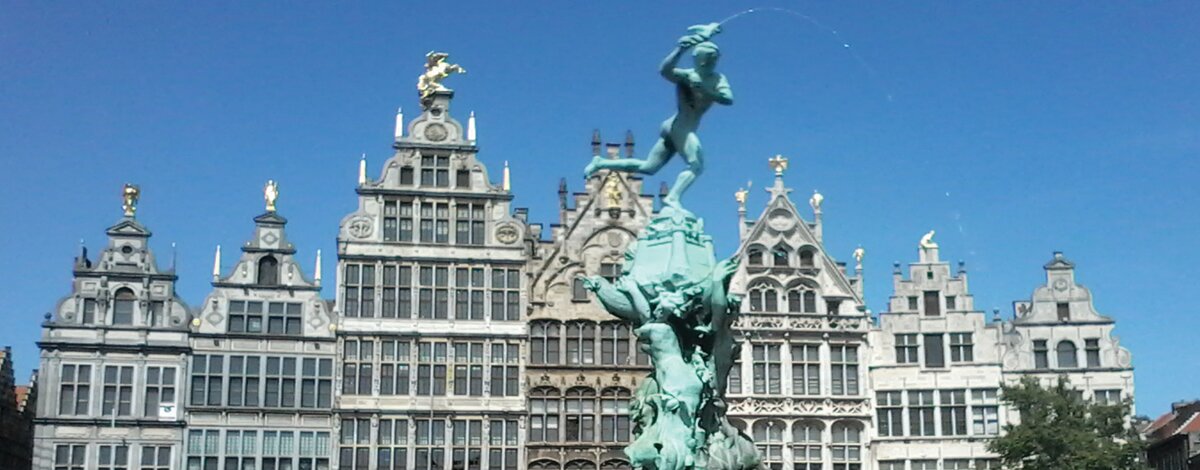
The main city square is lined with 16th-century Flemish Guildhouses
Dachau, germany.
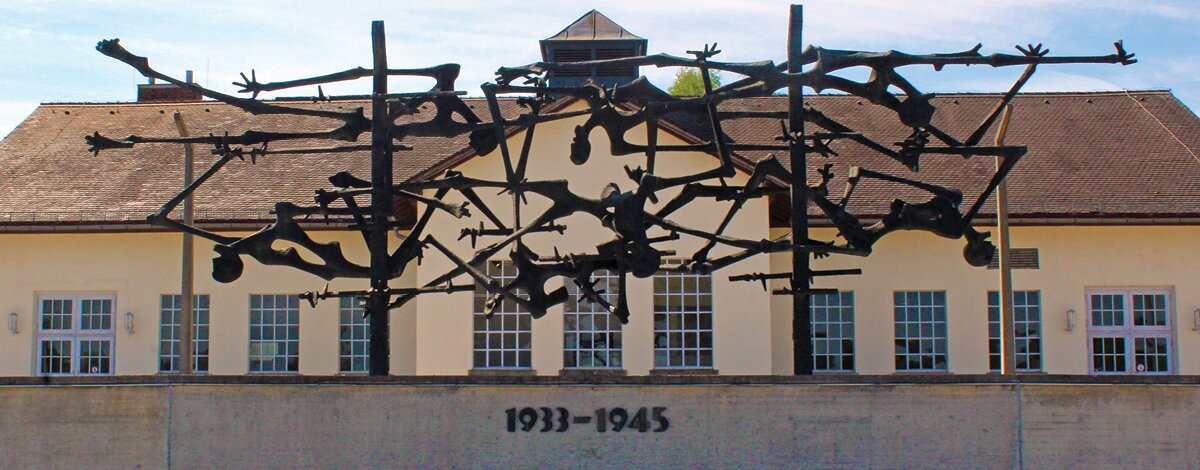
The memorial at Dachau Concentration Camp was designed by Holocaust survivor Nandor Glid
Munich, germany.
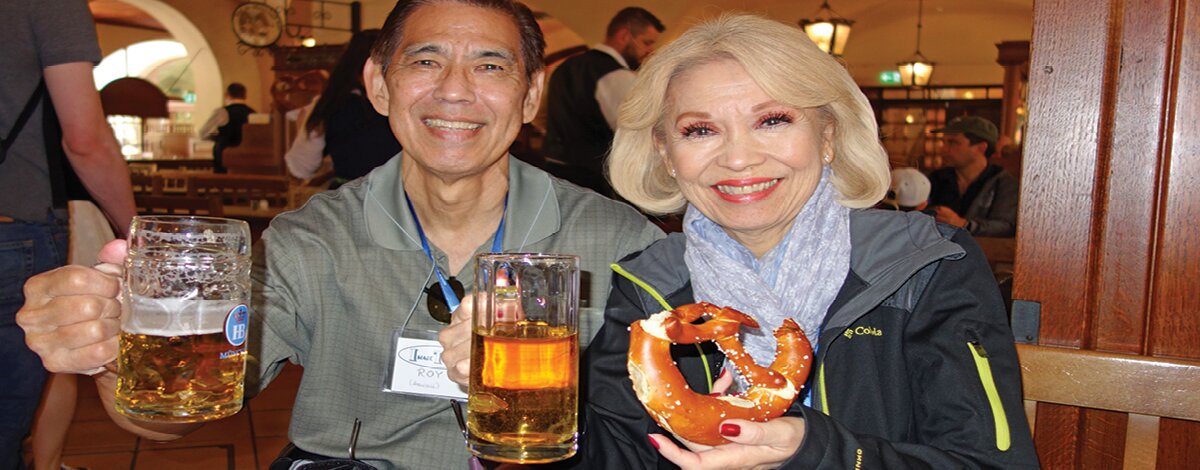
Get a taste of Oktoberfest all year round at the Hofbräuhaus beer hall
Caen, france.
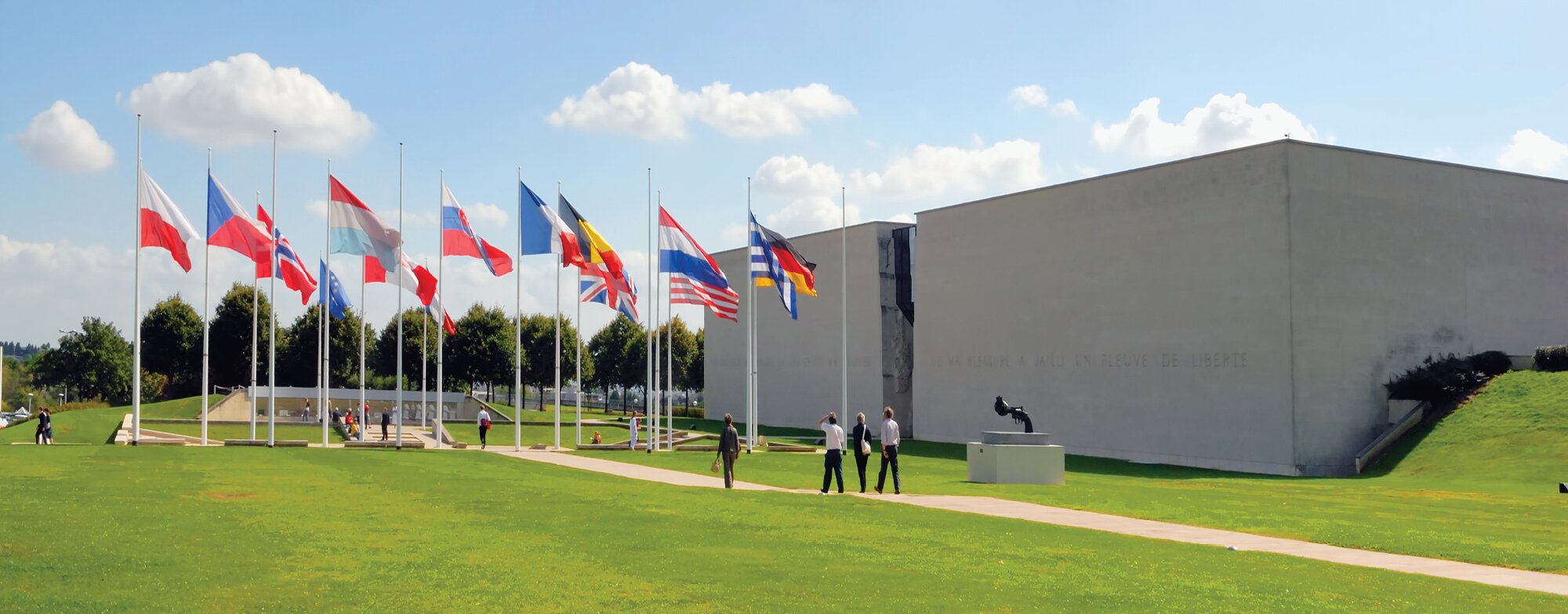
The Caen Peace Memorial & Museum
Nuremberg, germany.
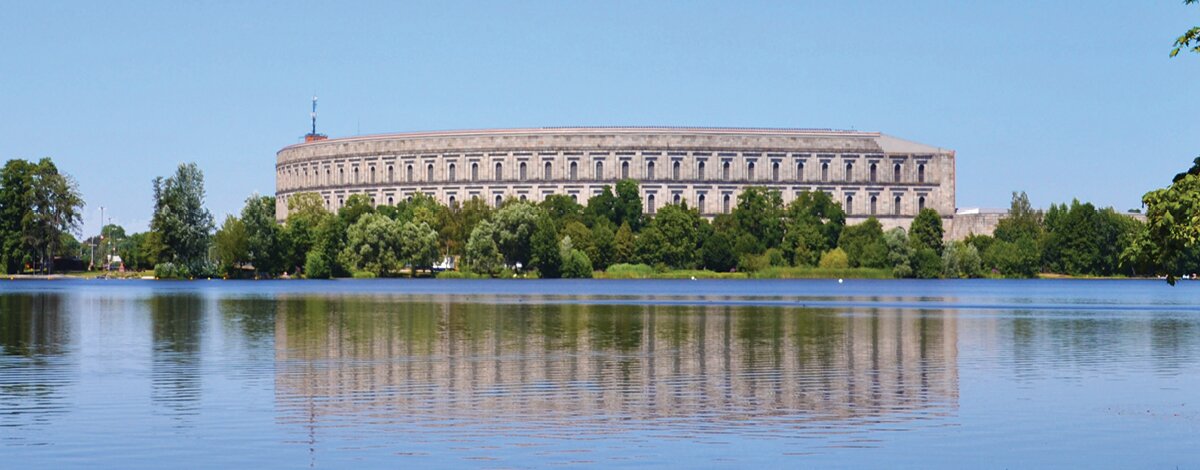
The colossal Congress Hall was built to seat the Nazi Party congress
Rhine river, germany.
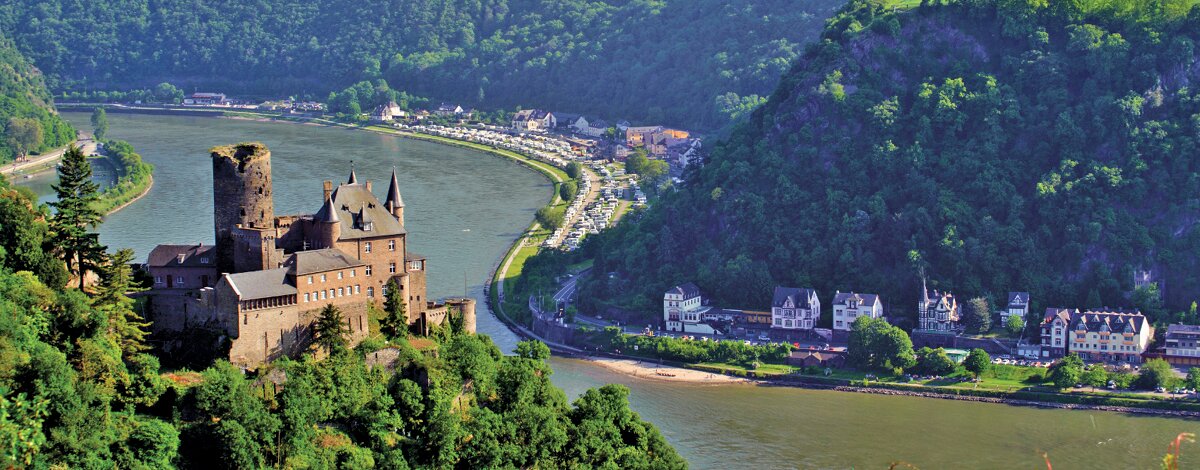
This legendary waterway is lined with castle ruins, vineyards, and romantic villages
Pricing disclaimer.
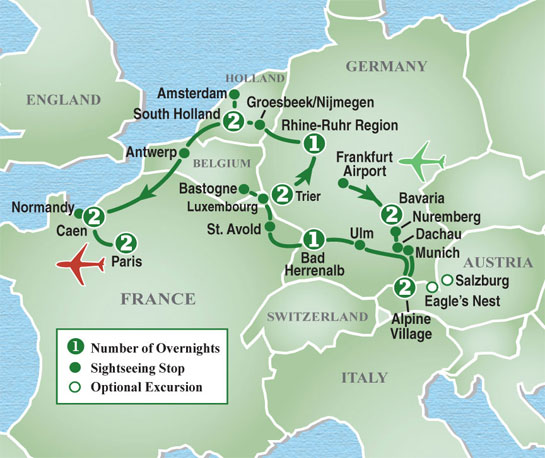
16-day tour featuring Germany, Austria, Luxembourg, Belgium, Holland and France. Revisit the dramatic history of World War II at famous battle sites, war museums and memorials. Many scenic and cultural highlights are also included, providing an enjoyable combination of learning and leisure.
Tour Year 2024
Tour itinerary.

DAY 1 - Overnight flight to Europe.
The Trip Documents will provide guidance for airport check-in and for your arrival in Europe. Relax on your transatlantic flight with the assurance that Image Tours has taken care of all the details.
DAY 2 - GERMANY . . Arrival at Frankfurt Airport – Bavaria.
Upon arrival, clear passport control and collect your luggage. Refer to the “Arrival Instructions” in the Trip Documents for directions on where and when to meet your tour manager. Settle into your comfortable motor coach on the way to your hotel in the scenic and festive state of Bavaria. Get acquainted with your fellow tour members during the “Welcome to Europe” dinner. (Dinner)
DAY 3 - GERMANY . . Nuremberg - Bavaria.
Your bus transfer into the city center introduces you to the history of Nuremberg. Hitler staged his propaganda rallies here and, after his fall, it was chosen as the location for the War Trials. You will have an opportunity to see the Nazi Party Rally Grounds, Congress Hall, and Palace of Justice where the War Trials were held. Consider the causes and consequences of Nazi Germany during a visit to the Documentation Center (visit the temporary exhibit during the 2023 renovations). Discover the Old Town’s half-timbered buildings and gingerbread shops before returning to your Bavaria hotel for dinner. (Breakfast, Dinner)
DAY 4 - GERMANY . . Dachau - Munich - Tyrolean Village.
Travel to Dachau for a somber visit to the Concentration Camp Memorial. At the entrance, you are prompted to reflect on the incomprehensible as your tour manager translates the German phrase on the iron gate: ARBEIT MACHT FREI (Work Makes One Free). Study the exhibit recounting the “path of the prisoners” and see the site of the former barracks. Your tour continues to Munich, the elegant capital of Bavaria. Pass points of interest, such as the Hitler Building, on your way to the Marienplatz, a pedestrian-only zone where historic buildings are cleverly interspersed with modern store fronts. The centerpiece of the square is the Rathaus (Town Hall) with its captivating Glockenspiel (clock tower). Following your visit to Munich, head south into the mountain range along the German/Austrian border, where you will spend the next two nights in a Tyrolean Village. (Breakfast, Dinner)
DAY 5 - GERMANY/AUSTRIA . . Tyrolean Village.
Enjoy a relaxing day in the surroundings of your hotel. Your Alpine Village offers a variety of options for leisure activities amid the spectacular mountain scenery. Another choice is to join the full day optional Salzburg & Eagle’s Nest with Dinner excursion (see Optional Excursions), which includes a guided visit to the Kehlsteinhaus, Hitler’s mountain hideaway, followed by an afternoon in Salzburg, known as Mozart’s birthplace and the setting for “The Sound of Music.” Spend a second night at your peaceful Tyrolean Village hotel. (Breakfast)
DAY 6 - GERMANY . . Ulm – Bad Herrenalb.
After breakfast, travel to Ulm to view the imposing Ulm Minster with the tallest church steeple in the world. This afternoon, make a stop at the grave of Erwin Rommel, the German general who was forced to commit suicide when Hitler suspected him of treason. End the day with a buffet dinner at your hotel in Bad Herrenalb, on the northern edge of Germany’s Black Forest. (Breakfast, Dinner)
DAY 7 - FRANCE . . St. Avold – Fort Hackenberg & GERMANY . . Trier.
Follow a scenic route through the Alsace Region and the Vosges Mountains. This area was the site of heavy fighting in the fall of 1944. You will make a stop at Lorraine’s American Cemetery in St. Avold, the largest American World War II cemetery in Europe. The afternoon is reserved for a tour of Fort Hackenberg, part of the Maginot Line, which was constructed between the world wars as a defense against any future German invasions. Your hotel for the next two nights will be in Trier, the oldest city in Germany, located near the three-country border of France, Luxembourg and Germany. (Breakfast, Dinner)
DAY 8 - LUXEMBOURG . . American Cemetery - Diekirch, BELGIUM . . Ardennes – Bastogne & GERMANY . . Trier.
The morning stop is at the American Cemetery in Luxembourg where General George Patton is buried. Continue into the Belgian Ardennes Region and arrive in Bastogne to view the star-shaped Mardasson Monument, a tribute to the soldiers who died in the Battle of Ardennes. You will also see the fox holes used by Easy Company, whose stories inspired the TV mini-series “Band of Brothers.” Your travels this afternoon take you to the Luxembourg National Museum of Military History in Diekirch. Trier's famous Porta Nigra provides an intriguing backdrop for your independent dinner before returning to your hotel. (Breakfast)
DAY 9 - GERMANY . . Rhine River – Remagen – Rhine-Ruhr Region.
Motor to one of the most beautiful stretches of the Rhine River where you will board a river steamer for a boat ride past endearing villages, medieval fortresses, and hillside vineyards known for producing the distinctive Rhine wines. Continue through the Rhine River Valley to Remagen to view the remains of the Ludendorff Bridge, the last standing bridge on the Rhine, which was captured by U.S. soldiers on March 7, 1945. By mid-afternoon, continue to your Rhine-Ruhr region hotel. Dinner will be served at the hotel this evening. (Breakfast, Dinner)
DAY 10 - HOLLAND . . Groesbeek – Nijmegen – South Holland.
Crossing the border, focus on sites significant to World War II liberation efforts in The Netherlands (Holland), including locations associated with Operation Market Garden. The bridge over the Waal River at Nijmegen was a strategic asset reclaimed after the historical crossing of American paratroopers. Travel Hell’s Highway and stop at the memorial in Overasselt, commemorating the site of the largest airborne operation of all time. This day will also feature a visit to one of the local museums documenting the World War II resistance in The Netherlands. Continue to your South Holland hotel for check-in and dinner. (Breakfast, Dinner)
DAY 11 - HOLLAND . . Amsterdam – South Holland.
Travel through Holland's countryside, characterized by canals, dikes and windmills, as you make your way to the dynamic city of Amsterdam. Your visit begins with a ride aboard a glass-topped boat through Amsterdam’s harbor and canals where you will see numerous bridges, boathouses and bicycles while gliding past 17th-century gabled houses. During an independent lunch, try a pannekoek (Dutch pancake) or other local specialties. This afternoon, walk to the main square, an ideal focal point for your individual exploration. Return to your South Holland hotel for dinner. (Breakfast, Dinner)
DAY 12 - BELGIUM . . Antwerp & FRANCE . . Caen.
Today consists of a full day of travel from Holland to Caen, France, with a stop in the port city of Antwerp, Belgium. Explore the central market square with its irresistible chocolate shops and convivial outdoor cafés serving Belgian Waffles. Continue the drive into France for an early evening check-in at your Caen hotel where dinner is served shortly after your arrival. (Breakfast, Dinner)
DAY 13 - FRANCE . . Normandy Landing Beaches – Caen.
The entire day is spent touring the famous Normandy Landing Beaches. From Caen, drive to the coast and stop at Pointe du Hoc to view the German fortifications. You’ll also travel to Utah Beach and Sainte-Mère-Église, the site where paratroopers landed during World War II as portrayed in the movie “The Longest Day.” Visit Sainte-Mère-Église Airborne Museum before continuing to Omaha Beach and the American Cemetery. Proceed to the artillery battery at Longues-sur-Mer. At today’s final stop in the village of Arromanches, view remnants of the artificial harbor and reflect on the sights of the day over an independent dinner. (Breakfast)
DAY 14 - FRANCE . . Caen – Paris.
Spend the morning touring the Caen Peace Memorial and Museum, established to honor the liberators, victims, and all those who continue to fight for peace. As you depart Caen, pause at the Pegasus Bridge to understand how its capture by the British 6th Airborne division was instrumental in deterring a German counterattack. Arrive in Paris by early evening and join your travel companions for a festive “Farewell Dinner” of enticing French dishes at an authentic Parisian bistro with roving musicians. The return transfer provides additional impressions of the city at dusk. (Breakfast, Dinner)
DAY 15 - FRANCE . . Paris.
The day is devoted to Paris, La Ville Lumìere ("City of Light"). On your way into the center, see the Arc de Triomphe which has been the staging area for victory parades throughout history including those following World War II. Your tour manager will also direct you to the location of other principal sights, such as the Notre Dame Cathedral, Eiffel Tower, and Louvre Museum (open every day except Tuesday). Before beginning your free time, we suggest joining the optional Seine River Cruise excursion (see Optional Excursions). Spend the evening exploring the Montmartre District, where Paris looks as it does in old paintings and artists still display their works. An uphill walk to the Sacré-Coeur Basilica rewards you with expansive views of the cityscape. Montmartre boasts excellent restaurants and characteristic sidewalk cafés perfect for an independent dinner in the French capital. (Breakfast)
DAY 16 - Daytime flight back to U.S.A.
Transfer to the Paris Airport for your return flight home. (Breakfast)
Travel Time
Overnight flight from the U.S.A. to Frankfurt.
Arrival at Frankfurt Airport . Meet your tour manager, board your deluxe motor coach and travel (1¾ hrs) through the Franconian Wine Region . After a rest stop, continue (1½ hrs) to your hotel located in the festive state of Bavaria for a "Welcome to Europe" dinner. ( Dinner )
During an introductory sightseeing (1 hr), experience the history of Nuremberg and view the site of the Nazi Party Rally Grounds, the Congress Hall, and the Palace of Justice where the War Trials were held. Return (½ hr) to your hotel in Bavaria for dinner. (Breakfast, Dinner)
DAY 4 - GERMANY . . Dachau - Munich - Alpine Village.
Depart Nuremburg (1¼ hrs) and after a morning stop travel (1¼ hrs) to Dachau Concentration Camp . In the afternoon continue (½ hr) to the elegant Bavarian capital of Munich . Depart Munich in the late afternoon and head south (2 hrs) to an Alpine Village hotel for dinner. (Breakfast, Dinner)
DAY 5 - GERMANY/AUSTRIA . . Alpine Village.
Enjoy a day of leisure or join your tour manager for the full day optional Salzburg & Eagle's Nest with Dinner excursion, including a guided visit to Hitler's mountain hide-a-way (1 hr), sightseeing in Salzburg (½ hr) and an authentic Austrian dinner (1 hr) before returning (1 hr) to your Alpine Village hotel. (Breakfast)
Return to Germany (2 hrs) and after a morning stop proceed (1½ hrs) to Ulm for an independent lunch and views of the imposing Ulm Minster. Next, travel (1 hr) to the Rommel Memorial. Continue (2¼ hrs) to Bad Herrenalb , on the northern edge of Germany's Black Forest. (Breakfast, Dinner)
DAY 7 - FRANCE . . St. Avold – Fort Hackenberg & GERMANY . . Igel.
Follow a scenic route (1¾ hrs) through the Alsace Region and Vosges Mountains. On to (1 hr) Lorraine's American Cemetery, the largest American World War II cemetery in Europe. From here continue (1 hr) to Fort Hackenberg , part of the Maginot Line. After a visit, continue (1½ hrs) to your hotel in Igel . (Breakfast, Dinner)
DAY 8 - LUXEMBOURG . . American Cemetery - Diekirch, BELGIUM . . Ardennes – Bastogne & GERMANY . . Trier – Igel.
It's a short ride (¾ hr) to the American Cemetery in Luxembourg . Drive (1½ hrs) through the Belgian Ardennes Region and arrive in Bastogne . In the afternoon travel (¾ hr) to the Luxembourg National Museum of Military History in Diekirch . Transfer (1 hr) to Trier , the oldest city in Germany, for an independent dinner before returning (¼ hr) to your hotel in Igel . (Breakfast)
In the morning, travel (2 hrs) to the legendary Rhine for a boat ride along one of the most beautiful stretches of the river. After disembarkation, proceed to Remagen (1 hr) to view the Ludendorff Bridge. Continue (1¼ hrs) to your hotel in the Rhine-Ruhr Region . (Breakfast, Dinner)
Cross the border (2¼ hrs) on the way to Nijmegen to focus on the sites significant to WWII liberation efforts in the Netherlands. Visit (½ hr) one of the local museums before traveling (1½ hrs) through the Dutch countryside to your South Holland hotel. (Breakfast, Dinner)
Transfer (1½ hrs) to Amsterdam where a boat ride through the canals is followed by ample free time. In the evening, return (1½ hrs) to your South Holland hotel for dinner. (Breakfast, Dinner)
A full day of travel. Head south (1¾ hrs) into Belgium to visit the historic town of Antwerp . After free time in Antwerp, drive (2 hrs) to a lunch break near the French/Belgian border. Continue (2¼ hrs) to an afternoon stop in northwestern France. Just before dinner time, arrive (2 hrs) at your hotel in Caen . (Breakfast, Dinner)
The entire day is spent touring the famous Normandy Landing Beaches , including a visit to Pointe du Hoc, Utah Beach, Sainte-Mère-Église Airborne Museum and stops at Omaha Beach, the artillery battery at Longues-sur-Mer and Arromanches (travel time between stops varies from ¼ hr to ¾ hr). Short transfer (½ hr) back to Caen . (Breakfast)
Transfer (¼ hr) to the Caen Peace Memorial and Museum for a visit and then continue (½ hr) onto the Pegasus Bridge. Stop for lunch (1¾ hrs) in the French countryside on the way (1¾ hrs) to Paris . Spend the evening in the Montmartre District, an ideal place for your independent dinner (¼ hr). (Breakfast)
A full day for individual exploration (¾ hr transfer in each direction) of Paris , during which you may wish to join the optional Seine River Cruise excursion. This evening, join your travel companions for a festive “Farewell Dinner” at an authentic Parisian bistro. (Breakfast, Dinner)
Transfer (1 hr) to Paris Charles de Gualle Airport for your flight home. (Breakfast)
Favorite Traveler Experiences
- View Hitler’s Nuremberg Rally Grounds with solemn contemplation
- Examine the eye-opening exhibits at Dachau Concentration Camp
- Listen to the chiming of the Glockenspiel on Munich’s main square
- Tour part of the Maginot Line defense structure at Fort Hackenberg
- Explore Bastogne, synonymous with the “Battle of the Bulge”
- Glide past castles and vineyards on a scenic Rhine River boat ride
- See first hand the Eiffel Tower and Arc de Triomphe in Paris
- Take a serene boat tour through the famed canals of Amsterdam
- Tour the Normandy Landing Beaches and Military Cemetery
- Accommodations in Superior Tourist Class or First Class hotels
- 14 Breakfasts and 10 Dinners in addition to any in-flight meals
- Tour Manager for the full European duration of the tour
- Land Transportation in Europe by deluxe, air-conditioned motor coach
- Image Tours Touroclopedia® trip preparation tips
- Trip Documents with luggage tags, final details and travel guidance
Traveler Reviews
The Availability, Departure Dates, and Rates are for illustration and planning purposes only. Since final pricing and single availability can only be confirmed with a travel agent, steps 4 & 5 of this on-line booking module is reserved for your travel agent only. (Please Call) indicates that we still have some tour availability; however, you should have your travel agent call our office to confirm air availability.
Select Departure Month
Upcoming departures, may 08, 2024, may 23, 2024, $4,940 p.p.d.o., jun 12, 2024, jun 27, 2024, sep 04, 2024, sep 19, 2024, sep 11, 2024, sep 26, 2024, may 07, 2025, may 22, 2025, $4,990 p.p.d.o., jun 11, 2025, jun 26, 2025, sep 03, 2025, sep 18, 2025, oct 01, 2025, oct 16, 2025, tour hotels.

NH Collection Nürnberg City
- Air Conditioning
- Satellite TV
- In-Room-Safe

Seminaris Hotel Nuremberg
- satellite TV
- in-room safe
- fitness center
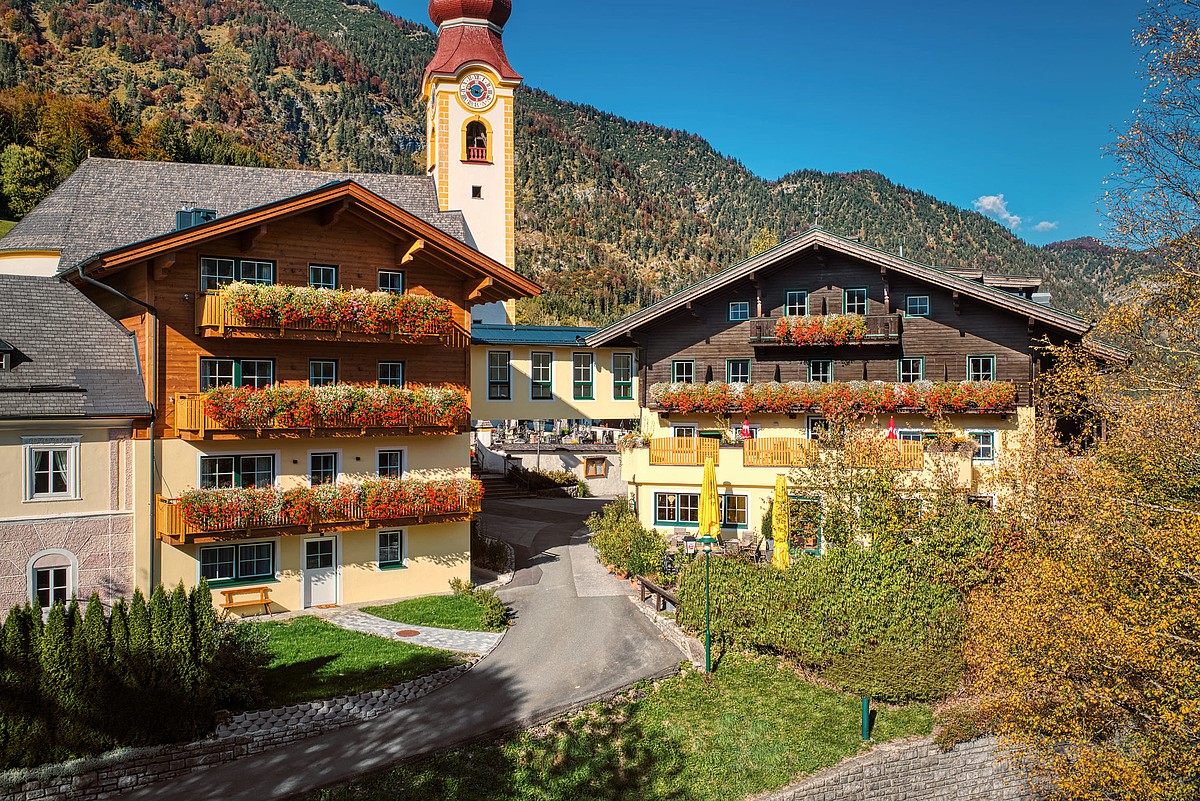
Landhotel Kirchenwirt
- wellness area

Parkhotel Luise Bad Herrenalb
- indoor swimming pool
- safety deposit box at reception

Vienna House Easy Trier
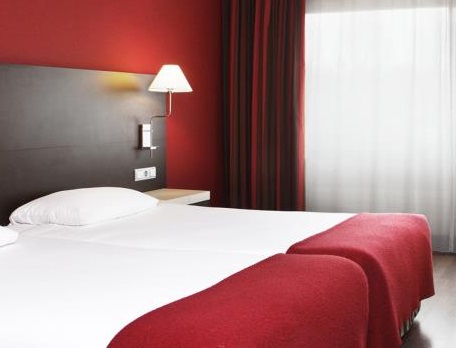
NH Hotel Capelle
- air conditioning
- in room safe
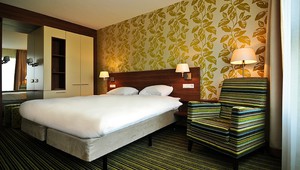
Van der Valk hotel Ridderkerk
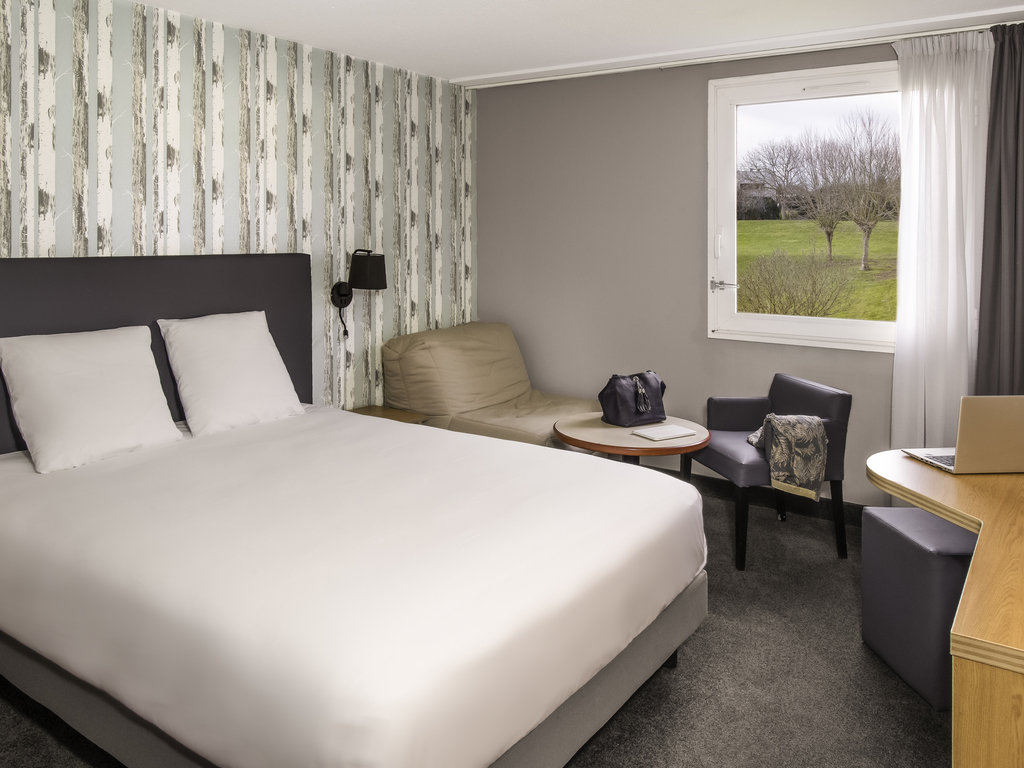
Mercure Caen Côte de Nacre
- restaurants
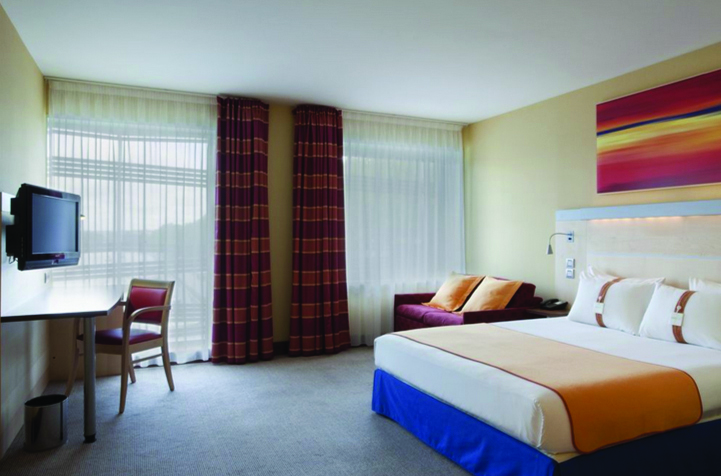
Holiday Inn Express - Canal de la Villette
- internet center
Optional Excursions

OPTIONAL EXCURSIONS DETAILS
Our tours are carefully planned to offer a comfortable balance of sightseeing, entertainment and leisure time. Optional Excursions provide the flexibility to choose between leisure time or additional guided sightseeing activities. Unless otherwise noted, optional excursions must be booked with and paid to your tour manager during the tour. Prices are in U.S. Dollars. MASTERCARD®, VISA®, or DISCOVER® (no other credit cards are accepted) are recommended to avoid carrying excessive cash and exchange rate fluctuations. You must be able to present the actual card to your tour manager. If you bring a DISCOVER® card, also bring a VISA® or MASTERCARD®, as DISCOVER® is not widely accepted in Europe. Cash payments during the tour must be in Euros. Personal checks and traveler’s checks are not accepted. The operation of all excursions is subject to sufficient participation, and some excursions are subject to favorable weather conditions. Your tour manager reserves the right to make changes or cancel excursions at their sole discretion.
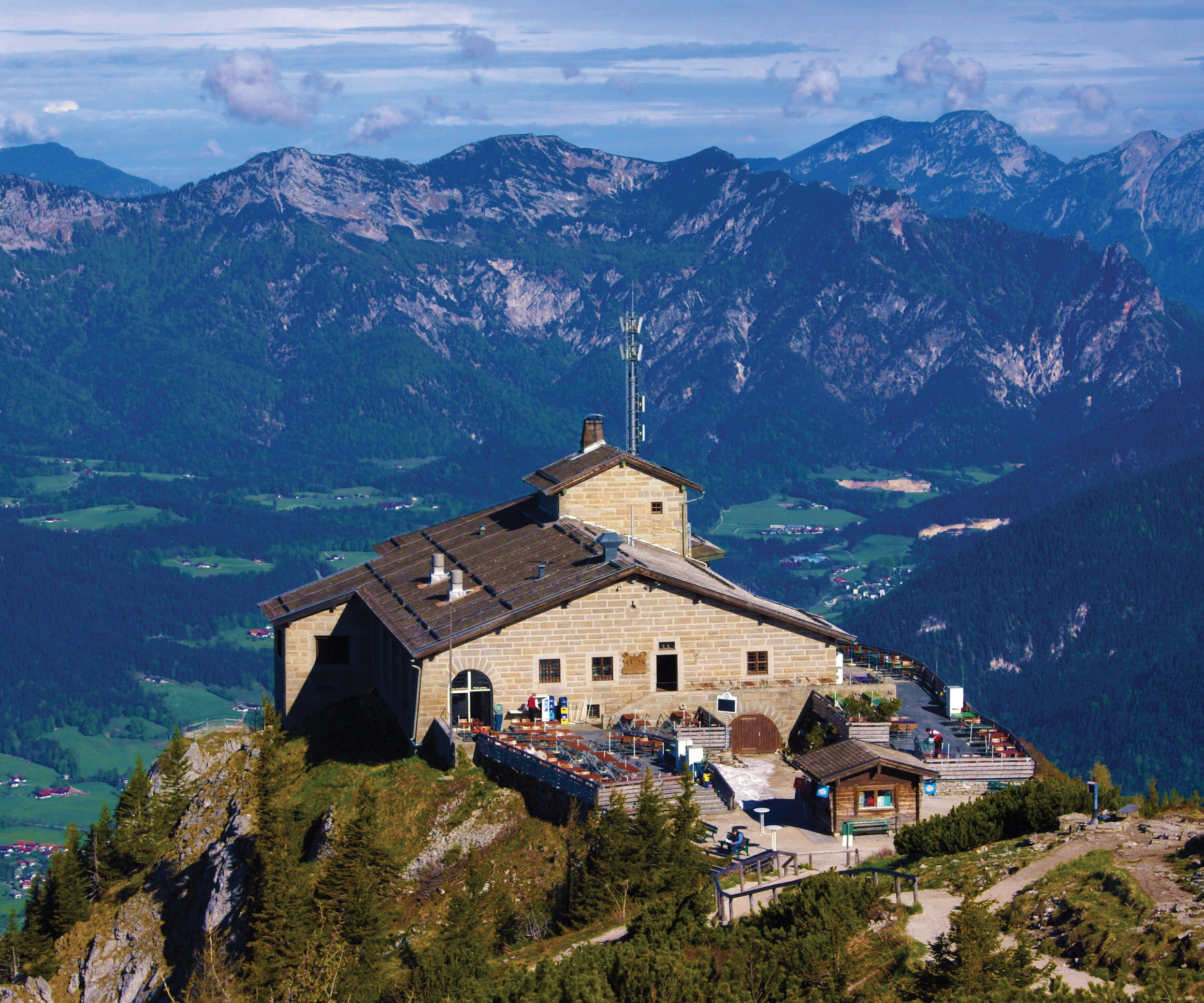
SALZBURG & EAGLE'S NEST WITH DINNER
Upon arrival in Berchtesgaden, Germany, you will take a bus and elevator up to the Eagle’s Nest, Hitler’s mountain hide-away. In the case of halted bus operation, we will substitute a visit to the Obersalzburg Documentation Center. After an independent lunch, become acquainted with nearby Salzburg, famous home of the “Sound of Music” and Mozart. This excursion includes a traditional Austrian dinner at an alpine village restaurant.
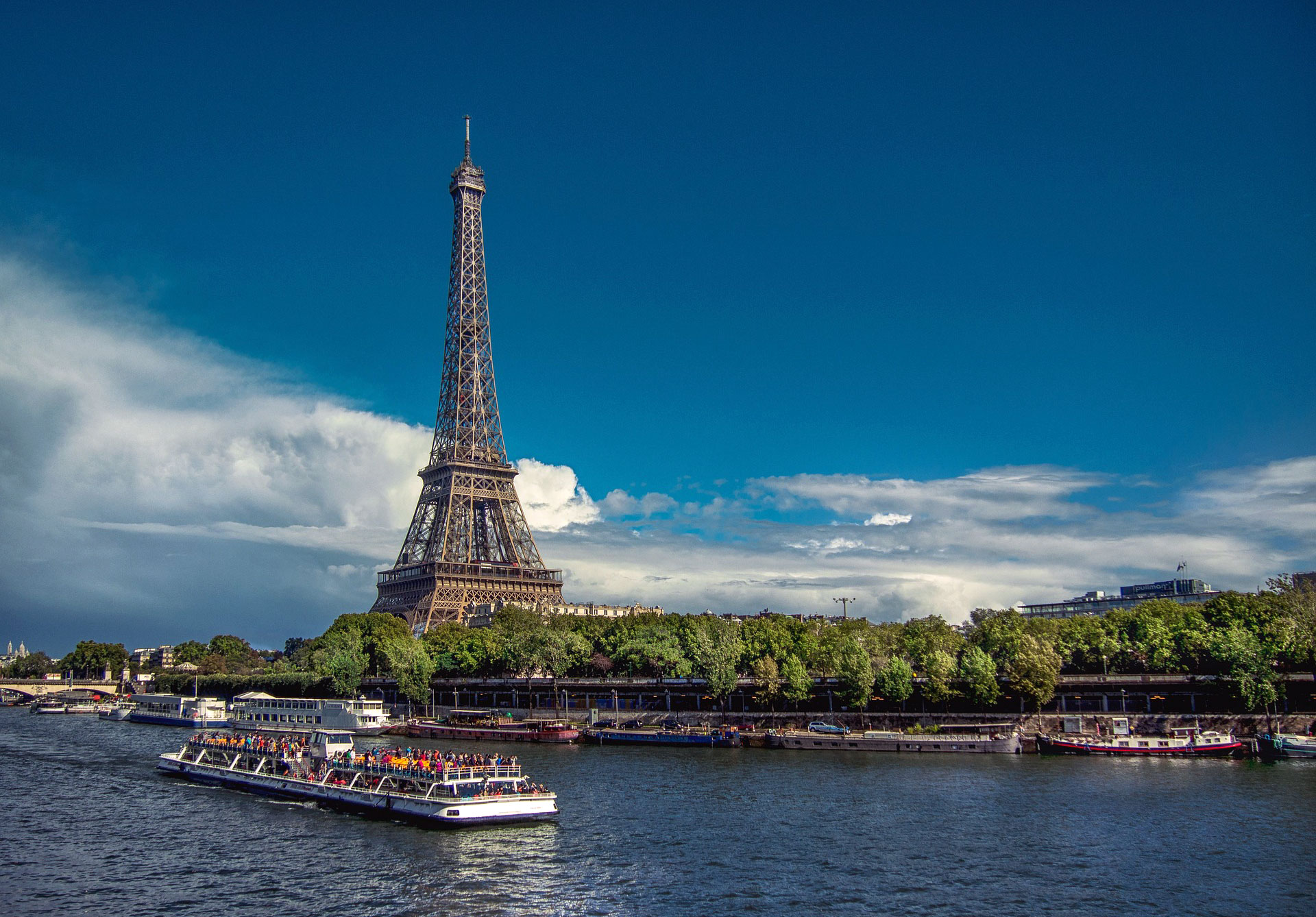
SEINE RIVER CRUISE
Glide along the Seine River by boat, while viewing the Eiffel Tower, the Louvre, the Notre Dame Cathedral, and several other impressive sights in Paris. This excursion provides for excellent photo opportunities.
Tour Extensions
Paris post-tour extension, paris and london post-tour 3-night extension, tour year 2025, 16-day world war ii memorial tour of europe map.
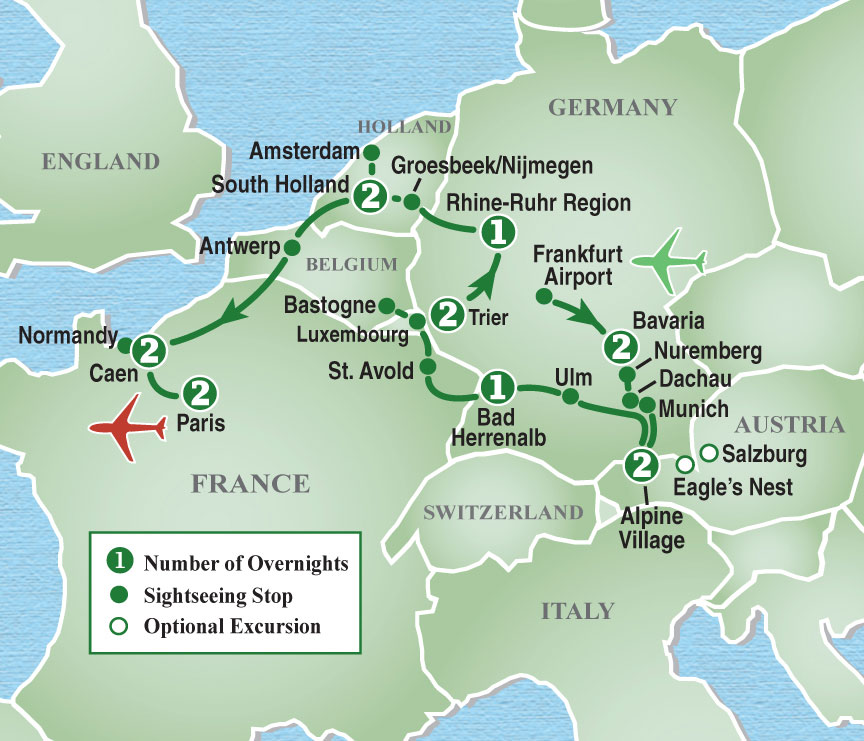
- - K-town Now
- Asia-Pacific
- - Storm Tracker
- Middle East
- Map of Memorials
- Entertainment
- - Video Games
- Europe Travel
- - Quick Trips
- - After Hours
- Pacific Travel
- The Meat and Potatoes of Life
- U.S. Travel
- Storm Tracker
- Rewards for readers
- Get Stripes
- Stripes Lite
- Archives/Library
- Special Publications
- Mobile Apps
- Email Newsletters
- Digital Access
- Home Delivery
- Marine Corps
- Coast Guard
- Space Force
- Archive photo of the day
- - Schedules Europe
- - Scoreboards Europe
- - Schedules Pacific
- - Scoreboards Pacific
- - Pacific Sports Blog
- - Military Matters
- - Force for Hire
- Out of Uniform
- Communities
- Stripes Europe
- Stripes Guam
- Stripes Japan
- Stripes Korea
- Stripes Okinawa
- Our Other Websites
- In Memoriam
- Month of the Military Child
- Best of Germany
- Best of the Pacific
- Letters to Santa
- Disposal crews remove WWII bombs found in German town near US bases
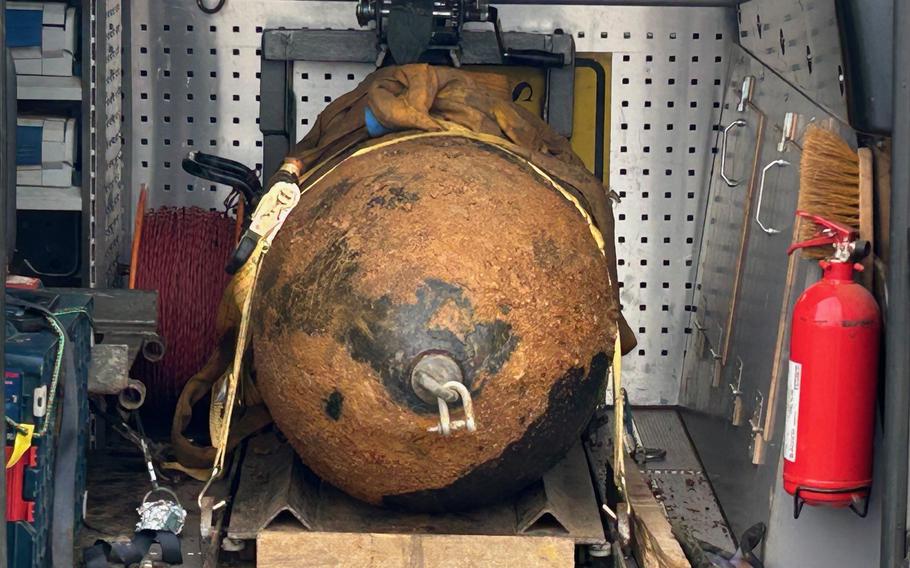
A roughly 1,000-pound American World War II aerial bomb is secured after being defused by specialists in a section of Amberg, Germany, Thursday, April 4, 2024. (Oberpfalz police station)
GRAFENWOEHR, Germany — Specialists defused two American World War II-era bombs Thursday near a decommissioned train station outside the Bavarian city of Amberg.
The roughly 1,100- and 1,000-pound aerial bombs were discovered by a German construction company around 5:45 p.m. Wednesday next to the closed Amberg-Nuremberg railway line in Luitpoldhöhe, according to a statement Thursday from Bernhard Scheimer, first chief superintendent of the Upper Palatinate police.
The bombs pose no immediate danger to the neighboring U.S. Army installations at Grafenwoehr and Vilseck, said Dominik Lehmeier, a senior police commissioner in Amberg. The city is a popular destination for U.S. troops and their families who work on installations nearby.
After the bombs were uncovered, police set up a half-mile cordon and 500 people in the area were temporarily evacuated, the statement said. Operations were discontinued at an adjacent foundry.
The 1,100-pound bomb, measuring 3 feet in length and 20 inches in diameter, was defused Thursday at around 1 a.m., Lehmeier said. The three-man disposal crew was hampered in defusing the second bomb by flooding and shifting soil in the 13-foot-deep excavation pit. The all-clear came at 3:40 p.m. Thursday.
The second bomb “kept us busy for quite some time, but it has been safely defused,” Lehmeier said.
Luitpoldhöhe is approximately 2 miles northwest of Amberg’s city center. The foundry and its connecting rail line made the site a target for Allied bombers during World War II, Lehmeier said.
Technicians in Germany disarm close to 5,000 bombs annually, the national explosive ordnance disposal agency KSU said on their website. Approximately 100,000 tons of unexploded ordnance are still believed to lie hidden beneath urban areas and farmland.

previous coverage
- American WWII bomb found on construction site nearby US bases in Germany
- Massive WWII bomb discovered and defused in German city hosting US military
- Workers discover 1,000-pound bomb from Korean War at construction site
- Smoking unexploded ordnance from Korean War found near Yongsan Garrison
Sign Up for Daily Headlines
Sign up to receive a daily email of today's top military news stories from Stars and Stripes and top news outlets from around the world.
Sign Up Now
Germany's defense minister overhauls the military command as he seeks 'war-capable' armed forces
Germany’s defense minister has announced a plan to streamline and reorganize the country’s military command as part of efforts to make the armed forces of NATO’s most populous European member “war-capable.”
BERLIN -- Germany's defense minister on Thursday announced a plan to streamline and reorganize the country's military command as part of efforts to make the armed forces of NATO's most populous European member “war-capable.”
Chancellor Olaf Scholz set in motion a big increase in military spending shortly after Russia's full-scale invasion of Ukraine in early 2022, which he described as a “turning point.” Defense Minister Boris Pistorius last year took on the job of overhauling the military, the Bundeswehr, after years of neglect and in November called for a review of its structure.
Pistorius has pointed to the danger of a possible future Russian attack on a NATO country and said repeatedly that the German military must become “war-capable,” a choice of words that some in Germany find jarring given the country's longstanding post-World War II culture of military caution.
“I am convinced it is one of the few words that really describes correctly the imperative here,” he told reporters in Berlin. “I respect the fact that others struggle with the word, but I also note that most who do have no problem with the substance behind it.”
His overhaul plan envisions a single “operational military command," which he hopes will enable quick decisions and eliminate duplication. Currently, the Bundeswehr has two command centers: one responsible for planning and running deployments abroad and the other for the defense of Germany itself.
An existing “cyber and information” department, whose responsibilities include fending off cyberattacks, protecting electronic infrastructure and analyzing hybrid threats such as disinformation, will be expanded and officially become a fourth arm of the military alongside the army, air force and navy.
Speaking on NATO's 75th anniversary, Pistorius underlined “the challenge of resetting the Bundeswehr for a new and old challenge — that of defending the country and the alliance.”
In 2022, Scholz pledged to increase Germany's defense spending to a NATO target of 2% of gross domestic product — a mark that, along with several other countries, it had long fallen short of — and set up a 100 billion-euro ($108 billion euro) special fund to modernize the Bundeswehr.
“We have (spending of) 2% this year and we will reach it in the coming years as well, but also must reach it so that we can do justice to our responsibility and our role in NATO,” Pistorius said.
Details of how Germany will reach the 2% mark once the special military fund is exhausted, likely in 2027, remain unclear. And although progress is being made with orders for new equipment, the parliamentary commissioner for the military said last month that the Bundeswehr “still has too little of everything.”
Top Stories

4.7 magnitude earthquake rocks Northeast
- 4 minutes ago

Why April's total solar eclipse will be a historic event in the US
- Apr 4, 10:23 AM
Burglars steal $30 million in cash from Los Angeles money storage facility, police say
- Apr 3, 9:27 PM
What to know about LA's multimillion-dollar Easter Sunday cash heist
- Apr 4, 3:49 PM

Cruise ship carrying 1,500 passengers stuck in Spain port due to Bolivian passengers' visa problems
- Apr 3, 7:58 AM
ABC News Live
24/7 coverage of breaking news and live events
Watch CBS News
World War II bunkers built by German army unearthed during nature restoration project in Belgium
By Kerry Breen
Updated on: April 5, 2024 / 10:34 AM EDT / CBS News
Work on a nature restoration project in Belgium unearthed multiple bunkers, trenches and other structures built there by the German army during World War II, officials announced this week.
The restoration work is being done at the Director-General Willemspark in Heist, Belgium, and focuses on restoring coastal dunes in a less than one square mile area by removing invasive plants, according to a news release from area officials.
Heist, also known as Heist-Aan-Zee, is in the northern Flanders region of Belgium. The area was the site of multiple battles during World War I. The violence there was immortalized in the poem "In Flanders Fields," and inspired the use of a red poppy as a memorial symbol for those who died in the war.
There were two German gun batteries built on the site during World War I . One was called Freya, the other Augusta. Both batteries held guns, observation bunkers, crew quarters and "all kinds of trenches and barriers," officials said. Most such structures were demolished after the war, officials said.
But in 1942, the park was again converted into a military stronghold by German soldiers. At the peak of the work, there were about 60 structures in the area, including ammunition bunkers and crew quarters that were meant to help repel an incursion from the sea.
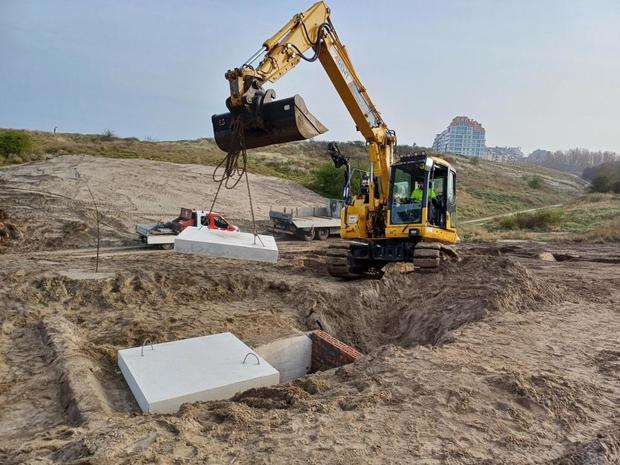
"Anyone who grew up in Heist will not be surprised that remains of war were also found during the excavations," said Heist officials in a statement announcing the finds.
Several structures from the World War II stronghold were found preserved in the ground, including "three completely intact bunkers" covered under just a few inches of dirt. Each bunker had just one room, but were built with walls and a ceiling of reinforced concrete.
Officials also found two brick trenches, a fragment of concrete track that would have been used to ferry soldiers and supplies during the war, and a water well. During the excavations, workers also found "large mountains of rubble" that contained everyday objects like utensils, ammunition and more.
"These ruins aptly illustrate the previous frantic attempts to completely erase the park's war history," officials said in the news release. "The lighter structures were demolished and reduced to rubble, while heavier bunkers were covered with a layer of soil and hidden, as if they had never existed."

More war constructions are likely in the park, outside the scope of the restoration work, officials said. No World War I relics were found during the project.
Archaeologists from the nation's heritage agency were on site to supervise the restoration work, officials said, and as the finds were made, they "mapped everything." However, the remains were covered again with sand once they had been thoroughly investigated.
"No one disputes that war remains have a heritage value, but this does not mean that every brick from the war must necessarily be preserved," officials said. The sand will preserve the remains for the future, according to the news release.
- World War II
- Archaeologist
- World War I

Kerry Breen is a reporter and news editor at CBSNews.com. A graduate of New York University's Arthur L. Carter School of Journalism, she previously worked at NBC News' TODAY Digital. She covers current events, breaking news and issues including substance use.
More from CBS News
Middle East Crisis U.S. Says Israel Must Show Results on New Aid Routes
- Share full article
- Tear gas was fired in Al-Aqsa Mosque compound where worshippers gathered for dawn prayers on Friday. Reuters
- A man being detained in Jerusalem’s Old City on the last Friday prayers of Ramadan. Ronen Zvulun/Reuters
- Muslim worshippers praying in the Al-Aqsa Mosque compound. Ahmad Gharabli/Agence France-Presse — Getty Images
- Palestinians at an Israeli checkpoint on their way to Al-Aqsa mosque. Hazem Bader/Agence France-Presse — Getty Images
- Palestinians prayed next to the ruins of a destroyed mosque in Rafah, Gaza. Haitham Imad/EPA, via Shutterstock
- Muslims making their way to the Al-Aqsa Mosque in Jerusalem. Leo Correa/Associated Press
- Women read the Quran at the Al-Aqsa mosque compound in Jerusalem. Ahmad Gharabli/Agence France-Presse — Getty Images
- Muslim worshippers near the Dome of the Rock in the Al-Aqsa Mosque compound. Mahmoud Illean/Associated Press
- Ashdod port, which the Israeli cabinet has approved for temporary aid deliveries into Gaza. Hannah Mckay/Reuters
- An Israeli armored personnel carrier in southern Israel on the border with Gaza on Thursday. Amir Levy/Getty Images
- Checking for damage following an airstrike in Rafah, in southern Gaza. Fatima Shbair/Associated Press
- A camp for displaced Palestinians in Rafah, near the border with Egypt. Mohammed Saber/EPA, via Shutterstock
It was not clear when new routes into Gaza would open or how much aid could pass through them.
Secretary of State Antony J. Blinken said that the United States was looking for “results” in response to news that Israel would open up more routes for aid to flow into Gaza.
The Israeli decision to allow aid to enter through new routes came after President Biden made it clear in a call with the Israeli prime minister on Thursday that U.S. support for Israel would depend on its next steps to alleviate a humanitarian crisis in the enclave.
Mr. Blinken called Israel’s agreement to establish new aid routes “positive developments” on Friday, but he immediately added the United States would be “looking to see” if Israel does make allowing more aid into the enclave a priority. One measure of Israel’s commitment, he said, will be “the number of trucks that are actually getting in on a sustained basis.”
“The real test is results, and that’s what we’re looking to see in the coming days and the coming weeks,” he told a news conference in Brussels on Friday, adding “really, the proof is in the results.”
Israel has been under rising pressure from U.S. officials and humanitarian agencies to increase the number of crossings into Gaza for aid, as the United Nations warns that a famine is looming .
On Thursday, President Biden stepped up the pressure in a conversation with Prime Minister Benjamin Netanyahu, saying future U.S. support for Israel depended on how it addresses his concerns about a high civilian death toll and widespread hunger.
Hours later the Israeli government announced additional aid routes, including through the port of Ashdod and the Erez crossing, a checkpoint between Israel and northern Gaza.
But the Israeli statement offered few details and it was not immediately clear when those new routes would open — or how much aid could pass through them. In addition, moving aid through the Erez border crossing into northern Gaza will likely present logistical hurdles, since currently most of aid has been stored in Egypt, on the opposite side of the coastal enclave.
Aid officials also welcomed the news with caution, saying they needed to see how and when the new measured would go into effect.
Stéphane Dujarric, a spokesman for U.N. Secretary General António Guterres, said the news about more aid routes was positive. “But, of course, we will have to see how this is implemented,” he added.
The World Food Program said on Friday that it would seek to clarify with the Israeli authorities “their security and logistics arrangements so we can move swiftly to exploit any new opportunity to feed more Gazans as famine takes hold.”
And Germany’s foreign minister, Annalena Baerbock, echoed calls from humanitarian organization for Israel’s government to implement the new moves “quickly.”
“No more excuses,” she wrote on X.
Charles Michel, the president of the European Council, said that the new measures were simply “not enough” and that “urgent efforts are required to immediately end hunger.”
“Gazan children and infants are dying of malnutrition,” he wrote on X .
Since the start of the war, Israel has limited aid entering Gaza to two tightly controlled border crossings: Kerem Shalom and Rafah, both in the south of the enclave.
Most of Gaza’s international aid passes through warehouses in Egypt near El Arish, not far from the city of Rafah, which straddles the border with Gaza. Some aid has also been delivered through a different route from Jordan.
From El Arish, the trucks carrying aid have typically undergone security checks on the Egyptian side of the border in Rafah.
Aid agencies have faced challenges at every step of the delivery process, from lengthy Israel inspections at the border crossings to violence while distributing to Palestinians within Gaza.
Israeli checks on goods entering Gaza aim to weed out items that could potentially be used by Hamas. Aid officials have said the inspection process causes significant delays, while Israel has argued that disorganization by humanitarian groups and diversions of shipments by Hamas were to blame for any bottlenecks.
Mr. Blinken said Friday that the United States would be looking to see whether “the bottlenecks and other delays at crossings are being resolved.”
The most dire shortages are in northern Gaza, where hungry people have swarmed trucks carrying food and where aid groups say they have struggled to deliver supplies because of Israeli restrictions and widespread lawlessness.
Matina Stevis-Gridneff , Gaya Gupta and Johnatan Reiss contributed reporting.
— Cassandra Vinograd
U.N. rights body calls for a halt to arms transfers to Israel.
The United Nations’ top human rights body adopted a resolution on Friday that calls for all countries to stop supplying arms to Israel and puts its key allies under international scrutiny for possible violations of international humanitarian law.
The resolution adopted by the body, the U.N. Human Rights Council, in Geneva on Friday called on countries to halt supplies of arms and munitions to Israel “in order to prevent further violations of international humanitarian law and violations and abuses of human rights.”
The Human Rights Council approved the resolution by a vote of 28 to 6, with 13 states abstaining. The United States and Germany, Israel’s two biggest arms suppliers, voted against the measure.
The resolution has no immediate practical consequences, but its adds significant diplomatic weight to international demands to curb the supply of weapons being used in Gaza. It also lends weight to measures ordered by the International Court of Justice, which has demanded Israel comply with the Genocide Convention and to send more aid to Gaza.
Israel’s ambassador, Meirav Eilon Shahar, condemned the passage of the resolution as a “very dark day in the history of the council.” Noting the resolution had failed to denounce Hamas for attacking Israel on Oct. 7, he said the council had “turned a blind eye” to acts of violence against Israelis.
Later, the Israeli foreign ministry put out a statement noting the council had disregarded the supply of weapons to Hamas by Iran and its allies.
The United States also condemned the resolution, though the U.S. ambassador to the council, Michelle Taylor, echoed President Biden’s mounting impatience with how Prime Minister Benjamin Netanyahu of Israel has prosecuted the war.
“Israel has not done enough to mitigate civilian harm,” Ms. Taylor said before the vote, calling for an immediate cease-fire and urging Mr. Netanyahu negotiate a deal with Hamas without delay.
The resolution passed Friday also called on the United Nations’ independent commission of inquiry, which is investigating possible war crimes and crimes against humanity in Palestinian territories and Israel, to report on the direct and indirect supply of arms to Israel and to analyze the legal consequences of those supplies.
Though the Biden administration has sharpened its criticism of Israel recently, it has not shifted its position on supplying arms to the country. In recent days, the administration authorized delivery of an arms package to Israel that included thousands of bombs. It is also pressing Congress to allow the sale of $18 billion worth of F-15 fighter jets.
On Thursday, President Biden, during a call with Prime Minister Benjamin Netanyahu threatened to condition future support on how Israel addresses U.S. concerns about treatment of civilians, according to White House officials.
A spokesman for the White House National Security Council, John Kirby, defended American arms sales to Israel this week, saying that the administration had “not found any incidents where Israelis have violated international humanitarian law.”
That view is contested by some legal and human rights authorities. A senior British politician said last week that the government’s lawyers had concluded that Israel had violated international humanitarian law in Gaza, and a group of 600 British lawyers and retired judges wrote to the British government on Wednesday, saying the country’s arms sales to Israel violated international law.
— Nick Cumming-Bruce reporting from Geneva
Advertisement
Tensions run high on the last Friday of Ramadan at Al Aqsa Mosque.
The Israeli police said they arrested eight people at the Aqsa Mosque compound in Jerusalem, where thousands of Muslim worshippers had come for dawn prayers on the last Friday of Ramadan amid heavy security.
The police said that the eight people had been arrested for participating in “incendiary chants and endorsement of terrorism.” It did not provide further details.
The mosque is one of the holiest sites for Muslims and is part of a compound that is sacred to Jews, who call it the Temple Mount. It has long been a chronic flashpoint in tensions between Israel and the Palestinians.
Concerns have run high that it could be the site of violence during Ramadan, the holiest month for Muslims and one that has taken on added significance during the war in Gaza.
Muslim access to the mosque has been a point of contention, and in recent years Israel has exerted tighter control over the compound. This year, Israel tightened restrictions on movement for Palestinians from the West Bank during Ramadan.
After the dawn prayer on Friday — the holiest day of the week for Muslims — video footage from the Reuters news agency showed what it said was tear gas hanging in the air in the early morning light.
NEWS ANALYSIS
After 6 months of war, some Israelis wonder if Netanyahu is dragging it out.
Nearly six months since it began, Israel’s war in Gaza is dragging on. So, too, is the tenure of Prime Minister Benjamin Netanyahu . In Israel, some are now asking: Are the two linked?
To his allies, Mr. Netanyahu’s refusal to agree to a cease-fire in Gaza is a necessary one, made in the national interest and backed by many Israelis. The thinking goes that Israel must cripple Hamas to weaken its hand at cease-fire negotiations .
To his critics, the prime minister is dragging out the war to prevent the collapse of his fragile right-wing coalition and extend his time in office. By this analysis, he has made a domestic calculus that ignores both the growing global anger about the bloodshed — including from Israel’s most powerful ally, President Biden, which erupted into full view on Thursday — and the rising anger from the families of Israeli hostages who seek their relatives’ immediate release.
Israel’s longest-serving prime minister, Mr. Netanyahu has long been portrayed as a vacillator who prefers to delay decisions for as long as possible so that he can keep all of his options open.
His strategy is attracting renewed scrutiny because of the scale of what is at stake: Israel’s war in Gaza, which began in response to a Hamas-led raid on Israel on Oct. 7, has since killed more than 32,000 people, according to Gazan health authorities. It has led experts to warn of a looming famine and has stigmatized Israel on the global stage, amid accusations, strongly denied by Israel, that it has pursued a genocide against Gazans .
The debate over Mr. Netanyahu’s intentions has been imbued with still more urgency by an Israeli strike this week that killed seven aid workers in Gaza , escalating international alarm over Israeli military tactics . The Israeli military took responsibility for the strike and said it was a case of misidentification.
— Patrick Kingsley
The C.I.A. director is heading to Cairo for new hostage talks.
The C.I.A. director, William J. Burns, is expected to travel to Cairo on Saturday for further talks on releasing Israeli hostages being held in Gaza, according to two people briefed on the plans.
American officials believe negotiating a pause in fighting between Israel and Hamas and the exchange of Israeli hostages held in Gaza for Palestinian prisoners held in Israel is the only way to put a temporary cease-fire into effect and increase the flow of humanitarian aid into the enclave.
Mr. Burns, a key figure in the continuing negotiations, is expected to be joined by David Barnea, the head of Mossad, Israel’s spy agency, and negotiators from Egypt and Qatar. Neither the Americans nor the Israelis speak directly to Hamas. Instead, their proposals are relayed through Egyptian and Qatari officials, who speak to members of Hamas.
Mr. Burns’s travel plans were earlier reported by The Wall Street Journal on Thursday.
The cease-fire talks have been stuck for weeks. This round will be taking place after President Biden spoke to Prime Minister Benjamin Netanyahu of Israel by phone on Thursday, repeating his call for a negotiated deal that would result in an “immediate cease-fire” and the release of hostages taken by Hamas.
Negotiators have at times seen the possibility of breakthroughs, only to have setbacks. A push for a deal before the start of the Muslim holy month of Ramadan last month also was unsuccessful .
The current sticking point appears to be the return of Palestinians to northern Gaza, a main Hamas demand that Israel has been reluctant to give in to, according to people briefed on the talks.
Mr. Burns, a seasoned diplomat and negotiator before he became the C.I.A. leader, has put various proposals on the table, prodding parties to endorse plans to take to Hamas. It is not clear if Mr. Burns will be taking a new deal to the meetings.
Negotiations have been slow in part because it can take two days or more to relay proposals from negotiating sessions to Yahya Sinwar, the Hamas leader in Gaza and the presumed mastermind of the Oct. 7 attack on Israel. Mr. Sinwar has been approving all Hamas counterproposals on hostage negotiations. He is believed to be hiding in the tunnels under Gaza, protected from Israeli raids by a group of hostages he is using as human shields.
— Julian E. Barnes reporting From Washington
Israel to open another crossing for aid after pressure from Biden.
Israel has agreed to open another crossing and increase the flow of aid getting into Gaza, a move seemingly aimed at tempering the U.S. president’s growing frustration over the dire humanitarian crisis in the enclave.
The Israeli government confirmed the new measures in an overnight statement, after the Biden administration announced them late Thursday after a tense phone call between President Biden and Prime Minister Benjamin Netanyahu. During the call, Mr. Biden threatened to condition future support for Israel on how it addresses his concerns about civilian casualties and the humanitarian situation in Gaza.
In a statement, a spokeswoman for the National Security Council said that Israel had agreed to open the Erez crossing to allow aid into northern Gaza, to use the port of Ashdod to direct aid into the enclave and to significantly increase deliveries from Jordan — “at the president’s request.”
“These steps,” the spokeswoman, Adrienne Watson, said, “must now be fully and rapidly implemented.”
The Israeli government did not say when it would open Erez crossing, a checkpoint between Israel and northern Gaza that Hamas attacked on Oct. 7 and that Israel had refused to re-open since. It said only that Israel would allow the “temporary delivery” of aid through the Erez crossing and the port of Ashdod, which sits about 16 miles north of Gaza on Israel’s Mediterranean coast.
Israel has come under rising pressure from U.S. officials and humanitarian agencies to open more border crossings for aid amid warnings from the United Nations that famine looms after nearly six months of war.
Mr. Biden has grown increasingly critical of Israel’s approach to the war against Hamas in Gaza, saying that more must be done to protect civilians. The killing of seven aid workers this week by Israeli forces appeared to bring that to a head, with Mr. Biden saying he was “outraged” and that Israel has “not done enough to protect civilians.”
That frustration carried over into his call with Mr. Netanyahu on Thursday, when Mr. Biden tried for the first time to leverage American aid to influence the conduct of the war against Hamas — prompting Israel to commit to letting more food and supplies into Gaza.
“As the president said today on the call, U.S. policy with respect to Gaza will be determined by our assessment of Israel’s immediate action on these and other steps, including steps to protect innocent civilians and the safety of aid workers,” Ms. Watson said in the statement.
The most dire shortages are in northern Gaza, where desperation has prompted people to swarm trucks carrying assistance and where aid groups say they have struggled to deliver supplies because of Israeli restrictions and widespread lawlessness.
Nearly all of the aid allowed into Gaza since the war began has entered through two main crossing points: Kerem Shalom and Rafah, which are both in the southern part of the enclave. But getting truck convoys from the southern border crossings to the north is difficult and dangerous, and the route is sometimes blocked by roads damaged by Israeli bombardment, Israeli checkpoints or battles between Hamas fighters and Israeli troops.
Defense Secretary Lloyd J. Austin III, in a call with his Israeli counterpart on Wednesday, also “raised the need for the rapid increase of aid coming through all crossings in the coming days,” according to the Pentagon.
Late last month, the International Court of Justice in The Hague ordered Israel to ensure the “provision of unhindered aid” into Gaza, using some of its strongest language yet. Israel has rejected accusations that it is responsible for delays in the delivery of aid.
Patrick Kingsley contributed reporting.
— Cassandra Vinograd and Erica L. Green
Israel’s military cancels leave for combat units and jams GPS signals.
Israel’s military said on Thursday that it was canceling leave for combat units, calling up more reservists and blocking GPS signals.
The Israeli military did not explicitly cite the reason behind the moves. Israeli newspapers said they came amid fears of an increased threat from Iran , a prospect Prime Minister Benjamin Netanyahu alluded to in remarks to his Security Cabinet on Thursday night.
“For years, Iran has been acting against us both directly and via its proxies; therefore, Israel is acting against Iran and its proxies, defensively and offensively,” he said, without directly referring to the military’s moves. “We will know how to defend ourselves, and we will act according to the simple principle of whoever harms us or plans to harm us, we will harm them.”
President Ebrahim Raisi of Iran has vowed to punish Israel for killing top Iranian commanders this week in an airstrike in Syria. The attack was one of the deadliest in a decades-long shadow war between the two enemies, and American officials have voiced concerns that it could prompt retaliatory strikes against Israel or its ally, the United States.
The Israeli military said on Wednesday night that it had decided to draft reserve soldiers for its aerial defense unit. It did not provide further details.
An announcement about pausing leave for all combat units came in another brief statement, issued on Thursday morning. The military said the decision — which it described as temporary — was taken given “the latest situational assessment,” adding that Israel is “at war and the deployment of forces is under continuous assessment.”
A military spokesman, Rear Adm. Daniel Hagari, said later on Thursday that Israel also had been disrupting GPS signals over the past day to intercept any threats. He did not attribute those threats to Iran or any group or country in particular.
“During the war, we dealt with a large number of threats launched toward Israel — missiles, UAVs and cruise missiles,” he told a news briefing, referring to unmanned aerial vehicles, like drones, and adding that “most of them were manufactured in Iran.”
The moves come as Israel’s military is under strain from months of fighting against Hamas in Gaza. Reservists have been called to serve longer or additional tours of duty, and a fierce national debate over whether ultra-Orthodox Jews should be required to join the army has been reignited.
Mr. Netanyahu has vowed to press on in Gaza with a ground invasion of the southern city of Rafah, where more than a million Palestinians have sought refuge. His promise to invade Rafah comes despite mounting calls for a cease-fire and international criticism over Israel’s conduct in the war.
U.S. officials have expressed alarm over the scale of civilian deaths in Gaza and warned that Israel’s plans to invade Rafah could lead to catastrophe. Israel’s deadly strikes on a convoy of aid workers this week amplified those concerns, prompting sharp critiques from President Biden and Defense Secretary Lloyd J. Austin III.
Johnatan Reiss contributed reporting.
— Cassandra Vinograd Reporting from Jerusalem
BREAKING: Earthquake strikes East Coast, shaking buildings from NYC to Boston
Israel-Hamas war live updates: IDF dismisses 2 senior officers over killing of Gaza aid workers; World Central Kitchen demands independent probe
What we know.
- The Israeli military has dismissed two senior officers from their positions and said that a probe found serious errors and violations of protocol led its forces to repeatedly hit a World Central Kitchen convoy and kill seven aid workers it says its forces believed were Hamas gunmen. Leading calls for an independent probe into the incident, the charity said that "the IDF cannot credibly investigate its own failure in Gaza."
- The U.S. has cautiously welcomed Israel's commitment to open additional aid routes into Gaza , including via its border with the north of the Palestinian enclave where hundreds of thousands of people are thought to be on the brink of starvation. The news followed a call with Israeli Prime Minister Benjamin Netanyahu in which President Joe Biden warned of a potential shift in U.S. policy.
- Tehran has held funerals for the military commanders killed in an airstrike on its consulate in Syria. Israel has been bracing for a retaliatory attack , halting leave for combat units and boosting aerial defenses.
- The death toll in Gaza has surpassed 33,000 , according to the enclave's Health Ministry. Another 75,600 people have been reported injured. The Israeli military said at least 256 soldiers have been killed since the ground invasion of Gaza began.
Iran vows to punish Israel after funeral for commanders killed in consulate strike
Max Butterworth
Iran has reiterated its vow to punish Israel for the attack on its consulate in Syria earlier this week that killed a number of senior military commanders.
“No act of the enemy against the sacred Islamic Republic will go unanswered,” Maj. Gen. Hossein Salami, the Islamic Revolutionary Guard Corps commander-in-chief, told the large crowd gathered in Tehran today for the funeral of those killed. “Our brave men will punish the Zionist regime.”
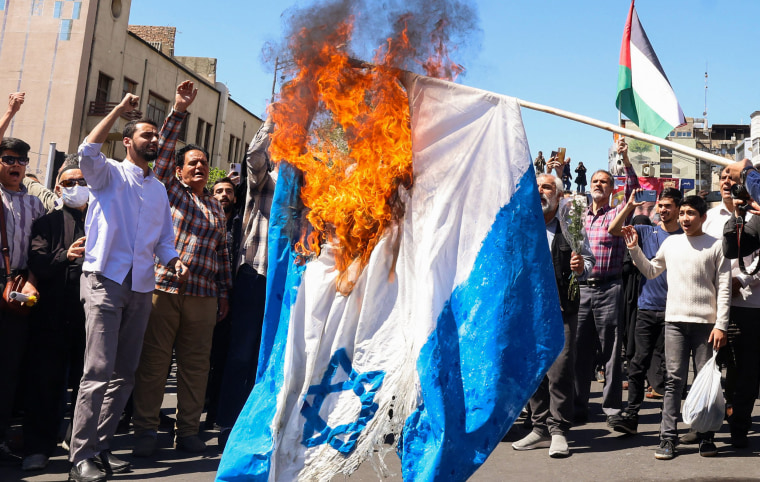
Former Guard commander Mohsen Rezaei, commenting on the possibility of retaliation against Israel, said: “The decision has been made. It will definitely be implemented,” according to the semiofficial Tasnim news site.The funeral coincided with the annual Quds (Jerusalem) Day, during which Iran stages large state-sponsored pro-Palestinian and anti-Israel rallies nationwide.
The leader of the Palestinian militant group Islamic Jihad, Ziad al-Nakhala, took part in the Tehran rally, Iranian media reported.
Israel has 'no more excuses' on Gaza aid, Germany says
Andy Eckardt
MAINZ, Germany — Israel has "no more excuses" and must quickly implement its announcements on increasing the flow of aid into Gaza, Germany has said today.
In a post on X, German Foreign Minister Annalena Baerbock said: "The people of #Gaza need every aid package now. That is why we have worked hard to open the #Erez border crossing & the port of #Ashdod for aid deliveries. We expect the Israeli government to implement its announcements quickly. No more excuses."
Blinken welcomes new aid routes but says 'real test is results'
Abigail Williams
Secretary of State Antony Blinken has said that the U.S. welcomes Israel's decision to allow more humanitarian aid into Gaza, but cautioned that true success would be an improvement in the situation on the ground.
“These are positive developments but the real test is results. And that’s what we’re looking to see in the coming days. And in the coming weeks,” he said, speaking alongside European Union leaders in Belgium.
"Is the aid effectively reaching people who needed throughout Gaza? Are the bottlenecks and other delays at crossings being resolved? Do we have a much better system for deconfliction and coordination so that the humanitarian workers, the folks who are delivering the aid can do it safely and securely?" Blinken said.
He added that these aims would be measured by clear metrics “like the number of trucks that are actually getting in on a sustained basis,” and the quantity of aid making to those in need in Gaza, “including critically northern Gaza" where he said "almost 100% of the population is acutely food insecure" and there are "10 indicators of potential famine."
Blinken was speaking prior to the release of the findings in the IDF's probe into this week's deadly aid convoy strikes.
U.N. human rights body calls for halt to weapons shipments to Israel
The Associated Press
The U.N.’s top human rights body has called on countries to stop selling or shipping weapons to Israel in a resolution that aims to help prevent rights violations against Palestinians amid Israel’s military campaign in Gaza.
The Human Rights Council, which has 47 member countries, voted 28-6 in favor of the resolution, with 13 abstentions.
Western countries were divided. The U.S. and Germany opposed the resolution, France and Japan abstained, while Belgium, Finland and Luxembourg voted in favor.
Kirby: U.S. 'will have to make meaningful changes' in Gaza policy if Israel doesn't
Israel has "got to be more precise" and "more careful" in its operations in Gaza to retain U.S. backing, White House National Security Council spokesperson John Kirby said this morning.
The way U.S. weapons are being used by its ally "absolutely matters," he told “TODAY” after what he said was a "frank" phone call between Biden and Netanyahu.
“If we don’t see meaningful changes in their policy, we will have to make meaningful changes in our policy,” Kirby said, adding that Washington would continue to support Israel generally, especially in light of the threat from Iran.
He said that the administration would have to “reserve judgment” until it can take a look at the findings from the IDF probe into the aid convoy strikes and weigh whether an independent investigation might be warranted.
Kirby said that hostage negotiations will be restarting this weekend in Cairo and that Biden had urged Netanyahu to send a delegation to join those talks in the Egyptian capital.
World Central Kitchen demands independent commission, says IDF 'cannot credibly investigate its own failure in Gaza'
Victoria Di Gioacchino
World Central Kitchen has responded to the findings of the IDF probe into the killing of seven of its aid workers, saying that Israel's military had taken "important steps forward" but that its apologies will be "cold comfort" for the victims' families.
The charity said that it is demanding "the creation of an independent commission to investigate the killings of our WCK colleagues," adding that "The IDF cannot credibly investigate its own failure in Gaza."
The disaster relief group's founder, José Andrés, said: “It’s not enough to simply try to avoid further humanitarian deaths, which have now approached close to 200." He added: “All civilians need to be protected, and all innocent people in Gaza need to be fed and safe. And all hostages must be released.”
“Their apologies for the outrageous killing of our colleagues represent cold comfort,” the charity's CEO Erin Gore said. “It’s cold comfort for the victims’ families and WCK’s global family.”
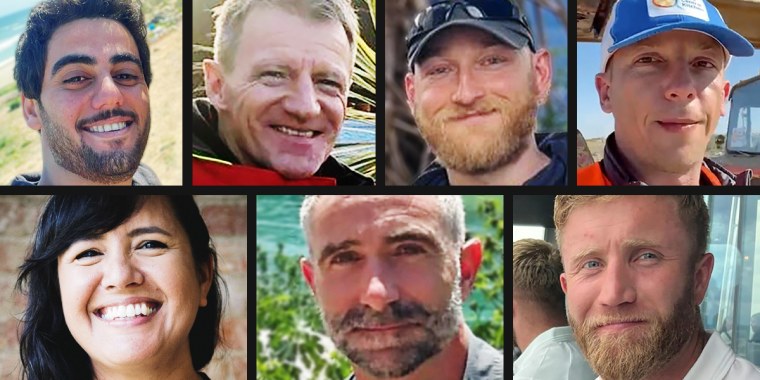
World Central Kitchen also said in its statement this morning that:
"The IDF has acknowledged its responsibility and its fatal errors in the deadly attack on our convoy in Gaza. It is also taking disciplinary action against those in command and committed to other reforms. These are important steps forward."
"However it is also clear from their preliminary investigation that the IDF has deployed deadly force without regard to its own protocols, chain of command and rules of engagement. The IDF has acknowledged that our teams followed all proper communications procedures. The IDF’s own video fails to show any cause to fire on our personnel convoy, which carried no weapons and posed no threat."
"Without systemic change, there will be more military failures, more apologies and more grieving families."
"The root cause of the unjustified rocket fire on our convoy is the severe lack of food in Gaza. Israel needs to dramatically increase the volume of food and medicine traveling by land if it is serious about supporting humanitarian aid."
"Food is a universal human right. WCK is proud to have fed families across Israel after October 7, and we continue to demand the release of all hostages.. At the same time, we believe Palestinian families have the same universal right to food, water and medicine. We know Israelis, deep down, share the same values."
"Israel needs to take concrete steps to assure the safety of humanitarian aid workers. Our operations remain suspended."
Israeli military releases findings from probe into aid convoy strikes
The Israel Defense Forces has released the findings from its own investigation into the strikes that killed seven World Central Kitchen aid workers in Gaza earlier this week.
The findings were presented yesterday to the IDF chief of general staff, Lt. Gen. Herzi Halevi. The IDF has dismissed two officers from their positions, reprimanded two commanders and reprimanded the senior commander responsible, it said in a statement this morning.
"The investigation’s findings indicate that the incident should not have occurred. Those who approved the strike were convinced that they were targeting armed Hamas operatives and not WCK employees. The strike on the aid vehicles is a grave mistake stemming from a serious failure due to a mistaken identification, errors in decision-making, and an attack contrary to the Standard Operating Procedures," it said.
The incident has fueled calls for an independent probe and demands from the U.S. that Israel do more to allow aid into Gaza and protect humanitarian workers.
The IDF said that the investigation "found that the forces identified a gunman on one of the aid trucks, following which they identified an additional gunman. After the vehicles left the warehouse where the aid had been unloaded, one of the commanders mistakenly assumed that the gunmen were located inside the accompanying vehicles and that these were Hamas terrorists."
The statement added: "The forces did not identify the vehicles in question as being associated with WCK. Following a misidentification by the forces, the forces targeted the three WCK vehicles based on the misclassification of the event and misidentification of the vehicles as having Hamas operatives inside them."
Iran mourns Revolutionary Guard members killed in Syria strike
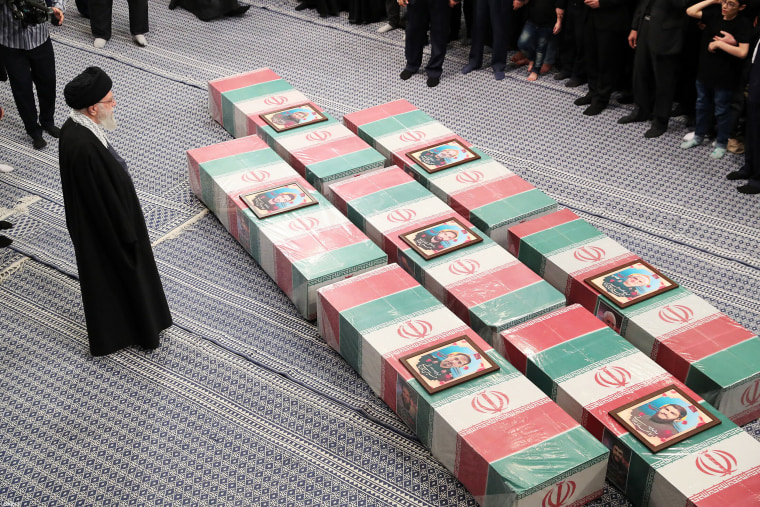
Supreme Leader Ayatollah Ali Khamenei prays over the coffins of seven Revolutionary Guard Corps members in Tehran yesterday, after they were killed in a strike on the country’s consular annex in Damascus, Syria. He joined mourners to share his grief over the deaths, which Iran has blamed on Israel, ahead of funerals taking place in Tehran today.
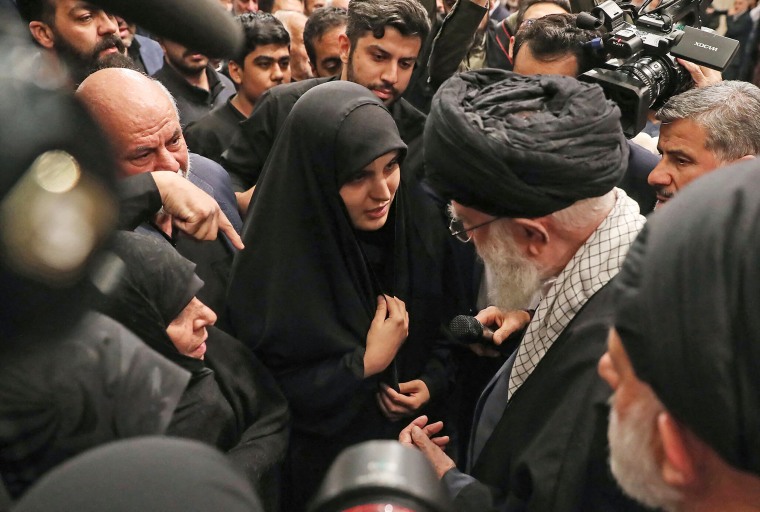
Israel to open more aid routes to Gaza and increase deliveries after pressure from Biden
Rebecca Shabad is in Washington, D.C.
Carol E. Lee Carol E. Lee is the Washington managing editor.
Peter Alexander
Monica Alba
Allie Raffa
Courtney Kube
WASHINGTON — Israel has committed to opening additional aid routes to allow for increased assistance to flow into Gaza after a call with Biden warning of a potential shift in U.S. policy after strikes this week killed seven World Central Kitchen aid workers.
White House National Security Council spokesperson Adrienne Watson said after the call that Israel had committed to opening the Ashdod port to allow assistance to be directly delivered into Gaza, opening the Erez crossing to let aid flow into north Gaza and significantly boosting deliveries from Jordan.
“As the President said today on the call, U.S. policy with respect to Gaza will be determined by our assessment of Israel’s immediate action on these and other steps, including steps to protect innocent civilians and the safety of aid workers,” Watson said in a statement.
Read the full story here.
Catch up with our latest coverage of the war
- World Central Kitchen aid worker’s family calls for an independent probe into the deadly attack
- Class destroyed: The rise and ruin of Gaza's revered universities
- Top Israeli official Ron Dermer began yelling during a meeting with U.S. officials about Gaza, officials say

COMMENTS
Here are 10 historically significant WWII sites to see in Germany: 1. Vorbunker/Führerbunker -Berlin. Vorbunker and Führerbunker were once the places where Adolf Hitler took shelter and eventually lived. The elaborate underground concrete bunker complex was designed to be a temporary air-raid shelter for Hitler, his family and his guards.
Since the end of the Second World War the German government, the Bavarian state, and the Nuremberg city authorities have all grappled with the challenge of what to do about these remaining infrastructures from the Nazi past. Visit information: Address: Bayernstraße 110, 90478 Nürnberg, Germany. Hours: 9AM-6PM.
In the city forest of Augsburg are oval, artificial ponds formed from a World War II bombing campaign. Discover 79 world war II in Germany. Atlas Obscura is your guide to the world's hidden wonders.
4. Site Of Hitler's Bunker. When visiting Berlin, the site of Hitler's bunker is a must-see.In the final days of the war in Europe, Adolf Hitler, his mistress Eva Braun, and members of the Nazi inner circle retreated to an underground bunker in Berlin. The former air raid shelter served as their final headquarters.
Nuremberg wasn't just the site of evil. It also helped bring justice to the evil doers during the Nuremberg Trials. From November 1946 to October 1946, Courtroom 600 was where the Allies put Nazi henchmen on trial for war crimes and crimes against humanity. It was a symbolic end to Nuremberg's Nazi ties.
This was the ceremonial recognition of complete defeat and victory over Hilter's regime. The Museum Berlin-Karlshorst (formerly called the German Russian Museum) isn't so centrally located, but it's a significant place to visit for World War II history in Berlin. Location: Zwieseler Str. 4, 10318 Berlin.
Private Berlin Third Reich Bike Tour World War Sites & History. This tour is not for the quick and easy. This comprehensive tour spans over a large area of the city and is built for history buffs and those with a keen interest. The tour is lead by professionals and visits many of the most notable World War II sites in Berlin.
10: Anhalter Bahnhof. A relatively hidden site, Anhalter Bahnhof is one of the best places to get up close to the ruins of Hitler's Third Reich. Constructed in 1841, Anhalter bahnhof was Berlin's largest and most opulent train station. With 44,000 passengers passing through the station each day.
Located just north of Berlin, Sachsenhausen Concentration Camp was one of the most notorious Nazi camps. Tens of thousands of Jewish people died at Sachsenhausen-Oranienburg before the camp was liberated on April 22, 1945. Today, the area serves as a museum and war memorial site with a library, archive, and open-air exhibition.
Ashley is a World War II historian and travel expert who has visited 32 countries. She specializes in quick trips throughout Europe and the Americas with a focus on World War II museums, memorials, battlefields, and other sites of interest. Originally from Memphis, TN, she currently lives in Boston with her husband and two feline commanders.
World War II Sites in Germany - Germany Travel Recommendations from Viator.com
Get Started. History buffs will love this 10-day journey through Germany, which covers many key places affected by World War II. Begin in Berlin, where the Third Reich's impact comes to light at the Reichstag and the Soviet War Memorial. Witness wartime destruction and rebirth in Dresden, gain insight into the.
Get information on Germany - World War II Sites | Fodor's Travel Guide - Expert Picks for your Vacation hotels, restaurants, entertainment, shopping, sightseeing, and activities. Read the Fodor's ...
2. Reichstag Building. The Reichstag Building, home to the German Parliament, played a significant role during World War II. It was severely damaged during the war but was reconstructed and now represents the reunification of Germany. Visitors can take guided tours of the building and even access its iconic glass dome, offering stunning views ...
Whether you're a history enthusiast or simply curious about the period, this guide will help you navigate through some of the most significant WW2 sites in Berlin. 1. Brandenburg Gate. The Brandenburg Gate is not only a symbol of Berlin but also played a crucial role during WW2.
Many people do not realize that Hannover was demolished in World War II, being one of the most destroyed cities in Germany. The Weimar Republic ended once Hitler became of the Chancellor of the Reich on January 30, 1933. During the war, 88 air raids destroyed over fifty-percent of the city, with over 90% of the downtown destroyed.
Travelers interested in World War II history will benefit from guided excursions through some of Germany's most interesting and infamous cities and sites. This weeklong itinerary starts in Berlin, where you'll learn how the Third Reich made their mark. From here, take a train to Dresden, a city rebuilt from destruction, and Nuremberg, full of medieval charm and 20th-century horror. Finish with ...
So for all the history buffs out there, here are 15 sites significant to the Second World War that, ranging from inspirational to overwhelming, are worth visiting in Europe: 15. Sachsenhausen Concentration Camp, Germany. This work camp just outside of Berlin is found about three km from the location of the first ever Nazi concentration camp ...
Located just north of Berlin, Sachsenhausen Concentration Camp was one of the most notorious Nazi camps. Tens of thousands of Jewish people died at Sachsenhausen-Oranienburg before the camp was liberated on April 22, 1945. Today, the area serves as a museum and war memorial site with a library, archive, and open-air exhibition.
Tour Map. 16-day tour featuring Germany, Austria, Luxembourg, Belgium, Holland and France. Revisit the dramatic history of World War II at famous battle sites, war museums and memorials. Many scenic and cultural highlights are also included, providing an enjoyable combination of learning and leisure. 2024 Departure Dates.
Normandy Beach - Normandy, France. Normandy Beach, where the infamous D-Day invasion took place, is easily one of the most significant World War II sites. The objective of the mission, known as Operation Neptune, was to open a second front opposite the Russians in the East to put more pressure on the Nazi German army.
W. World War II airfields in Germany (1 C, 18 P) World War II cemeteries in Germany (7 P) World War II memorials in Germany (2 C, 14 P) World War II museums in Germany (28 P) World War II prisoner-of-war camps in Germany (1 C, 75 P)
A roughly 1,000-pound American World War II aerial bomb is secured after being defused by specialists in a section of Amberg, Germany, Thursday, April 4, 2024.
World War II Sites in Germany - Germany Travel Recommendations from Viator.com. a Tripadvisor company. Search for a place or activity. Top Germany activities. Explore by category ... Private Walking Tour: World War 2 and Cold War Sites in Berlin. 130. Free Cancellation; English; 4 hours; from ₹13,786.58.
BERLIN -- Germany's defense minister on Thursday announced a plan to streamline and reorganize the country's military command as part of efforts to make the armed forces of NATO's most populous ...
There were two German gun batteries built on the site during World War I.One was called Freya, the other Augusta. Both batteries held guns, observation bunkers, crew quarters and "all kinds of ...
Hamas attacked the Erez crossing, a checkpoint between Israel and northern Gaza on Oct. 7 and Israel has refused to reopen it since. The Israeli statement did not give a timing for when the ...
Iran has reiterated its vow to punish Israel for the attack on its consulate in Syria earlier this week that killed a number of senior military commanders. "No act of the enemy against the ...